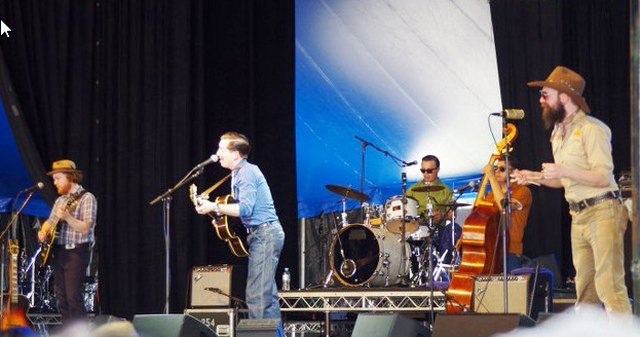Aziza - Aziza
Elliot Galvin Trio - Punch
Paul Grabowsky, Wilfred Brothers and Monash Art Ensemble - Nyilipidgi
Divergence Jazz Orchestra - Fake it Until you Make it
Brad Mehldau Trio - Blues and Ballads
Kristin Berardi Band - Just as You Are
Brenton Foster - Two Cities
Andrea Keller and Tim Wilson - Consider This
Tony Gould and Mike Nock - The Monash Sessions
Jeremy Rose and The Earshift Orchestra - Iron in the Blood
Paul Williamson Quartet - Live at Uptown
Tim Garland - One
Jazzgroove Mothership Orchestra - Fiddes vs Tinkler
Julius Schwing TrioB - Edge 2:isthmus
Alex and Nilusha - Afterglow
ATM15 - Human Music
Will Vinson - Perfectly Out of Place
Jason Rebello - Held
Tim Jones - Strangely Beautiful
Brad Mehldau - Blues and Ballads
Brad Mehldau - 10 Years Solo Live
The Robert Glasper Experiment - Miles Davis - Everything’s Beautiful
Simon Vincent's The Occasional Trio - Opening Lines
Casey Golden Trio - Miniature
ATM15 - Human Music
Carl Orr - Forbearance
Francesca Prihasti - Evolving
Phronesis - Parallax
Sonic Mayhem Orchestra - Live Mayhem
Florian Hoefner Group - Luminosity
Ingrid James and Alexis Tcholakian Trio - Trajectoire
BluesFest2016
Myra Melford and Ben Goldberg - Dialogue
Jeremy Sawkins' Organ Quartet - Artefact
Ben Winkelman Trio - The Knife
Dave Douglas and Monash Art Ensemble - Greenleaf Music
Ravi Coltrane
Hi(gh) Curious - Eugene Ball 4tet
Gerard Presencer and Danish Radio Big Band - Groove Travelers
Bungalow - Unseen Scenes
Robin Eubanks's Mass Line Big Band - More than Meets the Ear
Mike Nock and Laurence Pike - Beginning and End of Knowing
2015 ARCHIVES:
Jeremy Rose Quartet - Sand Lines
Chris Cody - Not My Lover
Stu Hunter - The Migration
David Ades - A Life in a Day
Kristin Berardi - Where or When
Jeff 'Tain' Watts - Blue Vol 1
Nick Freer - The Unsuspecting
Joshua Hatcher - Now and Then
Paul Grabowsky and Niko Schauble - Spiel
Paul Grabowsky and Vince Jones - Provenance
Tim Garland - Return to the Fire
Eternal - Chris McNulty
Frances Madden - If This Were a Dream
Orbiturtle - Sakura (Studio Songs
Cecile McLorin Salvant - For One to Love
Sydney Jazz Orchestra - Nothing Personal
James Whiting - Hard mince
Gary Daley - Sanctuary
Aaron Diehl - Space Time Continuum
Tim Willis and The End - Night and Day
Robert Burke - Power of the Idea
Joshua Redman - The Bad Plus
Tim Stevens - I’ll Tell You Later
Barney McAll - Mooroolbark
Angela Davis Quartet and Strings - Lady Luck
Geoff Kluke - Valley Road
John Raymond - Foreign Territory
Mike Nock and Roger Manins - Two-Out
Juliana Areias - Bossa Nova Baby
Allan Browne Quintet - Ithaca Bound
Francesca Prihasti - Night Trip
Myra Melford - Snowy Egret
Chris Potter Underground Orchestra - Imaginary Cities
Casey Golden Trio - Outliers
Jack DeJohnette - Made in Chicago
BluesFest 2015
Joe O’Connor Trio - Praxis
Matt McMahon - The Voyage of Mary and William
Vijay Iyer Trio - Break Stuff
Kenny Wheeler - Songs for Quintet
Tate Sheridan - Tate Sheridan
Nic Vardanega Quartet - Inverno
Penelope Sai - Some Kind of Dream
Marc Hannaford - Can You See With Two Sets of Eyes
Rafael Karlen - The Sweetness of Things Half Remembered
Ben Gurton Quintet - Prelude to a Scene
Josh Kyle and Sam Keevers - Songs of Friends
Tim Garland - Songs to the North Sk
Slowly Rolling Camera - Into the Shadow
Verneri Pohjola - Bullhorn
RichardHavers - Uncompromising Expression
2014 ARCHIVES:
Allira Wilson - Rise and Fall
Mark Turner Quartet - Lathe of Heaven
Paul Grabowsky - Solo
BLOW - Presence
Frode Haltli - Vagabonde Blu
Magnusson, Oehlers, Vanderwal - Paper Tiger
Calum Builder and Tate Sheridan - In Hiding
Mark Turner Quartet - Lathe of Heaven
Shol - Shol
Mike Nock Octet - Suite Sima
The Bad Plus - Inevitable Western
Wangaratta Jazz & Blues Festival 2014
Alex and Nilusha - Tales to Tell
Robert Burke with Kenny Werner - Do True
Kavita Shah - Visions
Keith Jarrett and Charlie Haden - Last Dance
Song Fwaa - Songs of No Guns For We Are Anomalous
Henri Peipman - 30. Detsember
Mathew Sheens - Untranslatable
Hammerhead - Mozaic
Penny King Quintet - Journey
Adrian Cunningham - Ain’t that Right! The Music of Neal Hefti
Tom Barton - Aspirations
Jex Saarelaht Trio - Liminal
The Hunters and Pointers - The Hunters and Pointers
Melissa Oliveira - In My Garden
Gwilym Simcock - Instrumation
Daniel Susnjar - Su Su Nje
Kim Lawson Quartet - Hey Day
The Nexus Project - First Light
Melbourne International Jazz Festival May 30–June 8, 2014
Java Quartet - Together
Paul Grabowsky Sextet - The Bitter Suite
Dizzy Gillespie - The Champ
Robert Davi - Davi Sings Sinatra
Eric Starr Group - Such is Life
BluesFest 2014
Sam Bates Trio - Backblocks
Ben Panucci Trio - Short Stories
James Greening - Greening From Ear to Ear, Tam O’Shanter Tales
Alex Stuart - Place to Be
Tilman Robinson - Network of Lines
Eamon Dilworth - Tiny Hearts
Bob Venier - Discovering You
Brendan Clarke - Stretch
Julian Curwin - The Mango Balloon Volume 3
Daniel Hunter - The Twentieth
Mike Rivett - Digital Seed
Quentin Angus – Perception
Alfredo Rodriguez - The Invasion Parade
Danilo Perez - Panama 500
Joe McEvilly with Movement 9 - Wings
Anton Delecca Quartet - The Healer
Sam Anning Trio - Sweethearts
Chet Baker - The Italian Sessions
Dexter Gordon - Blows Hot and Cool
Curtis Counce - Complete Studio Recordings
Peggy Lee - Mink Jazz
Lou Donaldson - Midnight Creeper
Ahmad Jamal - It’s Magic
Chris Poulsen Trio - David and Goliath
Anton Delecca Quartet - The Healer
Ross McHenry - Distant Oceans
Scott Hamilton and Dusko Goykovich - Tight But Loose
Elodie Sablier - Vertigo
Celine Rudolph - Metamorflores
Dusko Goykovich - 5ive Horns & Rhythm
Dusko Goykovich1 - Sambo Do Mar
Dusko Goykovich2 - Samba Tzigane
Red Prysock - The Best of Red Prysock
Scott Hamilton - Swedish Ballads
Pee Wee Ellis - Tenoration
Andrea Keller Quartet with Strings - Wave Rider
Divergence Jazz Orchestra - The Opening Statement
Paul Williamson - Connect Four
2013 ARCHIVES:
Janet Seidel and Friends - Far Away Places
Julien Wilson Quartet - This is Always; Swailing
Monash Art Ensemble (Australian Art Orchestra and Sir Zelman Cowen School of Music)
Simon Thacker's Svara Kanti - Rakshasa
Todd Hardy - Swings and Roundabouts
Captain Kirkwood - Theseus and The Minotaur
Wangaratta Jazz & Blues Festival 2013
Adam Katz - Adam Katz
Resurgence - Duende
States of Play - States of Play
Monash students & overseas artists. The Monash Sessions
Compass Quartet - Oneirology
Keith Jarrett Trio - Somewhere
Hannaford Tinkler and Barker - Faceless Dullard
Steve Newcomb Orchestra - Caterpillar Chronicles
The Vampires - Tiro
The New Cabal
Jonathan Zwartz - The Remembering & Forgetting of the Air
Angela Davis - The Art of The Melody
Yitzhak Yedid - Suite in Four Movements
Paper Plane
Leigh Carriage - Mandarin Skyline
Melbourne International Jazz Festival May 31-June 9 2013
Monique DiMattina - Nola's Ark
Tom Vincent Quartet - Just Enough
Tomasz Stankos New York Quartet - Wistawa
Neil Cowley Trio - The Face of Mount Molehill
Charles Lloyd and Jason Moran - Hagar’s Song
Cecile McLorin Salvant - Woman Child
The catholics - Yonder
Origami - Karaoke
Origami - The Usefulness of Art
Mike Nock and Howie Smith - Opal Dream
BLOW - Empathy
Kjetil Moster - Moster! Edvard Lygre Møster
Edouard Bronson - Intimate
Alex Stuart - Around
Jess Greens Bright Sparks - Tinkly Tinkly
Charmaine Jones and Mike Bevan - Still
Trichotomy - Fact Finding Mission
Phronesis - Walking Dark
Steve Barry - Steve Barry
Alister Spence Trio - Far Flung
Chris Potter - The Siren
Matthew Sheens - Every Eight Seconds
Marialy Pacheco - Spaces Within
Joseph Tawadros - Chameleons of the White Shadow
Ted Vining Trio - Live at PBS FM 1981
Nostalgia 77 - The Sleepwalking Society
Wayne Shorter - Without A Net
Dave Jackson Quartet - Cosmontology
Bobo Stenson Trio - Indicum
Wangaratta Jazz & Blues Festival 2012
Daramad - Daramad
Penelope Sai - Siana
John Surman - The Rainbow Band Sessions
Murphy's Law - Big Creatures and Little Creatures
Slumgum - The Sky his Own
2012 ARCHIVES:
Gregg Arthur - Unforgettable – A Portrait of Nat ‘King’ Cole
Conly, Harding, Jones, Taylor - Grass Roots
Mace Francis New York Nonet - Land Speed Record
Magnet - Magnet
Willow Neilson - Lightbulb Life
Wangaratta Jazz & Blues Festival
Moskus - Salmesykkel
Marc Johnson and Eliane Elias - Swept Away
The Andy Sugg Group - The Berlin Session
Abel Cross Quintet - Neo Bop
Diana Krall - Glad Rag Doll
Divergence Jazz Orchestra- Live at the Bald Faced Stag 29/7/12
Seaman Dan - Sunnyside
Sean Wayland - Slave to the Machine (Volumes 1 & 2)
Logic Live (Double DVD/CD)
Mike Nock and Laurenz Pike - Kindred
James Carter - After All
Tony Gould and Peter Petrucci - The Journey Home
Matthias Schriefl - Six, Alps & Jazz
Simcock, Garland, Sirkis - Lighthouse
Jacam Manricks - Cloud Nine
Sarah McKenzie - Close Your Eyes
Bernie McGann - Wending
Craig Scott Quintet - Timeline
Marialy Pacheco 11th August 2012 – Coffs Harbour
Phil Treloar - Of Other Narratives - tracings in the ground of. Collective Autonomy / Volume 3 - Primal Communication
Mike Stern - All Over the Place
Neneh Cherry and The Thing - The Cherry Thing
John Abercrombie Quartet - Within a Song
Josh Kyle - Possibilities
John McAlls Black Money - Alter Ego
Peter J Martin - Waltz for the Wicked
Lily Dior - Let's Talk About It
Wayne Krantz - Howie 61
Motion - The Drowned World
Renaud Garcia-Fons - Solo – The Marcevol Concert
Tim Stevens - Life's Undertow
Guy Strazz Quartet - Eastern Blues
Melbourne International Jazz Festival 2012
Daimon Brunton Quintet - Wha Sa Live
Tim Willis and The End - Keep Your Chin Up
Tim Clarkson - Evolution of Beauty
Vijay Iyer Trio - Accelerando
Esbjorn Svensson Trio - 301
Phronesis - Walking Dark
Melody Gardot - The Absence
Tony Gorman - Tony Gorman's Monday Club
Barney McAll - Graft
Skii Harvey - Bound by History
Sandy Evans and Friends with Guru Kaaraikkudi Mani and Sruthi Laya - Cosmic Waves
Buck Clayton - The Complete Legendary Jam Sessions: Master Takes
Dick Hyman Trio - You're My Everything
Trombone Shorty - For True
Jens Thomas - Speed of Grace
Ben Hauptmann - Yum Yum Tree RecordsCC
David Murray Octets - The Complete Remastered Recordings on Black Saint
Galaxstare - A Time, Times and Half a Time
David Ades & Friends - A Glorious Uncertainty
Tal Cohen Quartet - Yellow Sticker
Alfredo Rodriguez - Sounds of Space
Alex Pertout and Nilusha Dassenaike - Moments in Time
2011 ARCHIVES:
Benjamin Sanz Quintet - Mutation Majeure
Houston Person - So Nice
Compass - Ode to an Auto Rickshaw
The Vampires - Garfish
Charmaine Jones and Mike Bevan - A Small Hotel
Slide Albatross
Marc Hannaford - Ordinary Madness (Quintet) and Sarcophile (Trio)
Dave Brubeck Quartet - Their Last Time Out
Nicki Parrott - Can't Take My Eyes Off You
Keith Jarrett - Rio
Nick Haywood Quartet - 1234
Kellylee Evans - Nina
Ella Fitzgerald - S'Wonderful: Ella in Japan
Liam Burrows With John Morrison's Swing City - All of Me
Michael Feinstein - The Good Life: The Sinatra Project, Volume Two
Gadjo Guitars - L'Amour En Douce
Bridie King - Blue Ivories
Andy Sheppard, Michel Benita and Sebastian Rochford - Trio Libero
Maggie Britton - Ditto – Songs for Alexander
Christian McBride - Conversations with Christian
Phil Treloar - Of Other Narratives
Jeff Riley - Jazz Suite
Quentin Angus Quintet - Retrieval Structure
Robert Burke, Tony Gould, Tony Floyd and Nick Haywood - Live at Bennett's Lane
Mike Nock Trio Plus - Hear and Know
Peter Knight - Fish Boast of Fishing
Marialy Pacheco - Songs that I Love
Bucky and John Pizzarelli - Generations
Emma Grace Stephenson - Jazz Workshop AustraliaCC
Warren Vache and Bill Charlap - 2gether
Ella Fitzgerald - Live at Mister Kelly's
Cedar Walton - Voices Deep Within
Samurai Spirit - Ganbare Nippon
Warren Wolf - WW
Ella Fitzgerald - Best of the BBC Vaults
Rebecca Kilgore with Harry Allen Quartet - Live at Feinstein's: Celebrating Lady Day and Prez
Nick Hempton - The Business
James Whiting - Burbank
Keith Jarrett - Rio
Compass Quartet - Ode to an Auto Rickshaw
Darius Jones Trio - Big Gurl [Smell My Dream]
Memory of Elements - MoE
Laura Fygi - The Best is Yet to Come
"Buck" Pizzarelli and the West Texas Tumbleweeds - Back in the Saddle Again
Dave Ades & Friends @ Venue 505 (9/11/2011)
Wangaratta Festival of Jazz 2011
Sean Jones - No Need for Words
Peter Knight and Dung Nguyen - Residual
Takadimi - New Common Sense
Ingrid James & The Global Collective - Pangaea
Origami Trio - The Blues of Joy
The Andrew Dickeson Quintet - Weaver of Dreams
The Paul McNamara Trio - IndependentCC
Karrin Allyson - Round Midnight
Nicki Parrott and Ken Peplowski - Like a Lover
Rossano Sportiello Trio - Lucky to be Me
Stan Getz - The Clef and Norgran Studio Albums
Sherrie Maricle and The DIVA Jazz Orchestra - Johnny Mandel: The Man & His Music
Leonie Cohen Trio - Sideshow Pony
Cedric Hanriot - French Stories
Laura Kahle - Circular
Lee McAllistair - Spellbound
Adrian Cunningham - Walkabout
Sandy Evans Sextet - When the Sky Cries Rainbows
Mace Francis Orchestra - Chinese Whispers IV
Katie Noonan Elixir - First Seed Ripening
Matt Keegan Trio - Meets David Ades
Harold Lopez-Nussa Trio - El Pais de las Maravillas
Dan Barnett - Somewhere, Some Place, Some Time
Scott Hamilton and Rossano Sportiello - Midnight at Nola's Penthouse
Bill Charlap - I'm Old Fashioned
Duke Ellington - The Great Concerts: London & New York 1963-64
Melbourne International Jazz Festival 2011
Howard Alden - I Remember Django
Elly Hoyt - Pinnacle
Sarah McKenzie - Don't Tempt Me
Jeremy Pelt - The Talented Mr Pelt
My Goodness McGuiness - Insular Peninsula
Pascal Schumacher Quartet - Bang My Can
Browne, Hannaford, Anning - Shreveport Stomp
Cameron Earl Quartet - Run Run
Daniel Gassin Sextet - Which Way
Fran Swinn Trio - Every Dog
Joachim Kuhn, Majid Bekkas and Ramon Lopez - Chalaba
Portico Quartet - Knee-deep in the North Sea
Matt Baker - Underground
Luke Howard and Janos Bruneel - Open Road
The End - The End
Jason Moran and The Bandwagon - Ten
Briana Cowlishaw - When Fiction Comes to Life
Art Tatum - Solo Masterpieces
Allan Vache - Look To The Sky
Jacam Manricks - Trigonometry
Quinsin Nachoff - Forward Motion (FoMo)
Song Fwaa - Ligeti's Goat
Jane Monheit - Home
Bill Allred Featuring John Allred - The New York Sessions
Duke Ellington - From His Treasure Chest 1965-72
David Klein Quintet - My Marilyn
3ofMillions - Abstruction
BluesFest 2011
Amphibious - Alive & Breathing
Jane Irving - Beams
Tim Stevens Trio - Scare Quotes
James Osborne Jazz Collective - Playtime
Renaud Garcia-Fons - Mediterranees
Mark Isaacs's Resurgence Band - Aurora
Nicki Parrott - Black Coffee
"Buck" Pizzarelli and the West Texas Tumbleweeds - Diggin' Up Bones
Lew Soloff and Steve Richman - Sketches of Spain
2002-2010 ARCHIVES
|
Reviews
 
 
 -
masterpiece, -
masterpiece,
 
 -
excellent, -
excellent,
  - good
- good
 - fair, - fair, - poor - poor
To Search for reviews - Key CTRL+F and artist or album name
|  | Aziza - Aziza (Dare2 Records)
|
This quartet is comprised of four stellar US musicians, all bandleaders,
and each at the very top of their abilities, working beautifully
together. The New York recording contains eight tracks featuring
originals by each band member. In addition to saxophonist Chris Potter
and guitarist Lionel Loueke, Dave Holland — Dare2 label owner — is on
bass and Eric Harland on drums. The album title comes from Loueke’s
native Benin, in Africa, where Aziza is the god of inspiration
The guitarist has forged a unique bridge between Benin’s musical
traditions and his highly individual take on contemporary jazz. The
opener, Loueke’s Aziza Dance, begins with a jazz-rock beat and inventive
wah-wah guitar, before Potter’s theme establishment and right-on-the
beat improv. That’s followed by Holland’s bass solo and the track
concludes with Harland’s always inspired drum work
A walking bass could be expected in Holland’s Walkin’ the Walk and that
bass line is certainly included, but there’s a lot more virtuoso bass
work here along with Potter’s tenor sax and Harland’s driving rhythms
and punctuations. Potter’s Blue Sufi opens with the sax playing a theme
statement and solo, gradually assisted by the entire group as sax lifts
off and guitar opens a repetitive chord sequence, mixing with hyper-busy
drums to introduce the guitar’s quickening passage and Potter’s
fast-moving conclusion
The final track, Sleepless Night, an insistent, force-driven piece by
Loueke, features the guitarist’s overdubbed vocals in addition to his
energetic instrumental unison with the sax. These four names will
probably be sufficient to invite a listening for jazz fans where the
spectrum of emotion and diversity of approach is bound to secure interest
    
|
John McBeath
Previously published in The Australian Dec 2016 |
| Back to Index |
| 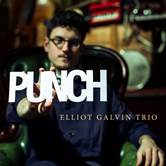 | Elliot Galvin Trio - Punch (Edition)
|
Pianist Elliot Galvin is one of the rising stars of UK Jazz, and this is his second album, following Dreamland released in 2014, the year he won the German award Young Jazz Artist of The Year. There are nine originals, and one deconstructed standard, Mack The Knife.
The music is highly original with an impossibly wide range of influences from Keith Jarrett to Stravinsky, and Galvin plays an amazing range of instruments: piano, melodicas, kalimba. accordion, cassette player, and stylophone, a miniature analogue stylus-operated keyboard invented in 1967
Galvin's individual approach is introduced on the opening track, Punch and Judy, by an old recording of children at a Punch and Judy show which is quickly accompanied by the piano-led trio weaving through the continuing voices of the children with staccato interludes and alternating bouts of silence.
Drummer Simon Roth also adds glockenspiel, and bassist Tom McCredie provides, on Lions, a fleeting impersonation of Slam Stewart's famous bass and vocal routine, as well as an impressive opening to 1666.
Closest to a pastoral track is Tipu's Tiger with its delicate piano and kalimba passages, while the only non-original is a dark and brooding interpretation of Mack The Knife using pulsating block piano chords and a variety of percussive effects.
A classical-style piano accompanied by whistling introduces Cosy which later breaks into a strong rhythmic section with a piano bass line reminiscent of Lady Madonna before wandering off and re-introducing a whistling conclusion.
Although this collection has many passages of familiar piano trio styles it also ventures into somewhat different approaches using an inventive idiosyncratic style, often displaying Galvin's wry sense of humour.
   
|
John McBeath
Previously published in The Australian Dec 2016 |
| Back to Index |
| 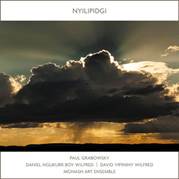 | Paul Grabowsky, Wilfred Brothers and Monash Art Ensemble - Nyilipidgi (ABC Jazz)
|
The best circumstance under which to listen to this album is in a live performance, but of course, opportunities for that are quite limited. I was fortunate to experience the work live at the 2016 Wangaratta Jazz Festival – where it achieved a standing ovation – and my opinion of it rose considerably.
Pianist/composer Paul Grabowsky began working with ceremonial musicians from Ngukurr, on the Roper River in South East Arnhem Land in 2004, and Nyilipidgi represents an apex of achievement where aspects of contemporary jazz are incorporated into Australian traditional music and vice versa.
Important contributions come from brothers Daniel Ngukurr Boy Wilfred – vocals and clapsticks (Bilma) and David Yipininy Wilfred on didjeridu (Yidaki) – whose traditional vocals, in song and story, with music are united in quite brilliant ways with jazz orchestrations and solos from members of the Monash Art Ensemble.
Indigenous aspects are displayed in all tracks. From the very beginning in The First Dance for example, clapsticks and chanting transmute via a violin and percussion passage into big band staccato chords and a soft conversation that fades to a conclusion.
Grabowsky has overcome the almost unimaginable challenge of this musical achievement without sacrificing aspects of either genre. The cover notes are useful in explaining and elaborating: 'Nyilipidgi does not attempt a superficial integration of differing traditions . . . that relegates music to the mere representation of style.'
What Grabowsky has achieved here is an original jazz symphony of monumental proportion utilising words, dances and songs (manikay) of the Wagilak clan somehow amalgamated with jazz influences in a quite moving original, musical landmark.
   
|
John McBeath
Previously published in The Australian Dec 2016 |
| Back to Index |
| 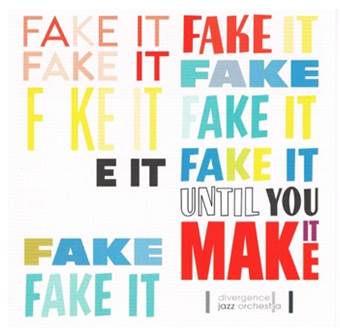 | Divergence Jazz Orchestra - Fake it Until you Make it (Independent)
|
The nineteen member Divergence Jazz Orchestra was formed in Sydney in 2012 by composer Jenna Cave and trombonist Paul Weber, releasing their debut album The Opening Statement to high acclaim in 2013
The new album continues the orchestra's goal to be a space where composers and musicians can come together, explore ideas, and make music. Describing their approach which includes the big band moving away from swing era styles, Cave – who's written six of the eleven tracks – observes that a modern jazz orchestra is an instrumentation rather than a group playing in a pre-prescribed fashion.
The opener On Horseback features trumpeter Will Gilbert with hints of Herb Alpert and The Tijuana Brass, but with a far more powerful ensemble arrangement, while the title track by trombonist Brendan Champion makes good use of repeated staccato notes as it develops a serious whole band groove driven by smart drumming from James McCaffrey.
A slower tempo pervades Miroslav Bukovsky's Peace Please with broadening harmonic colours from the ensemble and solos from Gilbert's flugelhorn, trombonist Tim Coggins and Andrew Scott's flowing piano.
One Woman's Day of Triumph, an earlier composition of Cave's, bounces with verve and tenacity and features Tim Clarkson's baritone sax solo followed by Luke Liang on guitar, as the ensemble develops a triumphant outburst and employs muted brass to good effect.
These numbers vary from a New Orleans sound mix to gospel ballads all tracks applying contemporary jazz ideas to a full sized big band with a freshness derived from today's musical landscape.
   
|
John McBeath
Previously published in The Australian Sept 2016 |
| Back to Index |
| 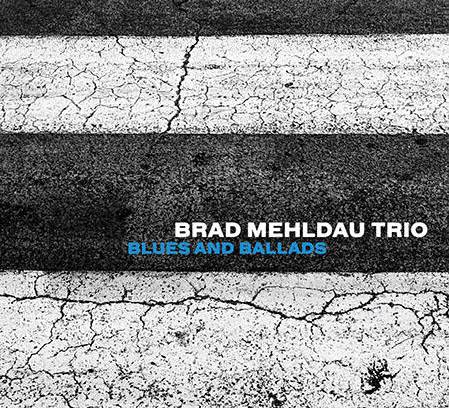 | Brad Mehldau Trio - Blues and Ballads (Nonesuch)
|
This release – the group's fifth – after the acclaimed album Where Do You Start, in 2012, from US pianist Brad Mehldau features the leader's preferred format: the piano trio. The music explores works by composers from Charlie Parker and Cole Porter to Lennon and McCartney.
It's a beautifully played, satisfying collection that displays Mehldau's brilliant ability for subtlety and understatement, ably assisted by long-term associates Larry Grenadier on bass, and Jeff Ballard on drums.
One track that encapsulates the overall mood is Jack Strachey's WWII ballad These Foolish Things where Mehldau extracts every nuance of nostalgia and emotion from the tune without a trace of cliché.
Cole Porter's I Concentrate on You flows along in an unhurried but highly expressive way, making use of stating the melody in the bass register.
The Blues are well represented by the opener, pianist Buddy Johnson's 1945 piece Since I Fell for You with its slow tempo, ten minute work-over of the twelve bar format, while Jon Brion's sad story Little Person is sensitively interpreted, adding Grenadier's contemplative bass solo.
The Beatles hit And I Love Her explores the repetitive phrasing of the original before drifting into a highly effective improvisation where extensive treble runs are countered by bass chord foundations, punctuated effectively by Ballard's kit.
Paul McCartney's My Valentine, the closer, is taken at about the same slow tempo as the original and in addition to Mehldau's out-of-tempo passage also features another perceptive solo from Grenadier.
This collection shows Mehldau's technical virtuosity, playing in a cut down style that gets right into the essential character of these songs.
   
|
John McBeath
Previously published in The Australian Sept 2016 |
| Back to Index |
|  | Kristin Berardi Band - Just as You Are (Independent/Planet)
|
A major problem for jazz vocalists is to find new performance material since all of the standard songs with the best music and lyrics have been recorded dozens of times, often by top vocalists.
On this album, the tenth from Brisbane-based, multi award-winning vocalist Kristin Berardi, she has tackled the problem of new material by writing nine of the eleven tracks herself.
An important contribution to the collection is the quality backing quartet from Sydney, led by pianist Greg Coffin, whose accompanying work and improvisations are major features
One of the non-originals is a swinging rendition of Just Squeeze Me where Coffin's piano solo plus Berardi's vocals, including occasional scat phrases, are underpinned by Carl Morgan's guitar passages and a thriving rhythm established by Brett Hirst's bass and Tim Firth on drums.
The other standard is the aching ballad Body and Soul, given ultra-slow treatment and a quite moving vocal interpretation recorded live at a concert performance.
The original pieces are mostly about romantic love and break-up; two exceptions are Sara's Sea Song with a lilting rhythm and mystical story and Mr Jackson, about an aging eccentric encountered in a laundromat.
One of the longer originals at seven and a half minutes, Better Day also has Berardi scatting, and a strong guitar solo, while a brisker tempo drives Memories of You despite its sad tale of a fractured relationship.
In most of its lyric content this album has an overall sad and doleful atmosphere, although the accompaniments are often sprightly. The ambience could have been lightened by a few brighter, more optimistic songs.
   
|
John McBeath
Previously published in The Australian Sept 2016 |
| Back to Index |
| 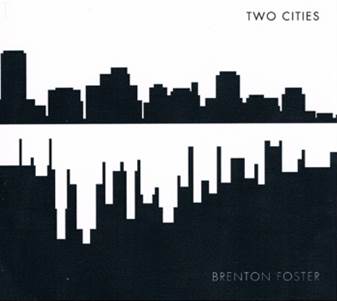 | Brenton Foster - Two Cities (Independent)
|
This robust collection of nine originals by Adelaide-born, now Melbourne-based pianist/leader Brenton Foster maps his travels throughout the USA. His Melbourne sextet was recorded partly in New York, finalised in Melbourne and was assisted by a Helpmann Academy grant. A promotional tour to Mt Gambier, Adelaide, and Melbourne commences Aug. 6th. The entitled 'Two Cities' are New York and Adelaide
The opener, Heller va Feller begins with Matt Clohesy's two-note bass riff and after Gideon Brazil's tenor sax theme statement underscored by Kenneth Salters's drum work and Foster's piano extension of the riff, the ensemble appears as the temperature reduces, and then builds again in Foster's solo, bursting into quick runs and chordal stabs
Shortest take is a one minute evocative theme, Rainy Nights in The East Village, while Hudson Fysh with its rapid staccato single note piano in trio format is a tribute to Sir Wilmot Hudson Fysh, early Australian aviator and founder of Qantas Airways
Piano takes the lead in all tracks and Foster's style is potent and vigorous with many notable solos, whether fronting the ensemble, or with just bass and drums; both formats are heard to good effect in Hostelity
One of two Adelaide-referred pieces is Stevens Street, where Foster says his sister lives and 'reflects the carefree and calm nature of the city's suburbs.' It does that very well with the piano moving against long held ensemble harmonies
The final cut, aptly named Disappearing, strides along building to Tom Jovanovic's trumpet farewell moving through the registers in a slightly bluesy way and an added running piano re-introduces the ensemble climbing energetically into a fade-out
   
|
John McBeath
Previously published in The Australian August 2016 |
| Back to Index |
| 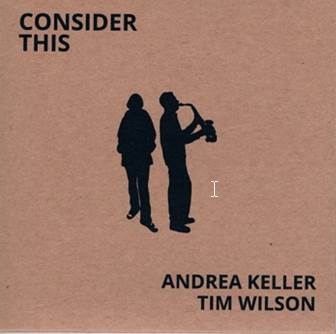 | Andrea Keller and Tim Wilson - Consider This (Independent)
|
Multi-award winning Melbourne based pianist Andrea Keller has appeared on more than two dozen recordings ranging from solo piano to large groups, and in 2008 she recorded the duo album Life That Lingers with saxophonist Tim Wilson. As with the previous recording, this new one was a live performance at Bennett's Lane in Melbourne
Both performers are accomplished composers and equally share credits across the seven tracks here. Their musical rapport is nothing short of extraordinary: both players utilise extensive classical influences in music that nevertheless maintains a jazz sensibility
The title track, by Wilson, opens with the alto sax's soaring theme that would not be out of place in a symphonic performance and Keller supplies the underlying harmonies
Life That Lingers from their earlier album – Keller's composition – is also included with the piano's arpeggio opening and later moves into a fast-running improvised sax passage
Another Keller original, All The Colours Grey opens with a saxophone cadenza of over four minutes, holding the attention with skilful variations in speed and tonality, and when the piano arrives it does so with out of tempo solo flourishes and imposing chords creating a stately atmosphere that continues when the saxophone rejoins to build to a thematic conclusion
Wilson's 'T' For Tango breaks out of its Latin rhythm for occasional sequences of almost unbearable fragility and deep sensuality and resumes with quick alto work over the piano's frenzied rhythms
This unique collection displays very high quality duo playing in unusual styles that successfully blend classical concepts with improvisation and jazz influences
   
|
John McBeath
Previously published in The Australian August 2016 |
| Back to Index |
| 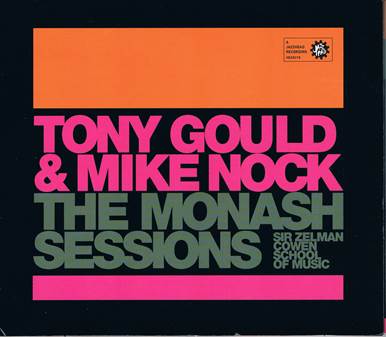 | Tony Gould and Mike Nock - The Monash Sessions (Jazzhead)
|
This album showcases two Australian jazz giants of piano, both solo and together, plus their appearances with three different groups of talented young musicians from the Sir Zelman Cowen School of Music
Both of the solo pieces – Tony Gould's Reflections and Mike Nock's Embracing You –are introspective originals, and the twin performance, Duality also floats serenely with an inner-directed harmonic approach where the twin pianos work comprehensively together
Transitions, the only track not at a slower tempo, has Nock fronting a quintet of students with Monash staffer Rob Burke on tenor sax providing a robust solo ahead of Nock's explorative investigation of the changes via running treble and stabbing chords ahead of a thoughtful bass passage from Angus Radley
Melanie Taylor sings a nostalgic introduction to Somewhere Called Home featuring Gould and an instrumental quartet, in a poignant ballad in three-four time with sensitive trombone and tenor sax pairings from Eleanor Lamb and Aidan Hodge
Nock heads a third group of five for the opener, Indifference using a repetitive lightly dancing motif over the ensemble spread, moving into staffer Paul Williamson's potent trumpet and Stephen Blyth's assertive tenor sax
Lamp is Low, based on Ravel's Pavanne, has a melodic intro from Burke's tenor with Niran Dasika's trumpet, adding Gould's motile piano underscoring and a fine guitar sequence from Dan Mamrot as the piece traverses a very listenable arrangement of this vaguely familiar theme
It's a varied collection of high quality playing of arrangements from two well-established pianists as well as younger groups of artists, in solo, duo and ensemble modes
   
|
John McBeath
Previously published in The Australian August 2016 |
| Back to Index |
| 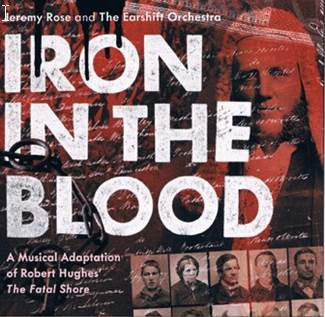 | Jeremy Rose and The Earshift Orchestra - Iron in the Blood (ABC/Universal Music)
|
This is an extensive work of broad musical, historical and narrative scope. It's a musical adaptation of Robert Hughes's iconic Australian historical work The Fatal Shore 1986, complete with narration by Philip Quast and William Zappa
Composer, conductor and saxophonist Jeremy Rose has orchestrated jazz-based music as exposition and ambience for this enormous work, assisted by funding from The Australia Council for Arts, performed by Rose and the eighteen piece orchestra
As the cover notes by Paul Grabowsky state: Rose's music 'deftly summons up the provenance of the new arrivals (to Australia) with reference to folksong, fife and drum marches and a hint of the eighteenth century drawing room.'
Australia's early history is expertly portrayed in eleven tracks of a unique blend of narrative documentary and jazz composition. From the first fleet's arrival in 1788 through until Hughes's words of summation, this documentary holds the attention on both musical and descriptive levels
The arrangement features various solos throughout, notably Rose's soprano sax alternately floating, climbing and drifting over the orchestra in Time Immemorial Pts 1 & 2. Numerous other solos feature Matt Keegan on tenor sax, Paul Cutlan on baritone sax, Callum G'Froerer on trumpet, James MacAulay's trombone and several others
The music enlivens and dramatises the narrative, that at times is fearful and cruel, is occasionally uplifting, but the orchestrations always add depictions and dramatic illustration to this absorbing documentary
    
|
John McBeath
Previously published in The Australian August 2016 |
| Back to Index |
| 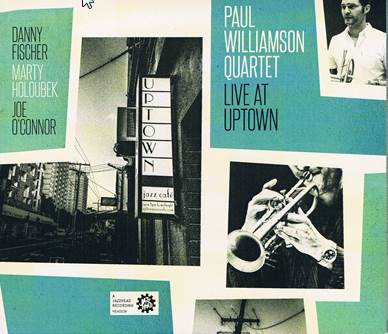 | Paul Williamson Quartet - Live at Uptown (Jazzhead)
|
In Melbourne trumpeter Paul Williamson's tenth release as a leader, he fronts a live session at the Uptown Jazz Cafe for a collection of jazz standards. A familiar name in the Australian jazz community, Williamson has also performed with international artists in the US, Europe and Asia, while based for two years in Dublin. He’s currently Jazz and Honours co-ordinator at the Sir Zelman Cowen School of Music, Monash University
Most of these tracks will be familiar to jazz fans with pieces by Monk, Parker, Wayne Shorter and others, but they're all interpreted in a fresh and original way. Gus Kahn's You Stepped out of a Dream is taken at a slightly faster clip than it's often played, opening with Williamson's vigorous solo after a piano intro by Joe O'Connor, winner of the 2013 Wangaratta National Jazz Award, and a Bell Award in 2014. Bassist Marty Holoubek and drummer Danny Fisher form an adept duo holding the substructure firmly together, and both Holoubek and O'Connor deliver enlivened solos on the Kahn piece
In the opener, Monk's I Mean You, Williamson's trumpet soars effortlessly into the high upper register especially in exchanges with Fisher's energetic drum work, and O'Connor's piano provides a swinging interlude
Each of these accomplished players make important contributions, as well as combining thoughtfully. The difficulties of perfectly recording drum kits live are sometimes evident here, but overall the mastery and invention of the players surmounts
   
|
John McBeath
Previously published in The Australian August 2016 |
| Back to Index |
| 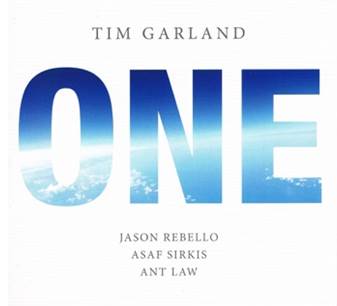 | Tim Garland - One (Edition)
|
UK saxophonist Tim Garland with his Lighthouse Trio was a headliner at the 2012 Wangaratta Jazz Festival but only drummer Asaf Sirkis from that trio appears on this new quartet recording. Ant Law plays various guitars, Jason Rebello is on keys and there are several guest artists
One of the guests is Hossam Ramzy playing a range of Egyptian percussion instruments, including tablas on the opener Sama'i for Peace, a ten beat Middle Eastern piece with an impressive soprano sax solo from Garland as the rhythm propounds. Rebello's piano maintains the flow, and the ensemble grows a bigger sound than its five members
Another guest is vocalist Dionne Bennett who sings Garland's anti-war composition, written during an arms fair in London: Pity the Poor Arms Dealer . . . ' who sows the seeds of war, making sure each has enough to keep them wanting more.'
Garland acknowledges influences from Celtic music and Latin and Spanish rhythmic patterns, explored over ten years by his band, Lammas and absorbed from his ongoing collaboration with Chick Corea. Such rhythms with added percussion are heard on Foretold where the leader has also layered six saxophones instead of just one producing the sound of a big band reed section, sometimes with throat growl overtones, as well as his soprano sax solo. Sirkis's frame drum kit comes to the fore, and Ramzy is heard here too creating a mesmeric groove on the karkabu (giant metallic finger cymbals) and doholla, a deep drum
Law's eight string guitar solos quickly and imaginatively ahead of Garland's frenetic soprano in Youkay, the closer
This is an unusually diverse collection of nine special compositions
   
|
John McBeath
Previously published in The Australian August 2016 |
| Back to Index |
| 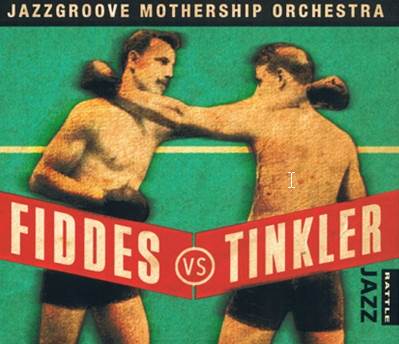 | Jazzgroove Mothership Orchestra - Fiddes vs Tinkler (Rattle)
|
Although both Andy Fiddes and Scott Tinkler are trumpeters, the suggested battle in the title is not between two trumpets. Instead Fiddes has composed these ten tracks and conducts the seventeen piece big band which Tinkler fronts as soloist
The intro Awakening, true to its title is a slow number, gradually enlivening as the orchestra's spreading, melancholy chords are overridden by Tinker's spirited trumpet
The following track, Steps In The Dark brings two other soloists forward: after a mysterious, treading sequence from the band Carl Morgan's guitar floats in to build into an intro passage for Tinkler's trumpet to soar into the high register, ahead of Evan Harris's exploratory tenor sax
Gaffer Work opens with just Tinkler's astonishing trumpet rising and falling, underpinned by Tom Botting's contrabass before the full orchestra arrives with Jamie Cameron's drum punctuations as Tinkler continues feverishly and the band's artistic director David Theak stokes the excitement on soprano sax
An air of slightly repressed excitement opens Where Do We Go From Here? Perhaps in partial answer to that question Matt Keegan delivers a tortuous and fragmented tenor sax solo as the full band pulses and throbs to launch further examples of Tinkler's virtuosic aerial trumpet
Amongst the ten tracks are three interlude pieces which serve as bridges to the main works, one of which, The Sound of Struggling displays some especially fine arranging for the band
These are all descriptive compositions by Fiddes, featuring adept use of light and shade for the orchestra, and providing suitable vehicles for Tinkler's never less than brilliant trumpet ascending to spectacular heights and effortlessly tossing off hyper-fast runs
   
|
John McBeath
Previously published in The Australian July 2016 |
| Back to Index |
|  | Julius Schwing TrioB - Edge 2:isthmus (Isthmus Music)
|
Tasmanian guitarist Julius Schwing has dedicated this collection to The Neck, a landmark on Tasmania's Bruny Island where he resides, and where six of these seven tracks were recorded
As Schwing says: 'Although set in a traditional jazz guitar trio format, the music rarely ventures into the guitar as leading voice direction . . .' This observation becomes increasingly obvious as the album continues. The music is often quite abstract, texturally melodic and quite meditative, sometimes to an almost hypnotic state
Assisted by bassist Nick Haywood and Alf Jackson on drums, Schwing's opener imagines an aerial view of The Neck beginning with triplet chords in a soft beat continuing to achieve a mesmerising effect
Neck Nocturnal imagines the landmark at night as ghostly guitar notes are surrounded by moving bass and brushed drums and cymbals, while They're Gonna Seal The Roadis a lament for a gravel road, in three sections: before (pretty), during (grinding and tortured) and after (prettiness destroyed)
The final track Quarternary Rage imagines what it would be like to experience this area of land during a storm, as heavy descending chords are accompanied by hectic drumwork
While these songs can't recreate the landscape for those who haven't experienced it, they nevertheless hold imaginative music portraying an area of great importance to the composer
It's quite possible to appreciate this music on its own merits without prior knowledge of the land it sets out to describe
   
|
John McBeath
Previously published in The Australian July 2016 |
| Back to Index |
| 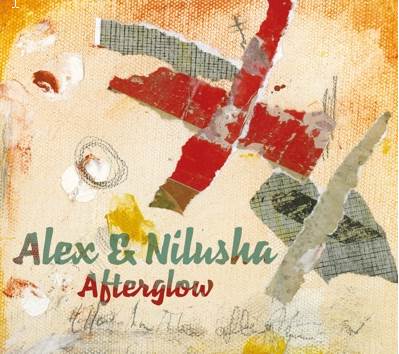 | Alex and Nilusha - Afterglow (Whispering Tree Music/Planet)
|
With this recording, it is evident the now well established duo has solidified their exotic all-encompassing global sound. Old friends such as US guitar legend Mike Stern, Cuban violinist William Roblejo and Argentinian guitarist Alan Plachta, Paul Grabowsky, Miroslav Bukovsky and Evripides Evripidou are back for the ride while new friends such as legendary Cuban percussionist Roman Pelladito and countryman, tres master Pancho Amat and bass anchorman Frank Di Sario join in the fun. Yes, like 2014’s Tales to Tell, the album is highly produced with the vocals and percussion most prominent in the sound mix. ‘Afterglow’ perhaps defines the album’s spirit best. Pertout sustains a North African strain on the Brazilian berimbau before bass and electric piano lay the foundation for Nilusha’s radiant backing vocals then emotionally charged solo lyric that portrays a bright but lonely African night sky. Elsewhere the almost tribal wordless vocals of Nilusha are an uncanny triumph, conjuring spiritual meaning to the senses without any true language definition. Afterglow is undoubtedly a vocal and percussion collaboration worthy of discovery.
   
|
Peter Wockner
|
Acclaimed Melbourne-based world music duo of percussionist Alex Pertout and vocalist Nilusha Dassenaike have recently launched their third collaborative album in front of a studio audience at Radio IMER in Mexico City, followed by performances at the 2016 Cubadisco Festival in Havana Cuba. The pair won a Premio Internacional prize at that festival in 2015
These eight originals – all with esoteric Latin rhythms – were recorded in Melbourne, Havana, New York and Buenos Aires with a huge variety of musicians, including outstanding US guitarist Mike Stern, numerous Australian players, plus two Cubans: Pancho Amat master of the Cuban tres guitar and legendary drummer Roman Pelladito on congas and sacred bata drums
The title track has Pertout playing an astonishing fifteen different percussion instruments from berimbau – a Brazilian single string bow – to diverse bells, gongs, cymbals, shakers, drums, vibes, a glockenspiel and more. At the intro Nilusha provides an ethereal choir of background vocals before embarking on her wistful solo. Paul Grabowsky delivers a very appropriate electric piano solo ahead of Nilusha's concluding stanzas and a chorale with ensemble fade-out
Nilusha's lyrics are romantic and philosophical, poetical and often abstract, as in Early Black Velvety Sky which opens with Pertout's smart congas and features trumpet, violin, and percussion solos plus Amat's tres guitar bringing skilful sketches of Havana
This highly individualistic collection of originals can be categorised as exotic world/jazz in Latin rhythms with Nilusha's celestial vocals and Pertout's multi-instrumental expertise
   
|
John McBeath
Previously published in The Australian June 2016 |
| Back to Index |
| 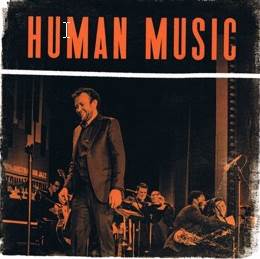 | ATM15 - Human Music (Independent)
|
ATM15 is a fifteen piece Melbourne big band including its director and composer Andrew Murray
The collection of eight Murray originals is masterfully arranged and very well recorded – no small achievement when 14 instruments are involved – at Allan Eaton Studio in St Kilda
Murray's arrangements make efficient use of his soloists, and the large ensemble, sometimes in an overlaying format. Listen to This pushes the tempo along, courtesy of strong work from drummer Hugh Harvey, especially in a lengthy opening solo and in exchanges with the band; racing solos are also provided by Ron Romero's tenor sax and Darrin Archer on keys
At the slow end of the tempo scale Karma features interesting harmonic complexities in the full band voicings, while Derby Jump does what the title suggests, showcasing a sequence of swinging tenor exchanges between Ron Romero and Stephen Blyth and the full band jumps with Basie-like intensity
Dig spreads an invigorating slower soundscape with swing-era echoes using drum assistance and includes a shout-it-out trombone solo from Alistair Parsons. Further inventive arranging opens Early Days to introduce Tim Wilson's spirited alto sax solo and fine, over-riding trumpet work from Callum G'Froerer
Andrew Murray is to be complemented on the huge task of forming this impressive big band, containing several outstanding soloists, and for writing and skilfully arranging these impressive compositions while avoiding musical cliché, to rank ATM15 as good as any big band jazz ensemble in the country
   
|
John McBeath
Previously published in The Australian June 2016 |
| Back to Index |
| 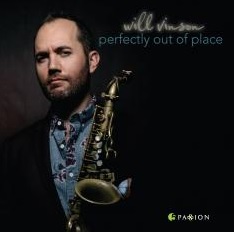 | Will Vinson - Perfectly Out of Place (Independent)
|
This is New York saxophonist Will Vinson's sixth recording as a leader, where his ten originals utilise groups from duo size up to twelve piece, using his quintet plus overdubs, synthesizers, vocals and strings – firsts for Vinson
Vinson gives high praise to the foundation musicians of his quintet with whom he's been playing for two decades: guitarist Mike Moreno, pianist Gonzalo Rubalcaba, drummer Jeff Ballard and Matt Penman on bass
This collection incorporates wonderful musical design, and as Vinson says he's explored writing music that is 'a touch more through-composed' than his previous work and he introduces additional sounds to the quintet: astute overdubs, the Mivos String Quartet, vocalist Jo Lawry, and percussionist Jamey Haddad
The Mivos Quartet begins the opener Desolation Tango in an untango-like semi-classical, pastoral passage, soon joined by restrained guitar notes and Vinson's passionate soprano sax in a romantically desolate mood
The superb duo of piano and alto traverses an almost tempo-less Limp of Faith with each player excelling in both solo and duet passages
An exhilarating uptempo Upside with a memorable post-bop theme lifts off with Vinson's racing alto underscored by guitar, Rubalcaba's always imaginative piano and Ballard's clever stick work
The entire twelve musicians reassemble for a powerful Skyrider travelling forcefully with strings weaving around the quintet and its members' solos, plus Jo Lawry's amazing wordless vocals way up on top of the highest strings
This is a highly artistic album of admirable, varied compositions and performances of highly skilled musicianship
    
|
John McBeath
Previously published in The Australian June 2016 |
| Back to Index |
|  | Jason Rebello - Held (Edition)
|
British pianist Jason Rebello emerged in the UK in the early nineties with a string of critically acclaimed albums, and spent six years as pianist with Sting and another six in Jeff Beck's band. His debut album A Clearer View (1990) was produced by Wayne Shorter. Rebello has also worked with Jean Toussaint,Tommy Smith and Branford Marsalis, and presented Artrageous! on BBC television
This latest solo piano album is of ten originals plus a perky version of Lennon/McCartney's Blackbird with quick flowing passages of improvisation that perfectly suit the tone of the original
Rebello often incorporates a contrapuntal left hand, as in the opener Pearl where the piece streams in a semi-classical way before the tempo lapses and jazz influences appear, to carry it to conclusion
The title track is a slow tempo drifter with elegant treble figures against sombre chords evolving into a melancholy but attractive theme, while Happy But For How Long is at a bouncier tempo using quickly moving chords and a bright melody with some swinging solo work
A subdued statement with a vaguely Asian connotation opens Tokyo Dream and continues in an introspective narrative that manages to combine Eastern influences with a faintly bluesy approach
Quick rippling begins Salad Days ahead of a tuneful theme that evolves into a fast running jazz-inspired solo. The closer, Dissolve does just that in a pensive, almost hesitant way ending in deep, satisfyingly complex chords
Rebello's work is flush with fresh ideas and a soothing tranquility producing unexpectedly attractive melodies. His capable jazz sensibility and proficient technique translates into in a very pleasant piano recital of relaxed and sensual playing
   
|
John McBeath
Previously published in The Australian June 2016 |
| Back to Index |
| 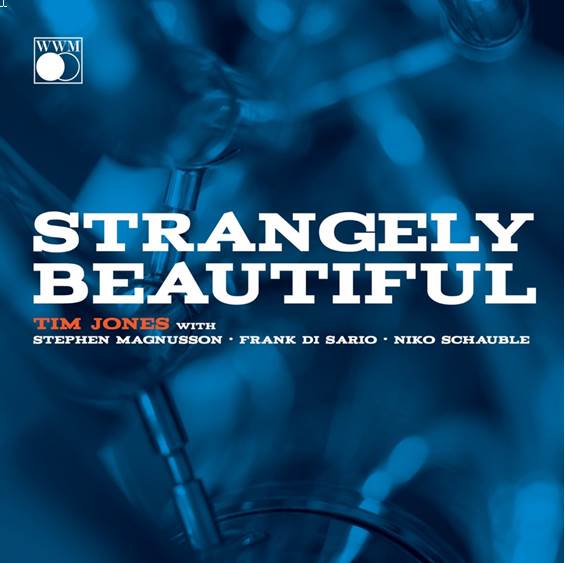 | Tim Jones - Strangely Beautiful (Independent)
|
When jazz began in New Orleans after WWI, the tuba supplied the rhythmic bottom. As the music spread to Chicago, New York and beyond, the tuba spread with it, but was soon replaced by the more precise double bass.The hard-to-control but easy to parade with tuba soon disappeared from jazz almost everywhere else but not in the music's birthplace New Orleans where even today having a tuba in the band remains standard operating procedure
Now, on this recently released recording Strangely Beautiful from tuba playing Tasmanian Tim Jones, this charming instrument resurfaces together with traditionally associated jazz instruments of Steve Magnusson’s guitar,Frank Di Sario’s double bass and Niko Schauble’s drums infusing familiar tunes with a play-full edge
The album’s style and arrangements are best described as comfort food jazz. It won’t send chills up and down your spine but rather soothe and caress you gently all over with warmth
Herbie Hancock’s Watermelon Man, Pennies From Heaven, and Someone To Watch Over Me are enjoyably pleasant and the haunting slide guitar of Steve Magnusson on What Kind of Fool Am I gives an added dimension
At the heart of it all is Tim Jones’ superb tuba playing that makes this album a winner for lovers of relaxed, laid back jazz
   
|
BARRY O’SULLIVAN
Previously published in Fine Music Magazine |
| Back to Index |
| 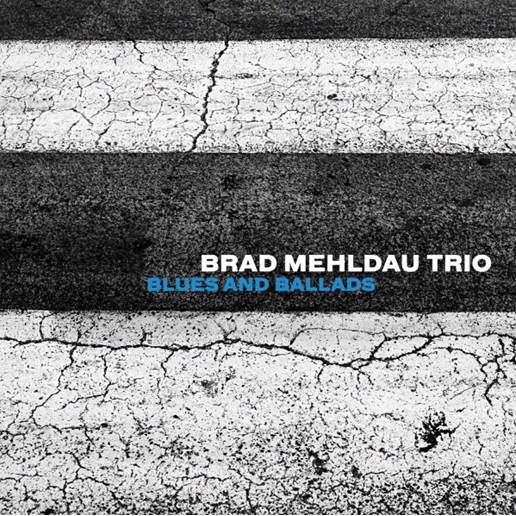 | Brad Mehldau - Blues and Ballads (Nonesuch Records)
|
The Brad Mehldau Trio’s Blues and Ballads album is their first new release since 2012’s Where Do You Start. Featuring Mehldau on piano,Larry Grenadier on bass, and Jeff Ballard on drums,
this recording similarly comprises interpretations of songs by other composers,this time with the focus on blues and ballads implied by the album’s title.The opening and closing tracks Since I Fell For You and My Valentine get down and dirty in the bluesiest style. They are prime examples of what a superb jazz pianist like Mehldau can produce in the 4/5 rhythm style with two sidemen that seem to know exactly when and when not to play and contribute.Cole Porter’s I Concentrate on You receives a classy Latin treatment and an inspired improvisational extension.It might just be the star piece of the whole album and was certainly the track I immediately engaged with amongst a plentitude of other stylish musical treatments.Charlie Parker’s Cheryl is handled extremely well in the blues style but it’s the bands inventive interpretations of Maschwitz and Strachey’s These Foolish Things and Lennon and McCartney’s And I love Her,with their peerless technique and lavish extensions,that contribute largely to the album’s star status.Think rainy days,late nights, hanging out and this intimate acoustic jazz album immediately provides the elixir for musical satisfaction
    
|
BARRY O’SULLIVAN
|
| Back to Index |
| 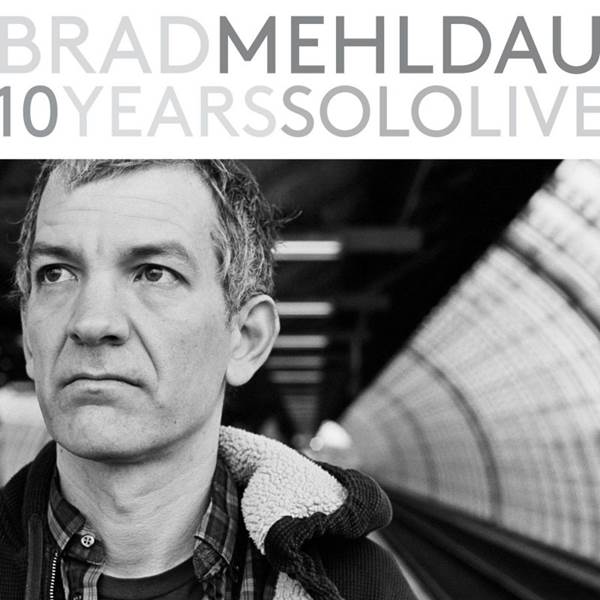 | Brad Mehldau - 10 Years Solo Live (Nonesuch 7559794990)
|
Brad Mehldau's 10 Years Solo Live album is culled from 19 live recordings made over a decade of the pianist's European solo concerts and is divided into four thematic subsets of four sides each, Dark/Light, The Concert, Intermezzo/Rückblick, and E Minor/E Major
Within these themes the variety of five hours of piano solo is astounding.Every track on this four CD pack is a world to its own and Mehldau expertly shows his prowess throughout.Sides 1–4 focus on this dichotomy in pairs, beginning with the dark energy of Jeff Buckley's Dream Brother, followed by the grace of Lennon/McCartney's Blackbird. The songs on Sides 5–8 (The Concert) come from different concerts arranged in the sequence he would play them live.They are amazingly much more than just superb.
Mehldau has performed around the world at a steady pace for 25 years with his trio as well as with other collaborators and as a solo pianist building a large and loyal audience.Mostly he plays in the classiest classical venues like the Mozartsaal in Vienna and the Palais des Beaux-Arts in Brussels. He is an engaging,playful and elegant improviser and one of the admirable things about him is his restless musical curiosity.He is a terrific pianist and a conceptual improvisor.
Because his instrumental authority is so striking he is able to pull off almost any gambit he thinks up with his deep musical imagination.He has a phenomenal capacity to play complicated music with astonishing clarity and liveliness
There are so many favourite tracks from such a voluminous collection that it would be pointless just to name a few.However,The Concert -Get Happy was the one that gave me real insight into what and who I was listening to - the pianism of a jazz great.
10 Years Solo Live is released digitally, on CD and an on an eight LP Vinyl Box set on Nonesuch Records.
    
|
Barry O’Sullivan
This article was previously published in Fine Music Magazine |
| Back to Index |
| 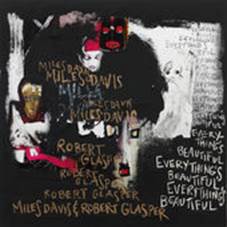 | The Robert Glasper Experiment - Miles Davis - Everything’s Beautiful (Blue Note, Columbia, Sony Music 88875157812)
|
Robert Glasper's new album Everything's Beautiful features imagined reinterpretations of songs by Miles Davis. The album dives into masters and out-takes from the Miles Davis’ Columbia Records era. Glasper is joined by British soul singer/songwriter Laura Mvula, hip-hop producer Rashad Smith, Grammy-nominated Australian neo-soul quartet Hiatus Kaiyote, jazz guitarist John Scofield and the legendary Stevie Wonder being just fabulous on harmonica on Right On Brotha plus other genre artists featuring riffs and voice samples of the ‘general badass’ Miles talking in the studio to his musicians
For some time now Glasper has been channeling the inspired works of Miles Davis, most evident with his contribution to the forthcoming Miles Davis biopic, Miles Ahead
If you are a jazz snob and expect to hear classic Miles Davis trumpet on a stem-less Harmon mute then this music is definitely not for you. They don’t make it like that anymore unfortunately but luckily jazz is in an evolution just as it was in those years with Miles from the mid ‘40s to the early ‘90s when he was in the thick of almost every important innovation and stylistic development of the period. Miles, more often than not, lead the way in those changes both with his own recordings and by choosing sidemen and collaborators who forged new directions. This recording is virtual proof that the evolution is still in progress today
I was enchanted by the standout tracks of Erykah Badu’s Maiysha (So Long) and the Australian ensemble Haitus Kaiyote’s contribution on Little Church and captivated by the vocals of Laura Mvula on Silence Is The Way as well as KING on Song for Selim. Just in these works alone Glasper has built something unique but still unquestionably Miles.
The cover art of the recording created by Francine Turk integrates elements of Miles Davis own art work. Turk creates a visual that embraces the ideas of Robert Glasper, taking fragments of Miles music and reinterpreting these fragments in a unique,modern and far from ‘silent way’. In the Main Man’s own words heard often when he was pleased with a recording session…” everything’s beautiful.”
   
|
Barry O’Sullivan
This article was previously published in Fine Music Magazine |
| Back to Index |
| 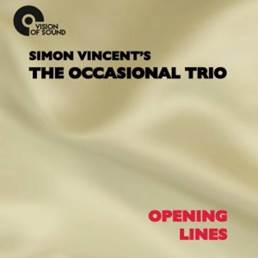 | Simon Vincent's The Occasional Trio - Opening Lines (www.vision-of-sound.com)
|
Simon Vincent is a Berlin based pianist and composer who stretches his musical expression across electronic and acoustic environs to solo, duo and trio settings. Until recently if you were in Berlin, you were most likely to see him creating sounds behind an Apple laptop in the experimental electro-acoustic space, but after a lengthy hiatus (since 1998) he has returned to the piano with his most rigorous jazz platform, the ‘Occasional Trio’. An almost fascinating rediscovery of the sounds that once defined him, Vincent’s acoustic jazz trio is made up of fellow Berliners Roland Fidezius bass and Rudi Fischerlehner drums. With a refreshingly reinvigorated approach, Vincent teases sounds out of the Bosendorfer with dexterity of touch that is as dynamic as it is sublime. All nine compositions from the album are Vincent originals. ‘Well you Shouldn’t’ has an abundance of intensity and forward momentum coupled with his Monk influence and highlights the melodic drumming of Fischerlehner who incidentally has collaborated with Tony Buck of The Necks. ‘Rain Drops in June’ is one of four compositions played in waltz time on the album and as I write this on a wet Sydney June day, the rain drops outside are as dense and intensive as the walking Fidezius bass line. The haunting melancholy melody of this piece is then acutely diced by the pianist into tasty portions of block chords and bluesy vignettes. Elsewhere on the album, the trio extend themselves into unknown trajectories with free-form improvisations born out of weightless space that develops into freight train-like gravitas. Occasionally, too much of a good thing can be wonderful
   
|
Peter Wockner
|
| Back to Index |
| 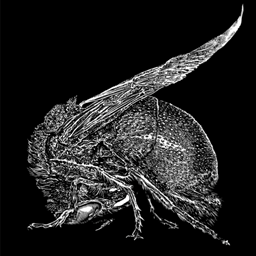 | Casey Golden Trio - Miniature (www.caseygolden.com)
|
This EP is the trio’s third release in the past 12 months, and with every recording, the compelling nature of Golden’s compositions has evolved as has the empathy in the trio made up of Bill Williams bass and Ed Rodrigues drums. The Miniature four piece suite opens with melody from a toy music box until the piano and bass sets up a pensive framework for the trio to forge into a Bulerias-like rhythmic framework that fragments in and out of composed sections of swing, backbeat and electro-acoustic guitar courtesy of guest Daniel Walsh. Golden recalls the theme to open the second movement before bassist Bill Williams goes solo, laying the foundation for Golden to return into freer territory where interplay between the three is enhanced before momentum shifts again into broken rhythmic patterns. A great characteristic of Golden’s playing is that he uncannily joins almost sound-bite vignettes of ideas into longer and logical narratives punctuated at all the right places. Following a solo piano interlude given a sepia effect along with the music box, Miniature moves into the final movement with brisk precision and intensity as the music breathes in and out of individual meters. Like a macro-photographer, the focus is enhanced on a singular repetitive melodic idea and the rhythmic intensity underneath is stretched then condensed creating glorious bursts of danceable dalliance.
   
|
Peter Wockner
|
| Back to Index |
| 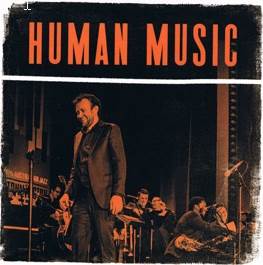 | ATM15 - Human Music (Independent)
|
ATM15 is a fifteen piece Melbourne big band including its director and composer Andrew Murray
The collection of eight Murray originals is masterfully arranged and very well recorded – no small achievement when 14 instruments are involved – at Allan Eaton Studio in St Kilda
Murray's arrangements make efficient use of his soloists, and the large ensemble, sometimes in an overlaying format. Listen to This pushes the tempo along, courtesy of strong work from drummer Hugh Harvey, especially in a lengthy opening solo and in exchanges with the band; racing solos are also provided by Ron Romero's tenor sax and Darrin Archer on keys
At the slow end of the tempo scale Karma features interesting harmonic complexities in the full band voicings, while Derby Jump does what the title suggests, showcasing a sequence of swinging tenor exchanges between Ron Romero and Stephen Blyth and the full band jumps with Basie-like intensity
Dig spreads an invigorating slower soundscape with swing-era echoes using drum assistance and includes a shout-it-out trombone solo from Alistair Parsons. Further inventive arranging opens Early Days to introduce Tim Wilson's spirited alto sax solo and fine, over-riding trumpet work from Callum G'Froerer
Andrew Murray is to be complemented on the huge task of forming this impressive big band, containing several outstanding soloists, and for writing and skilfully arranging these impressive compositions while avoiding musical cliché, to rank ATM15 as good as any big band jazz ensemble in the country
   
|
John McBeath
Previously published in The Australian May 2016 |
| Back to Index |
| 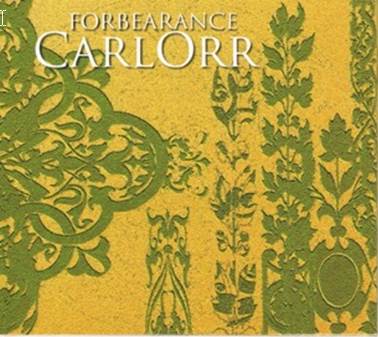 | Carl Orr - Forbearance (Independent)
|
Ex-pat Australian guitarist/composer Carl Orr has been London-based since the nineties where he's appeared with some very impressive names: Billy Cobham, Randy Brecker, Ernie Watts, and many others
Orr has often been an exponent of jazz fusion using heavy guitar distortion, but this, his eighth album, is a soft and melodic world away from that genre. The guitarist speaks of this music as his contribution towards creating a peaceful, harmonious world
His acoustic guitar is beautifully recorded in this London production, with a host of sidemen over eleven tracks, nine of which are originals
The opener and title track is a perfect introduction to the collection with Orr's solo classical guitar and added glockenspiel delivering a semi-classical sounding piece of deeply calming ambience, beautifully played
American Daydream continues the tranquil mood, adding rhythm via piano, organ, bass, drums and percussion, while the largest ensemble – of thirteen members, including vocalist Jasmine Nelson plus strings, brass and reeds – undertakes Lennon/McCartney's Mother Nature's Son in a quietly restrained rendition
Although lyric-less, the title People Need Healthcare, Not Guns conveys Orr's social conscience, and as with many of these pieces Ironbridge with guitar and string quartet has a decidedly folk feel conveyed in a softly melodic way
This unassuming and peaceful collection goes a long way towards achieving Orr's stated aim 'to make the listener feel calm, optimistic and invigorated.' Although it utilises some jazz features the album is really more of a soothing, mood-inspired portfolio of quiescent classical/folk, an ideal accompaniment for an afternoon of relaxed daydreaming
   
|
John McBeath
Previously published in The Australian May 2016 |
| Back to Index |
| 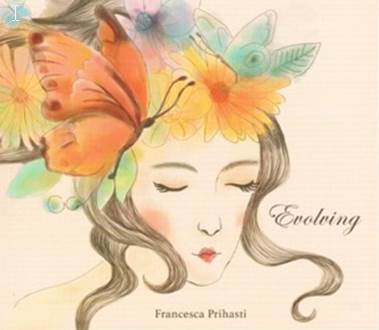 | Francesca Prihasti - Evolving (Independent)
|
Indonesian born, now Sydney-based pianist, Francesca Prihasti has released her second album, featuring a quartet, recorded in New York. The seven tracks are all Prihasti originals, which she says express the story of a butterfly and its evolution from the egg, and caterpillar to adulthood
The opener, Summer Sky begins softly with a repetitive piano note suggested as signifying tiny butterfly eggs laid on leaves. As the inchoate piece continues Nic Vardanega's guitar states the theme as Orlando Le Fleming's bass and Rodney Green on drums join in unobtrusively and the piano embarks on flowing, lyrical improvisations, building to an ensemble crescendo
The bass, piano and guitar ostinatos at the start of The Circle serve to signify that all things move in cycles, and characteristically Prihasti's sprightly solo glides with imaginative melodic ideas that are picked up and further expanded by the guitar's spirited solo ahead of a concluding, cyclic return to the opening passages
Continuing the collection's dreamily poetic atmosphere Safe Distance opens with a slow-moving piano and guitar theme that moves in an upward trajectory and introduces a thoughtful bass solo, while the title track establishes a tuneful melody interweaving piano and bass, soon joined by guitar moving into a pleasantly relaxed solo
This is an album of romantic music that floats and drifts idyllically with light rhythms and melodious concepts, following the composer's narrative ideas. It's expressively played, and the overall effect is one of agreeable harmoniousness
   
|
John McBeath
Previously published in The Australian May 2016 |
| Back to Index |
|  | Phronesis - Parallax (Edition Records/Planet)
|
This is the sixth album from Anglo-Scandinavian trio Phronesis, and their fourth for Edition Records. Led by Danish bassist Jasper Høiby with UK pianist Ivo Neame and drummer Anton Eger from Sweden, the trio is obviously democratic in its approach to content, each member having composed three of these nine tracks
The group's name is an ancient Greek word, translated as 'practical wisdom', a description, added to the word ‘musical', that certainly applies to Phronesis's virtuosic capabilities. The music is cerebral and descriptive but also swings mightily
One of the leader's pieces, Just 4 Now demonstrates the trio's peak driving mode as Høiby's bass pushes vibrantly through the busy complex of drums and piano, and delivers a fast-moving solo of clever rhythmic emphasis
Neame's Manioc Maniac has nothing to do with the Cassava (Manioc) in the title, but employs a good serving of racing, maniacal high energy piano right from the start, as drums and bass rush it all along to an abrupt conclusion
The opener, 67000MPH by Eger is another high speed outing to start, with a smart piano and bass unison riff and Eger's hyperactive cymbals, moving to a medium tempo later, again showing the trio's almost telepathic communication
Stillness, with its slow, mysterioso beginning has all three players contributing, as the leader adds the arco'd bass, but it moves into firstly a striding rhythm, and then a hard swinging passage riding to the conclusion
Phronesis is at the world forefront of accomplished jazz piano trios with high calibre individuals, combining perfectly on their originals in a decidedly Eurojazz style
    
|
John McBeath
Previously published in The Australian May 2016 |
| Back to Index |
|  | Sonic Mayhem Orchestra - Live Mayhem (Independent)
|
Sydney's 14 piece Sonic Mayhem Orchestra, led by saxophonist James Ryan is well known for their regular appearances firstly at the Blue Beat music club during 2012 and then regular weekly gigs at Lazybones Lounge, Marrickville. This, the band's debut album, was recorded over three years, and includes an overall total of 28 musicians. There are five of Ryan's originals and three standards, all eight tracks arranged by the leader
As with many live recordings the sound quality tends to vary, and the percussion sometimes sounds a little muddy, but the standard of composition, arranging and performance is high
The opener, Frogs begins with a theme that literally leapfrogs musically, before a series of solos starting with Greg Coffin's smartly crisp piano, then Aaron Michael's racing tenor sax followed by the high-flying trumpet of Simon Ferenci, and later a notable drum sequence by Nic Cecire, all complemented by co-operative ensemble work
Vocalist Trish Delaney-Brown appears on several tracks, including an able interpretation of Georgia, featuring Steve Brien's poignant guitar and the robust trombone of Dave Panichi
Ryan's only solo occurs on his original Hey Which Way where he opens with a blisteringly wild, unaccompanied baritone sax with honks, harmonics and a heavy riff. Soon he's joined by Kim Lawson's alto sax for a duo lift-off lasting about six minutes before the ensemble arrives to build to the conclusion
The 'mayhem' of the group's title certainly appears throughout this powerful, at times raucous album, but that's tempered with softer, calmer passages, all showcasing individual capabilities and Ryan's masterly arrangements and compositions
   
|
John McBeath
Previously published in The Australian April 2016 |
| Back to Index |
| 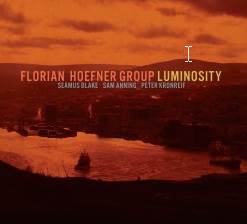 | Florian Hoefner Group - Luminosity (Origin Records)
|
Although German pianist – now Canada-based – Florian Hoefner has played at major festivals throughout Europe, appeared on ten previous recordings, and toured extensively in the US and Canada, he's not as well known in Australia as he deserves to be. This new album by his quartet, recorded in New York features Australian bassist Sam Anning, with drummer Peter Kronreif, and saxophonist Seamus Blake
These eight tracks display not only Hoefner's composing ability, but also his quite stunning performance in a unified work of thought-provoking components and altered rhythmic content. Newfound Jig, based on an Irish jig, but given post-bop attitude, brings impetus to Blake's tenor solo, powerfully driven by hyperactive drums and dynamic bass ahead of Hoefner's tension-building piano
The title track has a serene 5/4 feel explored by the leader's extravagantly pensive excursion to introduce Blake's gradually stoking solo on soprano sax, whileThe Bottom Line opens with a bop-infused bass and tenor sax unison passage before Blake's solo launches into take-off
In a slow tempo The Narrows demonstrates Hoefner's melodic capabilities, both in the balladic composition and his organic interpretation; Blake and Anning also deliver expressive solos. Drums and piano interact well throughout In Circles both during Hoefner's solo and forming a substructure for Blake's tenor sax to traverse mounting passion. A slower tempo also aids the rural atmosphere of North Country where the tenor sax floats lazily over flowing piano, and Anning's bass solo adds dimension
A fine collection of compositions interpreted with deep expression and highly skilled group integration
   
|
John McBeath
Previously published in The Australian April 2016 |
| Back to Index |
| 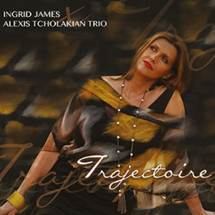 | Ingrid James and Alexis Tcholakian Trio - Trajectoire (Newmarket Music NEW3346.2)
|
Not one to shy away from a challenge, Ingrid James takes her writing and singing to another level, but it’s her near perfect phrasing on Jimmy Rowles The Peacocks that’s worth the price of this album alone. Rarely have Norma Winstone’s lyrics sounded so good. Recorded in Paris in 2014 as a result of collaborations with the talented Parisian pianist Alexis Tcholakian, the classically trained pianist is a frequent accompanist for singers in Paris but shows here that he’s a singularly remarkable talent and a compelling composer. All the pieces are Tcholakian compositions save The Peacocks and James has written emotionally charged and personal lyrics to each. The trio of Simon Teboul and Thierry Tardieu is augmented by Danish tenor saxophonist Simon Spant-Hanssen on four pieces and flautist Mariane Bitran on three. Guitarist Guillaume Muschalle on guitar and Miroslav Bukovsky on flugel embellish one piece each. A truly cross cultural affair, US drummer Todd Harrison also appears on one track. The back-beated tribute to the jazz greats sees James scatting in unison with Simon Spang-Hanssen. The album’s title track Trajectoire is an upbeat but loping reflection dedicated to the memory of James’s passed sisters.
   
|
by Peter Wockner
|
| Back to Index |
East Coast Blues & Roots Music Festival (BluesFest) 2016
BluesFest #27. Here is a short glimpse of gigs I liked most in chronological order :-). And as usual - I will not write about the super-mega-stars (it is hard to compete with Wikipedia :-). I’ll focus mostly on local and up-and-coming artists.
Friday 25/04/2016
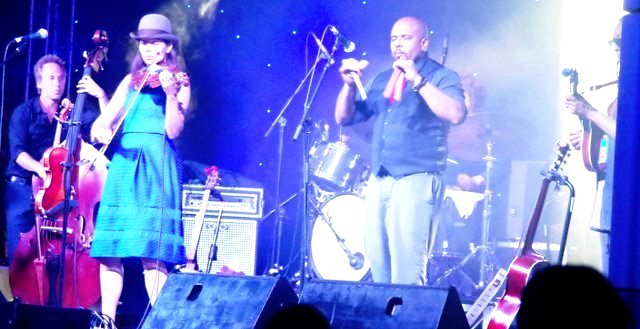 |
18:00 DELTA - Rhiannon Giddens
Much as I promised not to write about megastars, this artist is on the cusp of becoming one. Rhiannon Giddens is a Grammy Award winner (having been nominated three times), twice nominated to be Artist of The Year by Americana Music Association. Singer, violinist, banjo player, she is also a founding member of the Grammy awarded country, blues and old-time music band Carolina Chocolate Drops. Studied as opera singer, her style is very far from |
opera - blend of jazz, blues, gospel, boogie and folk music. Her voice, very high calibre band and her simple and warm-hearted stage image was very well received by the public.
 |
19:30 JUKE JOINT - Jerron ‘Blind Boy’ Paxton
In my view, Mr Paxton is The Best Performer of this Festival (I could not resist and allowed myself to watch his gig twice).
Originally from Los Angeles, he plays banjo, fiddle, guitar, harmonica, piano, Cajun accordion and the bones (percussion) and, more importantly, he sings. He sings and tells old style Southern blues and folk stories and does it with great joy and mastery. Some will hear hints of Old |
Masters like "Blind" Lemon Jefferson or Gary Davis in his style (he also looks like young Willie Dixon). Last year he became Artist of the Year in the inaugural International Folk Music Award. On Monday it was a special treat - Phil Wiggings, supernatural harp, joined Jerron. This was something very special - but unfortunately just 3 songs. The public loved it! It was a big pitty that Phil - the best artist of last year’s BluesFest (see my last year review from last), did not perform his own full gig this time around.
Saturday 26/04/2016
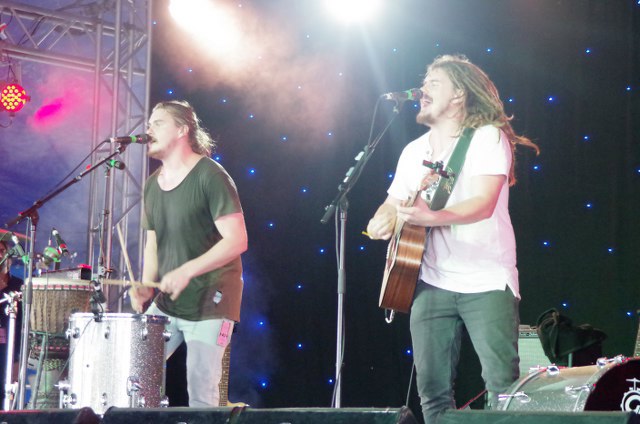 |
15:00 JUKE JOINT - Pierce Brothers
Twin brothers Jack and Pat Pierce three years ago were busking on the streets of Melbourne. Now, despite having sold 50,000 copies of their EPs and CDs (released independently, DIY), and travelled on several international tours, they have not changed much. Still the same energetic, creative and very dynamic lads - they play original songs and the public loves them! This time they attracted huge crowd. Very good voices, multi-instrumental self-support (guitars, drums, didgeridoo), and, most importantly, very frank and |
open, - at one stage, one of them, in the middle of the song, started to record public on his mobile from the stage saying "sorry guys, I cannot resist...this is unbelievable...so many people listening us..."
 |
16:00 CROSSROADS - St Paul and The Broken Bones
This is one of the most entertaining bands of this festival, they had 3 gigs and got a bigger crowd each time. St Paul and The Broken Bones is the gospel and soul sextet from Alabama with sound and look like the best bands of 60-s. Away from the stage, the band's front man, Paul Janeway, does not look very remarkable. A shortish, homely looking stocky bloke. But his look completely changes when Paul starts to sing. He is just a bundle of energy moving around the stage. Raised in a very religious family, started singing in a church choir, trained as church minister - |
he knows how to deliver his gospel songs very well. This was the first their appearance in Australia, I hope they will come back again.
Sunday 27/04/2016
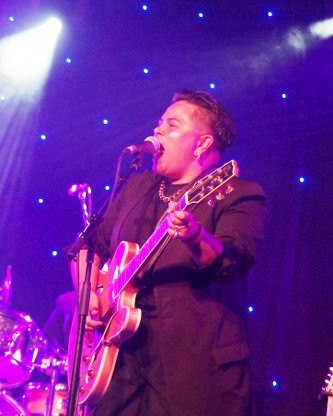 |
 |
20:00 DELTA - Mojo Juju
Mojo Juju, Melbournian singer and guitarist, this is her first BluesFest. Very stylish look, baggy trousers and long jackets of the Latino youths' Pachuco culture of the 1940s underscore the style of her music - RnB, soul of early 50s. She has thundery and commanding voice with lots of real soul in it. I have to mention her very good support band - her brother Steven Ruiz de Luzuriaga (drum kit) and Darcy McNulty on baritone sax. Check her website and try not to miss Mojo Juju's gigs. |
 |
 |
23:00 JUKE JOINT - Raw Earth
This gig shows once again that good music (especially blues) does not have any geographical limitations. The five-piece band from Singapore is formed by the most seasoned musicians – namely, Danny Loong and Francis Chan from Ublues and Victor Chen, Surath Godfrey and Lin Hanrong from Reverie. I overhead a guy near me in the crowd say that - "this is the most authentic Chicago blues on this festival" - and this was not a joke. It was a gig of very good vocal (Godfrey) and amazing instrumental work of all band members. |
Monday 28/04/2016
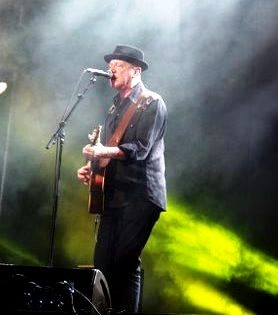 |
16:00 MOJO - Russell Morris
Russell Morris - the veteran of Australian blues and rock, inductee of ARIA Hall of Fame since 2008. This gig was dedicated to his recently released momentous Blues and Roots Trilogy (Russell spent 5 years to compose and record three parts - Sharkmouth, Van Diemen's Land and Red Dirt Red Heart) about quintessential personalities and events in Australian history. His low voice with heavy Ausie accent sounded very appropriate here at Byron. I think if there is a style "Australiana" (why not? if "Americana" exists) Russell Morris would the best representative of it. |
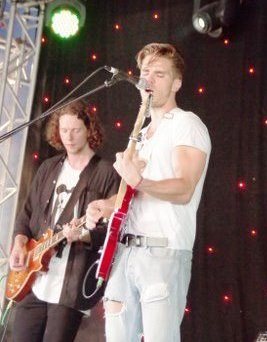 |
18:00 JUKE JOINT - Kaleo
Apart from Singaporean Raw Earth, Kaleo was the only other group from a non-English speaking country. This group is from the small town of Mosfellsbaer in Iceland. Best friends since attending elementary school, bandleader JJ Julius Son, drummer David Antonsson Crivello and bassist Danny Jones, have gained superstar popularity in Iceland. "Kaleo" means “the sound” in Hawaiian, and this group definitely can deliver sounds of serious rock. Newcomers to Australia and BluesFest, they conquered the attention of a local crowd. Do not miss them in the future. |
BUSKING STAGE
This year winners were IVY (over 18) - band from Central Cost and in Grommet division - duo Maple (sisters Monica (13) and Bridget (16) Brandolini). Also it was very nice to see our old friends, the previous years' winners - Circle of Friends and Nick and Sam with their new material. Personally, I liked the gigs of Morgan Bain from WA and local bluesman Harry Nichols.
BOOMERANG
"A Global Indigenous Arts and Cultural Festival For All Australians" - a Festival within the Festival - this is the very important addition to this year BluesFest and, I hope, for the future to come. Over 80 performances, talks, workshops by over a hundred musicians, dancers, speakers were presented at Boomerang and all of them were interesting, informative and much enjoyed by enthusiastic public.
A couple of negative-ish observations I left to the very end:
- I'll repeat what I said in my last year report: “On the negative side, it looks like BluesFest has outgrown itself. It has become too big (area and crowd-wise)….” This year we had even more people.
- In order to appeal to a broader crowd, BluesFest keeps pushing its stylistic boundaries out further and further. People appreciate this, but on the other hand, as one of my friends put, is becomes a Festival of Non-classical music. It loses its Blues and Roots focus. This can be confusing even for performers - for example, very well-known performers Grace Potter and Janiva Magness chose (in my view unfortunately) a repertoire that was more poppy than their usual style to please the (too) wide crowd.
- The BluesFest website does not have any information about the Buskers’ Competition (programme, participants, winners). This is a very big shortcoming, because it does not help (at all) to promote new and young musicians.
|
by Vlad Gilbourd, March 2016
|
| Back to Index |
| 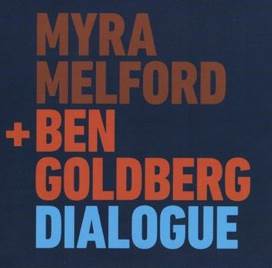 | Myra Melford and Ben Goldberg - Dialogue (Bag Records)
|
Myra Melford is an American pianist based in New York where she moved from Illinois in 1984 to study composition with saxophonist Henry Threadgill, whose band she later joined
Melford is probably best known in Australia for her acclaimed 2014 duo piano recording with Australian pianist Alister Spence, Everything Here is Possible
In this latest collection she records with clarinetist Ben Goldberg with whom she has played in occasional duos since 2008. Goldberg has played with numerous artists including John Zorn
The album is a set of thirteen improvised conversations, including eloquent themes, explorative ideas, and free improvisations. An example of the latter is The Kitchen where interest never flags as Melford's explosive piano is both caressed, then pounded, after exploratory bass notes she uses to underpin long-held clarinet notes. Tension mounts then subsides again, as clarinet continues alone, and the two join to echo a theme established by Melford at the beginning
A good example of the way in which these two are able to think as one is in the opening to 1 Through 8, a piece that at first could be a light-classical number but interweaves bluesy ideas as the work continues. There are blues traces also in City of Illusion as well as some bursts of hectic piano
The album is not as abstract as it might have been, and many of the narratives communicate moods very well: Moonless Night for example builds its scenario with descriptive imagery
This unusual collection ranges through different temperaments, some with classical overtones, and plenty of informed jazz improvisation by two accomplished musicians, working expertly together
   
|
John McBeath
Previously published in The Australian March 2016 |
| Back to Index |
| 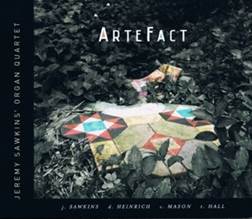 | Jeremy Sawkins' Organ Quartet - Artefact (Independent)
|
Sydney-based guitarist Jeremy Sawkins, formed an organ trio in 2004 with drummer Dave Goodman and organist Darren Heinrich, who appears here in the quartet. Sawkins moved to Ireland later that year, remaining in Dublin for two years to play with many top musicians and teaching at the Newpark Music Centre
Returning to Sydney in 2006 the guitarist reunited with organist Heinrich, and has since added saxophonist Spike Mason and Toby Hall on drums for this all-Sydney group
Opening with Mason's Blues for Sera, the organ provides a calming atmosphere at first and gradually builds the blues format behind the alto sax solo to introduce Sawkins's solo before Heinrich's Hammond climbs into a swinging Lonnie Smith-style passage leading to the re-statement conclusion
An unexpected selection is the traditional piece She Moved Through the Fair, beginning with an out-of-tempo organ and guitar sound-wash, soon joined by the sax, before the guitar wanders abstractedly
Funny Farm is a Sawkins post-bop original led by unison guitar and sax ahead of the guitar taking off before providing chordal stabs under the sax solo; while Heinrich's composition Hello, Goodbye slows the tempo for a ballad-like number with a laid-back sax exploration
Mason's second contribution, Tobes Malone features a 'tock tock' rhythm behind a quite interesting theme to which organ, alto and guitar all add solos
This is a collection of well-played music by competent musicians that makes for pleasant enough listening, even though the overall result sometimes seems to suffer from a certain lack of focus
   
|
John McBeath
Previously published in The Australian March 2016 |
| Back to Index |
|  | Ben Winkelman Trio - The Knife (Jazzhead)
|
Ex-Melbourne pianist Ben Winkelman, New York based since 2010, has just released his fourth trio album, this one recorded in, and inspired by New York. His first, Stomps, Pieces & Variations appeared on Jazzhead in 2005. A national tour promoting the new album is currently underway throughout March
Winkelman's playing has certainly evolved since he moved to the US, but he remains interested in Afro-Cuban, Brazilian, and Klezmer music – a style of Jewish traditional music often played at weddings – as well as classical music, and incorporates these influences in his trio setting
The thirteen originals demonstrate Winkelman's command of various jazz piano approaches: Silvia works through an uptempo post-bop piece with big luscious chords and a quick melodic line, while Remolacha (Spanish: sugar beet) employs a Latino rhythm, with suitably discursive piano treble, and allows wide scope for Sam Anning's bass contributions, as well as for Eric Doob's inventive percussion
The title track uses brief semi-classical excursions in a composition that also includes a bluesy undercurrent and fast Art Tatum-like runs. The longest track, The Schlep, at over seven minutes, features clever rhythmic hesitations, giving the bass an opportunity to weave through an emphasised solo, and Doob offers a punctuated passage between Winkelman's chords
While I Sleep successfully paints a dark scenario with dreamy passages, yet swings in a strong way, abetted by Anning's solidly stable bass line perfectly integrated with the piano
This is an album of great variety, showing that much can be achieved by a piano trio with imaginative compositions, and skilled, unified players
   
|
John McBeath
Previously published in The Australian March 2016 |
| Back to Index |
| 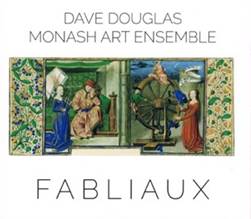 | Dave Douglas and Monash Art Ensemble - Greenleaf Music (Indepenent)
|
When acclaimed US trumpeter/composer Dave Douglas was invited to work with the Monash Art Ensemble, album co-producer Paul Grabowsky had no inkling that Douglas would compose a nine movement suite for the purpose, and even less expectation that the music would explore facets of the 14th century French Ars Nova style. Douglas is a prolific trumpeter, composer and educator from New York who has appeared as leader on over 40 recordings. From simple shaker hymns and hip hop to Mary Lou Williams, Jimmy Giuffre, and John Zorn, he is open to add any, and all, sources of input
Fabliaux are comic, bawdy verse tales written in France between 1100 and 1400, characterised by sexual obscenity and contrary attitudes to the church and nobility. Several of these have been reworked, including for the famous Canterbury Tales by Geoffrey Chaucer
A major figure of the genre who set many of his 400 poems to music was Guillaume de Machaut, and it's his music, and others of the period that Douglas researched to complete this major work uniquely combining aspects of medieval music with contemporary jazz and eclectic improvisation. The complete work was the highlight performance at last year's Wangaratta Festival of Jazz and Blues
Douglas on trumpet, leads fifteen members of the MAE, comprising four winds, three brass, four strings, and four percussion, including electronics and opening with the stately ensemble fanfares of Forbidden Flags to traverse via Marty Holoubek's contrabass and Craig Beard's pitched percussion to Douglas's triumphantly soaring solo
Frieze begins with a subdued ensemble passage of Rob Burke's clarinet, Mirko Guerini on bass clarinet and Lauchland Davidson's soprano sax, gradually evolving atonally into an out-of-tempo high treble wild spree
Unlike most of these tracks, Tower of the Winds commences with a rhythmic beat as clarinet, flute, and Jordan Murray's trombone weave around Douglas's invigorated trumpet ahead of ensemble marching chord stabs, powered by Kieran Rafferty's speedy drumming, all dissolving into an extended, improvised piano solo of building intensity by Grabowsky
This is a highly unusual suite of jazz-influenced interpretations of medieval music played superbly by Douglas with students and staff of the Zelman Cowen School of Music at Monash University together with Australian Art Orchestra members – some of Australia's finest improvisers, comprising the Monash Art Ensemble
    
|
John McBeath
Previously published in The Australian March 2016 |
| Back to Index |
| 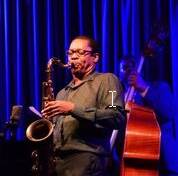 | Ravi Coltrane gets newest jazz mecca off to a classy start
|
Jazz venues in Melbourne appear to be going through a re-shuffle: the long-established Bennett’s Lane held a closing down session then re-opened with a makeover under a new owner.
That club’s previous owner is working on a new jazz venue in the Brunswick area, and the smallish Uptown Jazz Cafe runs regular jazz sessions as does Dizzy’s in Richmond. But none of the existing venues can compare with the style and opulence of Bird’s Basement, which opened this week
Devoted to jazz, Bird’s Basement has table seating for 200 and is designed to provide excellent acoustics and line of sight from every seat. Meals are prepared by Italian chef Gigi Buono
It is literally a basement, in Singers Lane off Latrobe Street. The theme is a soft darkish blue with a reflective glass ceiling high enough to dispel any feeling of being below ground. It’s all down to the vision and financial backing of Melbourne developer and jazz enthusiast, Albert Dadon
At the launch party on Monday night, Dadon introduced Gianni Valenti, proprietor of New York’s famous Birdland venue, with whom it will exchange artists. “This city now has a permanent jazz festival,” said Dadon, who later took the stage to lead his fusion quartet Urban Grooves Project on guitar. His group will appear at the venue every Sunday
On Tuesday, the venue opened its doors to the public with a top jazz name from New York: Ravi Coltrane, whose quartet will be running nightly through until March 6
There were a few predictable first night hitches in the kitchen, but this was overcome by the proprietor’s announcement that all dishes would be free of charge and also the compelling quality of Coltrane’s music
Coltrane walks his own musical path with no hint of emulating his groundbreaking father, John, or mother Alice. Nor is there any need, since Ravi — so named for his father’s admiration of Indian sitarist Ravi Shankar — is uniquely talented in his own right
They opened with Coltrane’s quick flurry of tenor sax notes in Ornette Coleman’s Bird Food, smartly punctuated by drummer Kush Abadey, before the theme was picked up, repeated and expanded by pianist Glenn Zaleski, all strongly underpinned by bassist Dezron Douglas
A standout was the group’s arrangement of the Thelonius Monk standard Epistrophy. The quartet took the original theme and turned it inside out, driving the piece with powerful climactic tension amid a torrent of percussive invention, sustained ingenuity by Coltrane and a dazzling bass solo
A slower tempo infused Coltrane’s original, Word Order, which gave a wide space to Zaleski’s marvellous piano structures of flowing melodic phrases and big strong chords. The finale, Charlie Parker’s, Segment, featured a speeding bass intro and Coltrane’s sopranino saxophone at high speed and high-flying notes, an absolute tour de force
Casting an eye over the basement’s future music reveals a spread of styles: guitarist Lee Ritenour, smooth jazz proponents Spiro Gyra, Joe Camilleri’s Black Sorrows, musicians from the Melbourne Jazz Co-Op every Tuesday, vocalist Chris McNulty, top guitar duo James Muller and Stephen Magnusson, Sydney pianist Mike Nock and many more
|
John McBeath
Previously published in The Australian February 2016 |
| Back to Index |
| 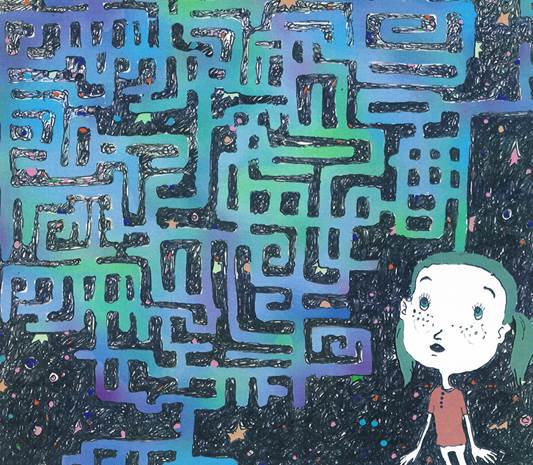 | Hi(gh) Curious - Eugene Ball 4tet (Independent)
|
Although multi-award winning Melbourne trumpeter Eugene Ball has been performing on the jazz scene for 25 years, worked as an educator for 18 years, and appeared on around 30 albums, this is his first recording as leader – in a collection dedicated to the late drummer Allan Browne
In the absence of a chordal instrument – the quartet comprises trumpet, trombone, electric bass and drums – there is an enhanced freedom with one of the brass players soloing singly or sometimes in duet with just the rhythm supporting. Ball points out that a chordless ensemble poses tough challenges for a composer, and it's interesting to imagine how different the ensemble might have sounded with added keys or guitar
There are four originals, and three others, including a sombre interpretation of Joni Mitchell's A Case of You
The album has a slightly saddening atmosphere overall, largely due to the slower tempos; only the opener P is for Pumpkin, featuring clever drum work by James McLean, and the title track, are played at a faster pace. The 'Pumpkin' track also features punchy horn solos and Mick Meagher's driving electric bass
The ballad Never Let Me Go is given sensitive treatment morphing into Ball's flaring trumpet lead underscored by the bass's arpeggio notes and a contrapuntal trombone
Ball takes most of the solos and James Macaulay's trombone captures the trumpet's mood in his own solos and supports in ensemble passages either with precise harmonised melodic notes or playing a counterpoint line. The two horns work impressively well together throughout the collection
   
|
John McBeath
Previously published in The Australian February 2016 |
| Back to Index |
| 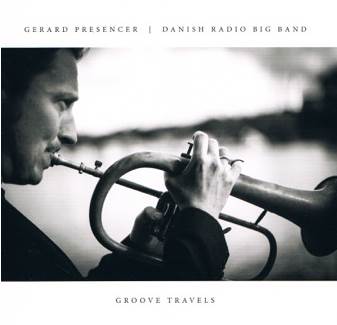 | Gerard Presencer and Danish Radio Big Band - Groove Travelers (Edition/Planet)
|
Born in London, Gerard Presencer is something of a trumpet prodigy: at age 11 he was the youngest trumpeter with the National Youth Jazz Orchestra and at 18 began playing with pianist Stan Tracey. He went on to perform with John Dankworth, Herbie Hancock, Chick Corea, Chris Potter and many others. He's won the British Jazz Awards four times and is an active jazz educator. In 2010 he became a soloist with the Danish Radio Big Band and moved to Copenhagen
Presencer says he's taken six years to get this album of his arrangements together; five of its eight tracks are originals and most feature the rich mellow tone of his flugelhorn. The sumptuous opener Another Weirdo is a relaxed piece demonstrating Presencer's compositional and arranging skills, as well as a virtuoso technique, his flugelhorn solo cutting through the precise big band scoring with great flair and invention
Blues for Des begins with a tricky flugelhorn cadenza in a West African rhythm Presencer describes as either a slow beat in three or a fast bar of seven and five. Whatever, it brings some clever percussion from renowned guest artist Cuban drummer Eliel Lazo and smart solos from the composer and Karl-Martin Almqvist's tenor sax
There are a couple of inspired interpretations of pop songs: Eleanor Rigby and I Can't Stop Loving You, plus a powerful version of Wayne Shorter's Footprints
The ensemble playing and writing in Groove Travels is sophisticated and exciting with splendid soloists and a joie de vivre obvious throughout
   
|
John McBeath
Previously published in The Australian February 2016 |
| Back to Index |
|  | Bungalow - Unseen Scenes (Studio Songs)
|
Saxophonist Mike Rivett, leader of the quartet Bungalow, is based in Cairns, studied in Sydney and New York and moved to Tokyo for a period where this album was recorded with the three Japanese jazz players of Bungalow. Rivett wrote just one of the tracks while the other musicians contributed another eight
The opener Dancing Elephant composed by drummer Ko Omura begins with a typical Japanese-sounding Taiko drum solo but when a steady rhythm is established by Hiroshi Ikejiri's bass and Koichi Sato's flowing piano over which Rivett's tenor sax floats in a minor key, the piece takes on a distinctly western-style jazz dimension, albeit with Asian influences, a characteristic that's evident throughout the collection
Rivett's piece, Absence starts with an out of tempo sax cadenza that wanders in a dreamy nostalgia before rhythm arrives and the piano provides a lengthy embellishment, introducing Ikejiri's bass solo
Respective Scene features a slow Asian rhythm overlaid with Rivett's various electronic effects, adding a tenor solo in minor mode to create a hauntingly mysterious atmosphere, which with the piano's assistance, builds to a fade-out conclusion
Omura takes up tablas on Bombay Duck where the bass supplies a regular riff until the tenor's theme gives way to strong piano statements and the tablas subside into an ultra-slow bluesy kind of sound and tempo, before re-energising for the whole ensemble
This is a highly unusual jazz album, not completely Asian, nor completely westernised jazz, but an inspired amalgamation of both
   
|
John McBeath
Previously published in The Australian January 2016 |
| Back to Index |
| 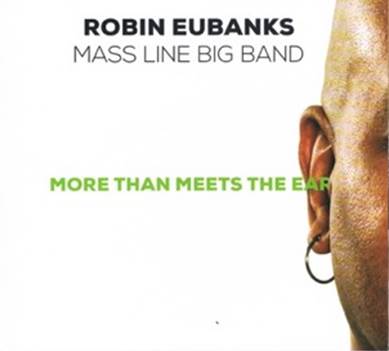 | Robin Eubanks's Mass Line Big Band - More than Meets the Ear (Artist Share Records)
|
This is the first big band album from US trombonist/composer Robin Eubanks who took a year's sabbatical from his lecturer's position at Oberlin College, Ohio to complete these works for a 19 piece band
Some of the tracks were originally written for bassist Dave Holland's Quintet, where Eubanks played for over 15 years, but he says: 'The big band allowed me to really flesh things out.' This follows Eubanks's 2014 release Klassik Rock Vol 1 exploring the incendiary rock, funk and fusion of the 60's and 70's with which the 60 year-old grew up. Several of the top-class sidemen from the earlier collection also appear here including the late trumpeter Lew Soloff in his final recording session
The title track opens with staccato horn clusters and settles into an ensemble vamp with a driving piano sequence from Glen Zaleski and a fast and fiery tenor solo by Marcus Strickland
Blues for Jimi Hendrix features Eubanks on electric trombone – an odd-sounding mix of trombone and electric guitar – a jazz rock piece with powerful echoes of Hendrix's playing, aided by organist Mike King's swirling vibrato and a heavy beat from drummer Nate Smith
The leader delivers a completely different, swinging trombone solo on Cross Currents and Soloff on an upper register trumpet excels as does Lauren Sevian at the other end of the scale on baritone sax, all pushed along by intelligent drumming
A highly-listenable album of big band mainstream swing, both raw and polished in Eubanks's comprehensive arrangements
   
|
John McBeath
Previously published in The Australian January 2016 |
| Back to Index |
| 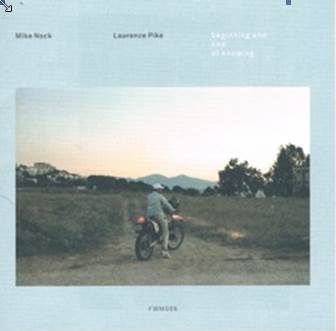 | Mike Nock and Laurence Pike - Beginning and End of Knowing (Fourth Way Music)
|
The well-established duo of Mike Nock on piano and drummer Laurence Pike released their first album, Kindred in 2012. Their latest from late 2015 is recorded at a very high level of fidelity at the famous Rainbow Studio in Oslo, Norway and produced by Pike
Nock says the studio's attention to detail was detailed and comprehensive: Pike played a drum set donated by Jack de Johnette and Nock's grand piano had been completely dismantled and overhauled for the sessions
The twelve tracks were totally improvised without any prior arrangement or even discussion: the two players sat at their instruments and began playing. Probably the best way to listen to the collection is to do the same, starting with the opening title track and letting the sequence unfold. The sound quality of Pike's drum intro is astonishing, and no less is the piano when it arrives in a wandering abstract passage. Surprising also is the degree of empathy and musical understanding between these two players
Track two, Cloudless begins with a series of stately piano chords as drums remain silent until just bass drum and cymbal start to add profundity to the atmosphere. Each of these pieces has its own character and meaning until the finale In Closing achieves a sumptuous and elegant conclusion
There are aspects of jazz, classical, and musical narrative throughout this impressive and impromptu collection where the drum kit is not often used rhythmically, but adds colour and punctuation to the piano's ceaseless invention
   
|
John McBeath
Previously published in The Australian January 2016 |
| Back to Index |
|  | Jeremy Rose Quartet - Sand Lines (Earshift Music)
|
Sydney saxophonist Jeremy Rose has been working with the musicians on his latest album for the past ten years, and these six lengthy pieces were developed over a two year period, but Rose is also very active in a variety of other groups: The Vampires, The Strides, Compass Quartet, Cameron Undy's 20th Century Dog, Ensemble Offspring, and Earshift Orchestra. Amongst numerous achievements Rose has scored a Bell Award, and this year won an APRA AMCOS Professional Development Award worth $15,000
The title track is a good introduction to the collection of originals, with Jackson Harrison's opening piano flourishes and the delectable upright bass notes of Alex Boneham – who's since relocated to Los Angeles – ahead of one of several themes stated by Rose's soprano sax with rhythmic punctuation from drummer James Waples. All of this serves as a build-up intro for Rose's lift-off solo of swirling excitement aided by Harrison's substructural chord stabs, before a curling piano solo travels on with ceaseless invention
Guitarist Carl Morgan is a guest artist on two tracks including The Long Way Home, a slow ballad that wanders expressively adding rhythmic accents for appropriate solos from alto and guitar. Mind Over Matter is a soft post-bop tribute to the late altoist David Ades, 'a mentor, friend and fellow surfer' for Rose
Rose explains that the music uses improvised sections that build from the notated material, 'creating a blurred line between improvisation and composition', and he has assembled a group of players perfectly capable of understanding and interpreting these elegant works
    
|
John McBeath
Previously published in The Australian Dec 2015 |
| Back to Index |
| 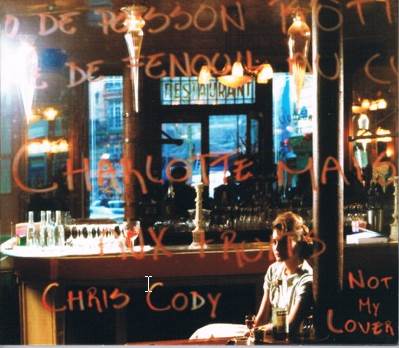 | Chris Cody - Not My Lover (Wave)
|
Australian pianist/composer Chris Cody spent 25 years based in Paris, recording nine albums and playing extensively throughout Europe often with outstanding international musicians, composing music for films and TV, and garnering many awards and accolades
Cody returned to settle in Sydney in 2014 and this quartet recording is his first release since. Although a confirmed jazz performer Cody has long had an association with classical music, playing solo and chamber music: he was a finalist in the Roger Woodward Piano Scholarships at age 14, and studied with composer Peter Sculthorpe, as well as at London's Trinity College. It's not difficult to trace classical influences in the new collection of ten tracks, of which eight are originals
For an avowed Francophile, Cole Porter's I Love Paris is probably a necessity and Cody works over the overworked standard with flair and sensitivity in a trio context with adept drum work from James Waples and Brendon Clarke on bass
The title track is a moody ballad with Karl Laskowski on tenor – he's on seven numbers – beginning in a slow tempo and cranking up to a medium groove as Laskowski leans right into the piece with fast runs and strong staccato notes as Cody supplies the foundation before breaking into a flowing solo
Scatter is a post-bop theme whose bluesy overtones are explored by both tenor and piano and abetted by Waples's astute kit work
This is an album of talented performers playing varied compositions, adding an unusual jazz piano style that incorporates interesting classical ideas and flourishes
   
|
John McBeath
Previously published in The Australian Dec 2015 |
| Back to Index |
| 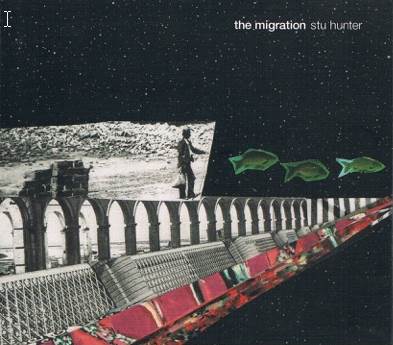 | Stu Hunter - The Migration (Habitat)
|
Sydney pianist/composer Stu Hunter produced a widely acclaimed, comprehensive work for quartet in 2007 The Muse, followed by an equally expansive and highly regarded suite for sextetThe Gathering, showcased to universal praise at the Wangaratta Festival of Jazz and Blues in 2010
Now comes a worthy successor to those earlier pieces and in some ways a continuation of them: a 74 minute musical odyssey for octet, in nine parts entitled The Migration, due to be launched at the Sydney Festival on Saturday January 9th
As with the earlier compositions this latest work achieves an almost symphonic form in its structure, using illustrative, sometimes orchestral-style formats, mood variations, and a thematic/melodic continuity all within a highly individualised jazz context
The opener, Dawn Chorus begins with a soft clock-like beat, overlaid with a pacifying ensemble theme that sounds vaguely classical even after Cameron Undy's electric bass riff and Simon Barker's drums pick up the rhythm. Led by Phil Slaters's trumpet the ensemble's melody wanders against the insistent fast rhythm drums and bass, giving way to the deep muttering of Julien Wilson's bass clarinet conclusion
A variation of the opener's infectious rhythm continues in track two Eagle Fish, with a strong piano pattern leading the ensemble as Matt Keegan's baritone sax breaks into a raucous rollicking solo, followed by the piano's ongoing building bounce and excited stabbing chords from the group's voicings to conclude with a brilliant solo electric bass passage
Three of these nine movements feature a solo vocalist: two by Tina Harrod and one from Katie Noonan. In each of these arrangements the voice is treated as a solo instrument and the poetically abstract lyrics – also by Hunter – are supplied in the cover notes. Twelve Stages of Freedom features an ethereal Noonan with her astonishing range, adding a high-treble duet with the clarinet of Julien Wilson, who also provides a solo
One of Harrod's two contributions, MDU Moonshine has a New Orleans soul element that fits well with her vocal style and features a blast-off trombone solo from James Greening, another on alto clarinet by Matt Keegan plus Carl Dewhurst's wailing guitar, while Hunter's piano punches a near-boogie ostinato along underneath throughout
The closer Land of Gypsies, clearly influenced by the broad genre of European Gypsy music, makes good use of James Greening's tuba establishing a Romany groove along with Hunter's travelling piano, while Dewhurst's lift-off guitar solo reaches into Pat Metheny territory against speeding piano and classical high-note flourishes from clarinet and tenor sax
High praise is due to Hunter for this third edition of his extensive compositions and for his vigorous piano work on the recording, and also for the seven other top level musicians and two outstanding vocalists who've interpreted this monumental work
    
|
John McBeath
Previously published in The Australian Dec 2015 |
| Back to Index |
|  | David Ades - A Life in a Day (Lionshare Records)
|
It’s hard to imagine a more poignant recording than this final album from British-born, Australian saxophone giant David Ades (5/10/61 – 8/11/13) even before the outstanding compositions and musicianship are experienced
Against medical advice and suffering a terminal condition Ades flew to New York in August, 2013 to record one last album with the same US personnel from his 2012 album, A Glorious Uncertainty
Ades’s sister Ruth records that he composed tunes for the album every afternoon, overcoming terrible pain: ‘. . . for David, a churning, insuperable will to create music always trumped reason .’ The album was recorded in one five hour session on September 18th 2013
Due to the background of this album and its sheer musical force it’s impossible not to be profoundly moved by it
Thanks are due to Melbourne saxophonist Julien Wilson who played a central role in packaging and releasing the album on his own label
The opener Slow Song features a cadenza of Ades’s alto sax with just Mark Helias’s bass and Gerald Cleaver’s brushwork as the alto soars and leaps for over three minutes before Tony Malaby’s tenor joins in for the two horns to drawl a seductively lazy theme
A brighter tempo pervades Removab with the two saxes interweaving powerfully, while Arco and Alto, true to its title begins with just bowed bass and alto, out of tempo in a mysterioso duet, moving into a rhythmic section with plucked bass, eventually joined by the tenor
This might well qualify as the jazz album of the year
    
|
John McBeath
Previously published in The Australian November 2015 |
| Back to Index |
| 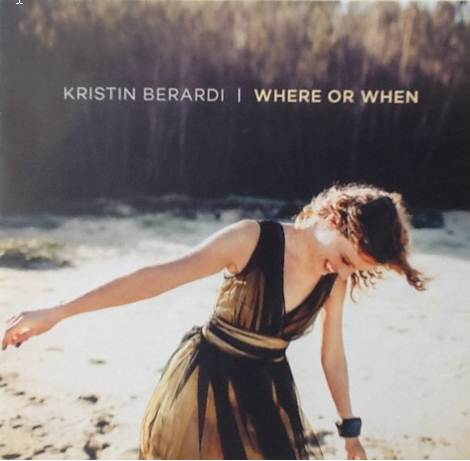 | Kristin Berardi - Where or When (ABC/Universal)
|
Brisbane-based vocalist Kristin Berardi has won numerous awards, released six albums with various bands, and since 2011 has often appeared with guitarist James Sherlock who joins the quartet backing on this latest album. Four of the ten tracks are Berardi originals
The perfect pairing of vocalist and guitar is softly demonstrated in Leonard Cohen’s Suzanne, while Steve Newcomb’s piano takes the major accompanying role quietly supported by Sam Anning’s bass and Sherlock’s guitar in Mel Tormé’s sorrowful Born To Be Blue
The title track and opener, Where or When is a medium-tempo standout with Berardi wisely not attempting to imitate any of the hundreds who’ve also recorded this Rogers and Hart standard. She gives the song her own phrasing interpretation and prudently allows solo space for guitar and Julien Wilson’s nimble and scintillating tenor sax
Pat Metheny’s unusual and challenging melody Unity Village is given lyrics by Berardi and begins eloquently with vocal and guitar as bass and piano join to support the high-climbing, swooping theme
The standard Cool Baby features a series of solos by piano, guitar, sax, bass and vocalist where each picks up an end phrase from the previous instrument and drives it further, Berardi scatting her contribution
The solo vocal opening to Young at Heart demonstrates this mature vocalist at the very top of her craft. The album also illustrates just how well a quartet of foremost musicians can work with and supply breadth and depth both behind and alongside a vocalist
   
|
John McBeath
Previously published in The Australian November 2015 |
| Back to Index |
| 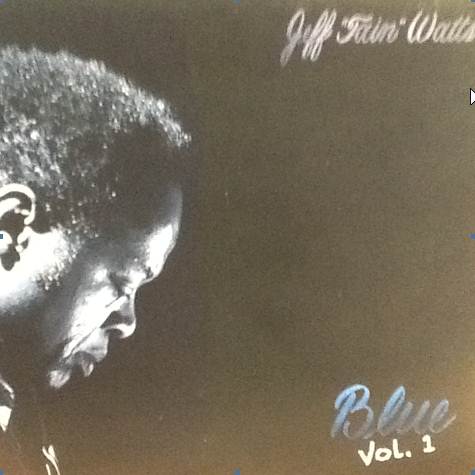 | Jeff 'Tain' Watts - Blue Vol 1 (Dark Key Music)
|
These nine tracks feature groups of varying size and instrumentation led by US drummer Jeff 'Tain' Watts and recorded in the drummer's home state, Pennsylvania. Best known for his 24 year long association, until 2009, with the Branford Marsalis Quartet, Watts has played with a wide range of top names including, Michael Brecker, Terence Blanchard, Kenny Garrett, Wynton Marsalis, Ravi Coltrane, McCoy Tyner, and won many awards including six Grammys.
Watts writes most of the material for the recordings on his own label, Dark Key Music,and has penned six of the tracks. One of the exceptions is the opener, Thelonious Monk's Brilliant Corners arranged in altering tempos by Watts for a quartet with saxophonist Troy Roberts, pianist David Budway, and bassist Neale Caine. Beginning with a heavy backbeat the opening track slides into a slow, bluesy phase with smart tenor work from Roberts and continues alternating tempos for Robert's thoughtfully swinging phrases, giving way to equally robust piano sequences, and always with Watts's energising rhythms
Farley Strange brings on an octet plus seven vocalists, including Watts's wife Laura. This mix of voices starts up mentioning 'Gumbo' – a New Orleans dish and type of blues marching music – before launching a version of the music complete with tuba, vocal choruses, solos, and a driving beat from Watts
The closer reverts to the opening quartet for another Watts composition, Reverie a slow ballad with lyrical work from Roberts's tenor, pensive piano, and Watts working the brushes to great effect
   
|
John McBeath
Previously published in The Australian November 2015 |
| Back to Index |
| 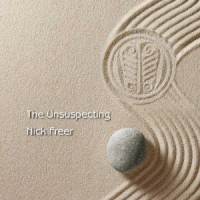 | Nick Freer - The Unsuspecting (Independent)
|
Australian guitarist Nick Freer has taken a turn in the direction of fusion, the rock and jazz hybrid, with his latest release The Unsuspecting. That turn is with a juicy atonal twist, by his approach to harmony with the composer Schoenberg strongly in mind. The challenge of melodic atonality or melodic post tonality, is really in the ear of the beholder and I suspect this will be a challenging listen for both mainstream jazz and mainstream rock listeners but very exciting for listeners seeking super-charged sounds made even more visceral than The Subterraneans or Mark Costa’s Textures. Make no mistake, Freer’s playing is impressively agile and refreshingly original, while the thrust of these originals is driven by master drummer Andrew Gander. Freer the composer, is joined by Sean Wayland who adds his talent to three originals in meter signatures made even more jagged in the hands of Gander. Carlo Barbaro is on saxophone and bass clarinet, as is bassist Matt Clohessy and Phil Turcio also on keyboard. Metheny, Corea and Holdsworth fans take note
   
|
Peter Wockner
|
| Back to Index |
| 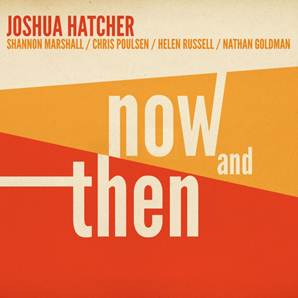 | Joshua Hatcher - Now and Then (Independent)
|
If you, as I did, enjoyed the debut albums by trumpeter Warwick Alder and bassist Craig Scott on Rufus Records, then you’ll enjoy the debut release by Brisbane based saxophonist Joshua Hatcher. The original compositions by the tenor player hark back to the late 1950’s and 1960’s Blue Note era. Authentic original composing influenced by a by-gone era or exclusively written for the classic jazz quintet instrumentation of the period, is a rare pursuit for very few Australians, making this quite an ambitious offering. Joining him on the outing is a talented band made up of Shannon Marshall on trumpet and flugel, Chris Poulsen on piano, Helen Russell on bass and Nathan Goldman on drums. Hatcher’s compositions are well crafted contemporary visions on an era of jazz that almost all lovers of the music enjoy. His easy but assured tenor sound is darker and contemplative rather than piercing and suits these relaxed medium tempo swinging pieces. ‘Succession’ has embellished harmonies reminiscent of Horace Silver, while ‘Forgotten Languages’ is darker and Tyneresque. ‘I’m Not Myself’ is Blakeyesque and displays both Marshall’s and Hatcher’s agility when needed in the front line. Much more than the sum of its parts, this group sounds like a seasoned band and Hatcher’s arrangements beautifully balance the scales by straddling ensemble playing, solo work and group interplay.
   
|
Peter Wockner
|
| Back to Index |
| 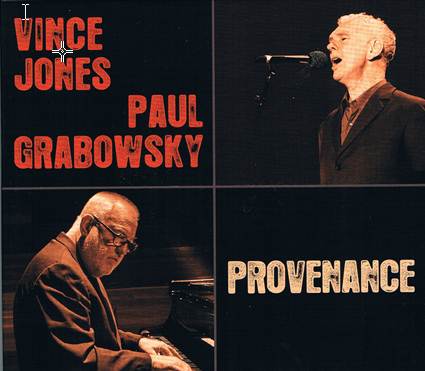 | Paul Grabowsky and Vince Jones - Provenance (ABC/Universal)
|
| |
| 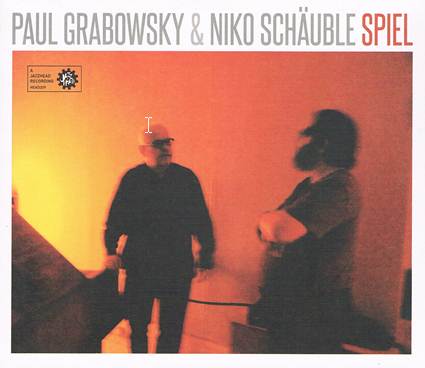 | Paul Grabowsky and Niko Schauble - Spiel (Jazzhead)
|
In terms of Australian jazz and piano/composition, the foremost name must be Paul Grabowsky. Although Melbourne-based Grabowsky seems to defy localization: he could be recording in New York, Europe, or Australia, recently gave concerts in Cairns, appeared at the Wangaratta Jazz Festival and toured nationally launching a new CD.
One of two new releases is a duo recording by Grabowsky with long term drumming associate Niko Schauble, The absence of bass or guitar in rhythmic numbers could put pressure on a pianist’s left hand, but Grabowsky coasts through 17 totally improvised pieces with matchless ease and ceaseless invention
Some tracks are almost out of tempo and flow in a semi-classical way as Schauble provides soft effects with brushes. Pieces with a pulse are provided with either a running single note bass line or rhythmic left hand chords, and drums fit perfectly
Provenance has Grabowsky accompanying long-established vocalist/trumpeter Vince Jones in a collection of ballads, several of which have lyrics by the vocalist. Some of Jones’s many fans – he’s sold over 200,000 albums – who might have suspected that the 61 year old was approaching his use-by date will be surprised at the vocal dexterity and expressive ability here. His delivery of the tricky melody in Stella by Starlight is passionately eloquent. The same applies to the Joabim original If You Never Come to Me, and Harry Warren’s This is Always. Of course Garbowsky’s sympathetic accompaniment is faultless throughout
These two new examples of Grabowsky’s mountainous work are both worthwhile additions to his fast-growing output, here in disparate duos with drums or vocalist
Spiel    
Provenance    
|
John McBeath
Previously published in The Australian Oct 2015 |
| Back to Index |
| 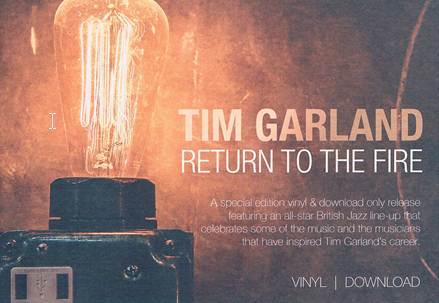 | Tim Garland - Return to the Fire (Edition/Planet (Vinyl & digital only))
|
This six track album from UK saxophonist Tim Garland marks the reunion of the original British band that recorded Enter The Fire in 1997. Garland has performed widely in the UK and toured internationally, occasionally with legendary pianist/composer Chick Corea, a continuing collaboration
None of the previous album tracks are repeated here but four of the numbers are Garland originals with the title song, a post-bop theme, taken at the liveliest tempo with driving solos from pianist Jason Rebello, Gerard Presencer on trumpet and Garland’s fast-leaping tenor
Taken at a slower pace the classic ballad Lament, by trombonist J. J. Johnson is a deliciously unhurried piece with an extended lyrical passage from Garland’s soprano sax with sympathetic piano backing
Garland also plays soprano on his composition Valse for Ravel where the theme features trumpet and soprano in a semi-classical duo with piano. Long considered a foremost performer on bass clarinet, Garland takes up that instrument for another of his originals, All Our Summers, executing some ingenious counterpoint with Ant Law’s guitar plus Rebello’s propulsive contributions on fender Rhodes
McCoy Tyner’s Search for Peace receives the ballad treatment it warrants with all the virtues of the swing and ethos of the sort of acoustic quintet celebrated in the Miles Davis bands, again with the fitting solo work of Garland’s tenor
In many ways this album pays homage to a potent time in jazz history with the classic sound of a sax and trumpet jazz quintet of yesteryear presented and updated by some of the UK’s top-flight musicians
   
|
John McBeath
Previously published in The Australian Oct 2015 |
| Back to Index |
| 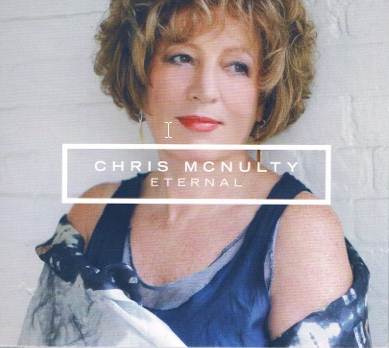 | Eternal - Chris McNulty (Palmetto Records)
|
There are two back-stories to this, the seventh album by Australian vocalist Chris McNulty who’s been New York based for almost 28 years. The most poignant is that the album celebrates the life of her son Sam – aka hip-hop artist/composer Chap One – who passed away in 2011. The singer notes that the time since that event has been the hardest of her life
The second point is that in an attempt to start afresh McNulty is moving back to Australia in October to reside in Melbourne
Eternal is a superb amalgamation of an award-winning vocalist, a chamber ensemble orchestrated by Brisbane pianist/arranger Steve Newcomb, and a jazz quintet, arranged and led by pianist John Di Martino who adds several appropriate solos
The songs are mostly classics, some not so well known, plus a McNulty original. The opener, The Saga of Harrison Crabfeathers is a not often heard song with perfectly suitable lyrics of lament exquisitely delivered, and includes a soft wordless passage: a deeply moving experience, as are all of these heartfelt songs
What Are You Doing The Rest of Your Life takes on an ethereal quality as the chamber ensemble of strings and woodwinds underscores McNulty’s elemental outpouring and Matt Jodrell’s trumpet brings a solo of cosmic intensity
Stardust; Nature Boy; On a Clear Day; Where Is Love; indeed all 12 of these songs are elegantly produced and sung with McNulty’s uniquely emotive vocal interpretation, including an impressive upper-register reach
This is an unforgettable collection of songs of sorrow but with a beauty that ultimately achieves a transcending quality
    
|
John McBeath
Previously published in The Australian Oct 2015 |
| Back to Index |
|  | Frances Madden - If This Were a Dream (Independent)
|
After a single sitting this album might seem like a light-hearted affair steeped in soft pop with some jazz inflections. Indeed it is an album worthy of broad airplay on smooth jazz stations if only for Madden’s ability to straddle both innocence and command on Bacharach and David’s This Girl’s in Love or the earthy groove of Wade in the Water, a tune successfully commercial for Ramsay Lewis in the 1960’s. Eight of these thirteen are Madden originals and they are impressive tunes suited to Madden’s pop vocal sensibility. The breathy Haunting Melody is a case in point, haunting and infectious. Madden’s talent stretches to piano and her jazz chops come into focus when she embellishes melodies or accompanies an impressive line-up including Ian Cooper and Ray Cassar. A versatile song-writer, Madden’s Summer’s Song could have been written in Tamworth such is its romantic twang. Frances Madden is a talent and this debut is sure to attract wide appeal
  
|
Peter Wockner
|
| Back to Index |
|  | Orbiturtle - Sakura (Studio Songs (Japan))
|
Sakura (Cherry Blossom) recorded in Japan by Studio Songs, a jazz label begun in 2009, initiates a collaborative project between Australia and Japan, and features a quartet with two musicians from each country. Pianist Steve Barry, saxophonist Dave Jackson and drummer Ko Omura all studied together at Sydney Conservatorium of Music and have been developing their creative concepts over several years. They’re joined by veteran Japanese bassist Yoshio Suzuki
Barry’s title track composition is the opener in an energetic 5/4 groove, providing a perfect vehicle for Jackson’s cerebral exploration on alto, supported by big, strong piano chords and Omura’s emphatic drum kit. Barry’s own solo swirls, weaves and flows spiritedly around the extended harmonies
Omura’s piece Lonely Specs is a waltz with a pretty melody on which Jackson’s alto floats beguilingly, leading into a fugue-like beginning of a piano solo which continues with ceaseless invention. Another of the drummer’s compositions, So Long opens with a solo piano cadenza before the main theme with its evocative minor third structure
Jackson has contributed two originals: Pirouette where the alto spirals and twirls as the title predicts, and Into Stellar in a slower tempo at first for the abstracted alto’s constructed flight ahead of the piano’s solo, increasing speed, and Suzuki’s inventive bass sequence
The closer, Codaesque, by Barry is a slow, twelve bar traditional bluesy number with another articulate bass solo and the ensemble otherwise staying on the expressive melody to conclusion
It’s a fine musical collection and an inspiring example of international jazz co-operation in performance and composition
   
|
John McBeath
Previously published in The Australian Sept 2015 |
| Back to Index |
| 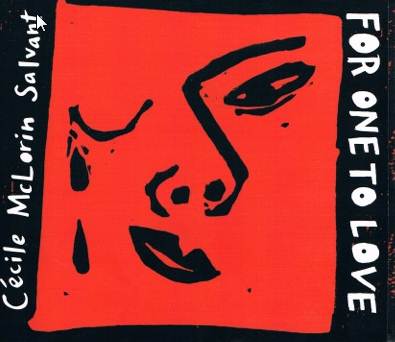 | Cecile McLorin Salvant - For One to Love (Mack Avenue/Planet)
|
US vocalist Cécile McLorin Salvant burst onto the jazz scene winning the 2010 Thelonius Monk Competition. She has a varied background: born and raised in Miami, Florida of a French mother and Haitian father, she moved to France in 2007 to study law as well as classical and baroque voice
This is her third album and as in Woman Child in 2013 – a Grammy nominee for Best Jazz Vocal – backing is led by the brilliant pianist Aaron Diehl. She’s appeared at various festivals and performed with a great many top jazz names. All this at just 25 years of age
McLorin Salvant specialises in unique interpretations of lesser-known and scarcely recorded jazz and blues compositions plus her own originals, often utilising jazz inflected theatrical portrayals
Five of the current twelve tracks are originals, including the opener Fog in a breathy vocal style perfectly depicting a misty scene ornamented by a suitably murky piano
Of the better known songs Stephen Sondheim’s Something’s Coming receives lengthy variegated vocal treatment with a compositional piano solo, a bass interlude from Paul Sikivie, and energetic support from drummer Lawrence Leathers. Judy Garland’s 1947 hit The Trolley Song gets a clever modernistic makeover, but also contains a salute to the original
What’s The Matter Now could easily slip into bluesy satire, but doesn’t because of McLorin’s superbly swinging phrasing and Diehl’s post-modern barrelhouse piano. Underling is a standout original with its multi-hued vocal expression and soft, high register leaps
Another very impressive album from a worthy successor to the Holiday/Vaughan/Fitzgerald lineage
   
|
John McBeath
Previously published in The Australian Sept 2015 |
| Back to Index |
| 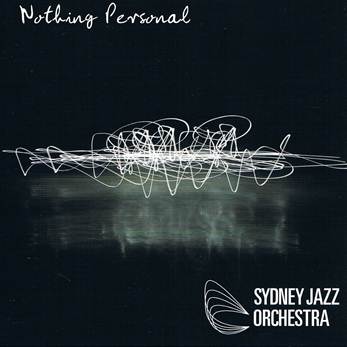 | Sydney Jazz Orchestra - Nothing Personal (Independent)
|
This 17 piece Sydney big band, led and arranged by saxophonist Tim Oram, features numerous high profile players and includes substantial solos, but never loses sight of its swing heritage, albeit in modernistic terms
The title track opener written by US pianist Don Grolnick opens with piano flourishes from Michael Azzopardi, and after ensemble passages moves into a swinging, fast flowing piano solo. Lead trumpeter Simon Sweeney contributes a solo in the same rhythms: half time, then a tempo doubling, a characteristic of the composition, before a call and response conclusion
An Oram original Too Funky For The Colonel is a shuffle-piece reflection of Oram’s time in a RAAF band and features Richard Maegraith’s funky spot-on tenor solo, as well as a trombone blast-off from Mark Barnsley and Tim Crow’s high-reaching New Orleans trumpet
John Coltrane’s Naima, begins introspectively with David Stratton’s mysterious out-of-tempo bass guitar proceeding into a Latin rhythm established by drummer Jamie Casistros for the large ensemble’s forceful statements and sympathetic solos from Maegraith and trumpeter Robert Campbell. A second Coltrane piece Impressions ceartainly has an impressive tenor cadenza by Craig Walters and strong ensemble arranging.
Shapes, an evocative piece by Sweeney includes a quick running tenor solo from Walters and the always engaging Azzopardi piano, plus alternating, sometimes overlapping section work between brass and reeds
Tim Oram’s impressive arrangements maintain a modern big band feel without straying into ‘out there’ territory, and employ interesting section playing. A range of material is ably delivered with more than a few notable solos
   
|
John McBeath
Previously published in The Australian Sept 2015 |
| Back to Index |
| 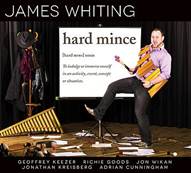 | James Whiting - Hard mince (Independent)
|
With the absence of recording contracts for jazz artists, crowd funding has become a worthwhile alternative for artists to attain 'buy in' by replacing a record company’s investment with consumers’ dollars. This is the vibraphonist James Whitings second album after only seriously initiating a jazz pursuit in 2007. Recorded in Brooklyn on none other than Joe Locke's instrument and on the back end of a fleeting visit, the project had sufficient merit to attract some serious jazz talent. Guitarist Jonathan Kreisberg adds weight to four of the 10 tracks. Dancin Fool's hard bop head is played in unison with guitar and vibraphone before Kreisberg's agile solo is followed by Geoffrey Keezer crafting a slick contribution on piano with a rapid machine gun like attack heightening the senses to the serious drama inherent in this music. Strong doses of funk make this a highly accessible album and a melodic approach by Whiting is pleasing to the ear without compromising artistic merit. Australian expat saxophonist Adrian Cunningham makes two soulful contributions most notably on the anthem like ‘Right Place ,Right Time’ which seems a fitting way to book end this collection of Whiting originals captured on a remarkable Brooklyn recording date
   
|
Peter Wockner
|
| Back to Index |
| 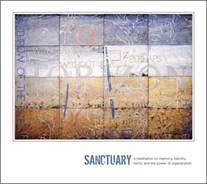 | Gary Daley - Sanctuary (Independent)
|
I wrestled with this one longer than I thought I would
I wrestle with them all, to a degree, but Sanctuary – the new one from Sydney composer/pianist/accordionist Gary Daley – took more time and listening and thinking and re-listening than any of the others
Much of it is that Sanctuary is big, very big in every way: the themes, the emotion, the ensemble writing, the very breadth of its conception… big and hard to wrestle to the page
Much of it also is that music such as this can knock the wind out of my diaphragm, by simply reminding me how far the word falls short of the music – it turns my tongue (and pen) into a wooden clapper. But we can only work with the tools we are given. So…
The core of the Sanctuary suite – and a suite of pieces it is – is Daley’s experience of caring for his mother who was slipping into Alzheimer’s. The ‘sanctuary’ of the title is the comforting world of memories Daley and his family worked to build for her during her suffering
And yet, in the midst of this dark time, Daley’s first grandchild was born. A little candle in the void. And a powerful reminder of life’s extremes – merciless ravage and sweet new bud
To express these big life ideas Daley has, across Sanctuary, gone for the primal and the spiritual – the earthy and the ephemeral – in almost equal balance. We have the astounding ‘Introduction,’ with James Daley’s rough hewn field holler shout-sung over a Ligeti-like pulsing chord; a howl in the hollow of the cold universe, but a strong, life-grabbing howl, nonetheless
We have the afro-groove of ‘Mandolin’ – with its opaque and bluesy Jess Green guitar solo – and the joyous hoe-down of ‘Kindred Chant’, led by the clearwater lap steel of Bruce Reid and Veronique Serret’s fiddle. The hoe-down opens out into the colour-field painting that ‘Interlude No 2’ is; Brett Hirst’s bass, bowed and pizzicato, singing a song of colours overlapping colours.” Green and James Daley sing the folk traditional song ‘The Wandering Boy’ like a Shaker hymn – hardwood pews, cold country chapel, bare to the bone melodically and emotionally. The song tells is of the unique connection between mother and son and needs no prettying up; in some way this makes ‘The Wandering Boy’, with simpatico accordion and National Steel, the heart of Sanctuary
So we are pulled back and forth across the themes and compositional/improvisational spaces of Sanctuary– floating dissonances here, a boinging jaw-harp there, slide steel melisma, Indian sliding melody, blues, 6/8 Cubano. The astonishing Paul Cutlan growls and yodels out of the middle of ‘Time and Place’. James Daley speaks the words of ‘The Wandering Boy’ over Bartokian blue-grey and smudged turquoise strings in ‘Interlude No 1’
And yet the suite holds sweet – Daley’s sense of balance and reticent drama puts each thing after each thing in an order that heightens and enriches the drama of this sad-happy journey through his themes of pain and regeneration
I knew when I found myself wrestling with Sanctuary that it was worth it. Like all works that earn the name Art, it takes some work, no mistake. If only all work could have such a rich result
|
James Hardaker
Previously published on Australianjazz.net |
| Back to Index |
| 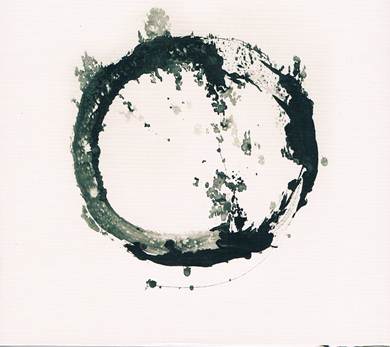 | Aaron Diehl - Space Time Continuum (Mack Avenue/Planet)
|
Following his 2013 tribute to the Modern Jazz Quartet The Bespoke Man’s Narrative, New York pianist Aaron Diehl has released a jubilant new trio album featuring several guests including two octagenerians
Six of the eight tracks are Diehl’s refined and intricate originals and played with his exquisite touch and phrasing
Art Blakey’s 70’s piece Uranus is the opener by the trio with drummer Quincy Davis perfectly emphasizing and elaborating on the theme before Diehl’s richly woven solo introduces his long-term associate David Wong’s quick-moving bass sequence
One of Duke Ellington’s ex-personnel, Joe Temperley on baritone sax, now aged 85, appears to solo with rhapsodic intensity on The Steadfast Titan. A second saxophonist in his eighties, Benny Golson is an album high point with his upbeat, swinging solos on Organic Consequence, and paired with the young effervescent trumpeter Bruce Harris
Kat’s Dance, a kind of Bolero in 6/4 introduces a third saxophonist, Stephen Riley, on tenor, who plays in a pleasant, breathy style reminiscent of jazz in the sixties and Diehl’s piano plays a complicated and precise accompaniment
Broadway Boogie Woogie inspired by the Mondrian 1943 painting is not a boogie, more like a high speed Bud Powell piece
Diehl’s widespread activities have included backing major vocalists Cecile McLorin Salvant and Charenee Wade. Wade is included here on the title track singing blues-inflected verses straight out of the Betty Carter songbook with embroidering from Golson and Harris, transitioning into a faster beat for solos from everyone
Diehl has produced an album of high-level, detailed musicianship, a collection of style and substance
   
|
John McBeath
Previously published in The Australian Aug 2015 |
| Back to Index |
| 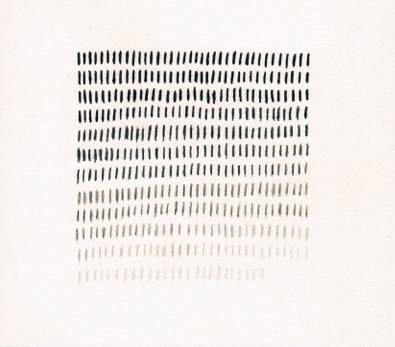 | Tim Willis and The End - Night and Day (Newmarket)
|
This third album in the recorded life of Melbourne guitarist Tim Willis’s The End expands the group from a quintet to an octet, retaining Willis and bassist Gareth Hill plus the instrumentation from the previous band and adding a second guitar, trumpet and piano
Six of the eight Willis originals were written for the PBS 106.7 Young Elder of Jazz Commission in 2012 carrying a $10,000 award, and premiered at the 2013 Melbourne International Jazz Festival
Liner notes describe the music as blending genres of jazz, post-rock and minimalism, drawing on influences from John Adams, Phillip Glass, Steve Reich, and The Necks. All of those wide-ranging influences are certainly present in varying degrees
A hastening jazz-rock rhythm driven by bass and Sam Young’s drums begins the opener Night, only to fall silent as trumpet, alto and tenor – from Brae Grimes, Jack Beeche, and Kieran Hensey respectively – reiterate an insistent four chord theme over the re-emergent rhythm. Two guitars join the mounting climactic as the rhythm section disappears again leaving the horns floating Reich-like to introduce a wild, heart-stopping alto solo with jabbing contributions from everyone
Throughout the album good use is made of diminutive scoring and interstitial silences to promote various moods: somber, murky, melancholy, or sometimes lightness and joyful expectation
These compositions and arrangements are of a high and unusual order, if occasionally verging on the repetitive. The overall atmosphere is one of building tension and portent, skillfully illustrated in an original style of music
   
|
John McBeath
Previously published in The Australian Aug 2015 |
| Back to Index |
|  | Robert Burke - Power of the Idea (Jazzhead)
|
With performers from Monash’s Sir Zelman Cowen School of Music: Assoc. Professor Robert Burke on saxophone, pianist Professor Paul Grabowsky, plus two lecturers, and adding two of New York’s foremost players this recording can’t fail to exemplify its title to demonstrate all-powerful jazz ideas
The nine sextet originals – five by Burke – were recorded late in 2014 at Acoustic Recording, Brooklyn, New York, and Burke says he gave no instructions re artistic direction in improvisations; these were connected to the central ideas as a basis of the musical conversation
Burke’s Mercurochrome opener travels along its irregular theme impelled by Nasheet Waits’s underscoring drum beats before racing sax and Paul Williamson’s high-reaching trumpet begin to wander in free improvisation. They’re soon joined by Grabowsky’s chords, Mark Helias on bass and Jordan Murray’s trombone and then re-joined by Waits’s drums in a forceful solo
The sole Grabowsky piece, Abandon uses a short piano trio intro ahead of the horns’ theme statement leading into another high register trumpet solo as bass, drums, and the piano’s insistent chords push it along to launch a rough, talkative trombone, and a lengthy energetic drum sequence
Freebopcom by Murray investigates its title with a post-bop theme from the horns with piano ornamentation transiting into a robustly swinging bass interlude, Burke’s hoarsely investigative tenor, and the piano alternating between a riding flow and atonal chord hits
This is a ground-breaking collection – complex and adventurous – from four Australian and two US players where the compositions and performances create the illusion that they’ve all been playing together for years
    
|
John McBeath
Previously published in The Australian Aug 2015 |
| Back to Index |
| 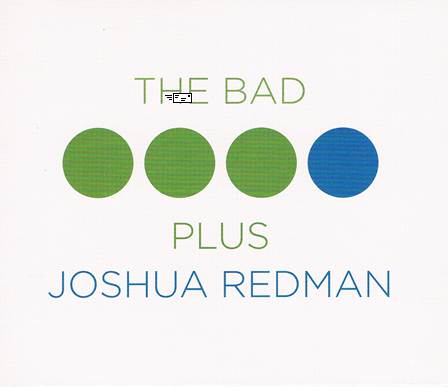 | Joshua Redman - The Bad Plus (Nonesuch Records)
|
Only one of US trio The Bad Plus’s previous 10 albums in their 20 year history has included a fourth player, and now saxophonist Joshua Redman fits genetically into their rule-breaking audacity
Australian audiences had an opportunity to hear the trio at this year’s Melbourne International Jazz festival where their new millennium rhythms, intelligently blending post sixties jazz and aspects of indie rock played to capacity houses
The new album has seven originals by trio members and two by Redman. Bassist Reid Anderson’s Dirty Blonde, something of a signature tune for the trio, opens with the ensemble’s theme statement over its darkly lurching harmonies and drummer David King’s rock rhythm. After pianist Ethan Iverson’s spaced chordings Redman’s tenor embarks on a jagged solo, followed by Iverson’s scampering piano
Iverson’s composition Country Seat begins with a fast tempo piano and sax unison theme, before breaking into a hurrying fly-over treble and thrusting chord pairs ahead of a blasting free-improv sequence from Redman
Redman’s piece The Mending, opening with the solo piano’s stately, chiming chords moves into a bluesy mode as bass and brushed drums arrive and eventually the tenor races all over the horn’s range to lapse finally into a relaxed melodic exposition of the tasteful theme
On stage the piano trio manage to project an entertaining rarity in jazz: a style of self-deprecating humour, as they play their esoteric originals with élan and great ability. The Bad Plus is a piano trio like no other and the addition of Joshua Redman makes this album attractive both to his fans and theirs
   
|
John McBeath
Previously published in The Australian July 2015 |
| Back to Index |
| 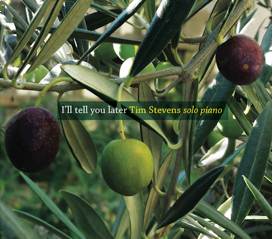 | Tim Stevens - I’ll Tell You Later (Rufus Records)
|
This is a studio recording of an earlier concert entitled Reimagining the Sacred from Melbourne pianist Tim Stevens, an esoteric collection of five pieces, titled ‘movements’, plus an encore.
Stevens is well known as a jazz pianist and expert improviser, playing with many notable jazz artists, winning numerous awards, and also studying to achieve academic music qualifications including a PhD
Each movement is an individualistic interpretation of ecclesiastical music, influenced by his days as a church choirboy
The first and second movements are themes and extensive classical extemporisations around firstly Ralph Vaughan Williams’s Kings Lynn, adapted from an English folk song, and then My God I love Thee by Charles Woods
In the third movement snappy jazz-style improvisations comprise most of John Ireland’s hymn Love Unknown where the original melody appears just for two final choruses
Stevens says his finale, Wandering The King’s Highway – an unexpected barroom ballad in a classical program – brings ‘a tennis racquet to the cricket match’ – and he plays a straight version of this rollicking tune
He explains that ‘the record is not particularly jazzy’, and that statement rings true. Apart from just a few sequences in this enigmatically entitled concert, the five movements are ruminations, and thoughtful contemplations such as the combination of two pieces: a lively, yet pastoral interpretation of William Mathias’s The Magnificat, seguing into a stately, meditative version of J S Bach’s St. Anne
These performances, boldly attributed to both Stevens and the original composer, constitute a highly personal, erudite collection that might appeal to fans of both classical and sacred music
   
|
John McBeath
Previously published in The Australian July 2015 |
| Back to Index |
| 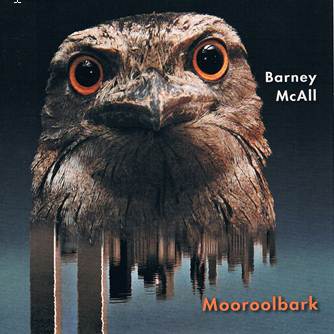 | Barney McAll - Mooroolbark (ABC/Universal)
|
After 17 productive years in New York, pianist/composer Barney McAll returned to Australia to take up the 2015 Sydney-based Peggy Glanville-Hicks composer residency
His prolific career includes performances on over 70 recordings, many of which he arranged, composed, and led, often featuring stellar international artists
Mooroolbark, a tribute to the Melbourne suburb where McAll grew up consists of nine originals, recorded at the ABC studios Sydney, and one track, Apple Tree recorded live at the 2013 Wangaratta Jazz Festival. McAll launched the album at this year’s Melbourne International Jazz Festival where his trio’s performance of Apple Tree reaching an apex of superbly timed, high level, knockout funk brought the house down
The other tracks feature McAll leading the full quintet ASIO – Australian Symbiotic Improvisers Orbit – a transcendent ensemble whose rhythm section of bassist Jonathan Zwartz and Simon Barker on drums substructurally reinforcing McAll’s piano is arguably the best in the country
Saxophonist Julian Wilson and Stephen Magnusson on guitar work together superbly interpreting these individualistic compositions which utilise dense and unpredictable harmonies, yet remain curiously melodic
A good example is Transformations, at first a moody piece deftly pairing unison piano and guitar – a guitar solo is a standout – and Wilson supplies altered tonality on alto clarinet as the piece evolves from its mysterioso piano and bass opening into staccato chords, flowing piano and a lively Latin beat
A jagged rhythm pervades February, well-stocked with pianistic ideas, as all these are, and provides a masterfully quick tenor solo from Wilson
This is an excellent collection of distinguished compositions, expertly arranged and played by some of Australia’s foremost jazz performers
    
|
John McBeath
Previously published in The Australian July 2015 |
| Back to Index |
| 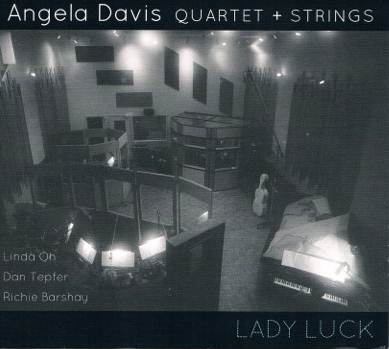 | Angela Davis Quartet and Strings - Lady Luck (Independent)
|
Following her 2013 debut album, The Art of the Melody, Australian saxophonist Angela Davis, recently returned to Australia from New York where this second album was recorded.
As with the earlier recording it features her quartet, but this time with an added string quartet, a mix that’s becoming the troupe du jour for many jazz groups. Nothing wrong with that, and this one is expertly arranged by Steve Newcombe
There are four originals and four standards including the title track, a Thad Jones composition with a smart piano solo from Dan Tepfer, as the alto floats away with the theme to introduce Linda Oh’s strong bass solo backed by the strings
Michel Le Grand’s beautiful melody You Must Believe in Spring is well-suited to the strings introduction and to Davis’s hyper-mellow tonality as she lusciously outlines the melody.
Davis’s Hymn For The Lonely, a slow and sad ballad, features an expressive beginning from piano, bass and Richie Barshay’s drums heralding the alto’s melancholy entry with the commiserating and supporting strings
Another original, Nola’s Waltz has an air of nostalgia given full reign by Davis’s honeyed tonality, and adds a faster-moving, inventive bass solo. A brighter, quicker, post-bop theme carries along A Thousand Feet from Bergen Street with Tepfer’s swinging piano solo leading into the leader’s melodic improvisation ahead of Oh’s galvanizing exchanges with the drummer
An unexpected inclusion, the Christian hymn Abide With Me, is the closer, and features the alto working through a contrapuntal passage with the piano
    |
John McBeath
Previously published in The Australian July 2015 |
| Back to Index |
| 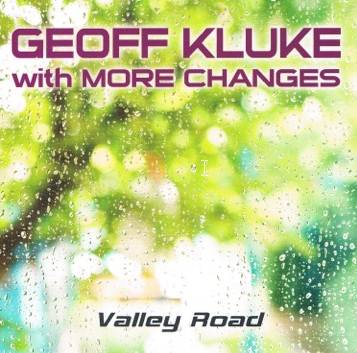 | Geoff Kluke - Valley Road (Independent)
|
This is a big production from Melbourne bassist Geoff Kluke, featuring fifteen of his compositions, and eight additional players. Broadly the style is mainstream swing with a sprinkling of noteworthy solos, including some from the leader, best heard in his two short acoustic bass pieces, Lowdown Showdown or Ziggy’s Home
The numbers are of a conventional format, often blues-influenced, and mainly serve as vehicles on which the soloists improvise. The groups vary in size from a trio of Peter Petrucci’s guitar, drummer Mike Jordan and Kluke’s bass in a guitar showcase track Song For Luke, up to an ensemble of all nine performers in one of the best arrangements, A Little Walk
The title track also features Petrucci’s guitar in a soothing, slow tempo performance as a duo with Kluke’s electric bass where both stringed instruments work particularly well together in sound and mood
Bob Sedergreen appears on about half the tracks supplying his well-known bluesy piano, particularly on Grahame’s Blues, after a rollicking tenor solo from Wilbur Wilde. Trumpeter Eamon McNellis takes the lead in another nine-piece arrangement, Correa, and contributes a capable solo ahead of Carlo Barbaro’s more introverted tenor sax
Kluke takes up an electric bass for another blues: Jaywalk with solos from David Rex’s alto, Sedergreen’s piano, and Wilbur Wilde’s funky tenor
Paul Williamson’s quick-moving baritone sax is foremost in Mr. Grunt and Kluke takes a solo on electric bass, followed by Sedergreen’s free-flowing piano. It’s another example of good ensemble arranging
This is an album of straight-ahead music that doesn’t set out to be groundbreaking, but has worthy features, and some satisfying solos from a group of professional jazz artists
    |
John McBeath
Previously published in The Australian July 2015 |
| Back to Index |
| 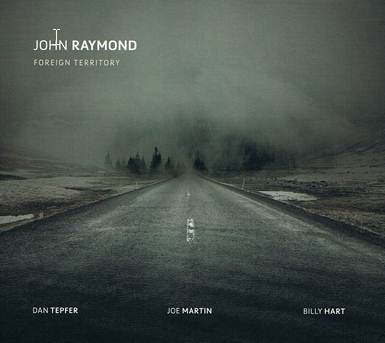 | John Raymond - Foreign Territory (Fresh Sound Records)
|
New York based trumpeter John Raymond released his debut album, Strength and Song in 2012, prompting the NY Times to name him as ‘a prepossessing young trumpet player’. This second album is less self-consciously ‘contemporary’ and draws more on the jazz tradition using Raymond’s compositions, some of which are based on chord progressions from standards
Fronting his quartet of piano, bass and drums the leader opens with the title track, which he says was the first song he ever composed entirely on trumpet, so in that sense the tune ‘was foreign territory to me.’ The piece begins with a short intro from Joe Martin’s bass and Billy Hart on drums ahead of the trumpet’s theme with Dan Tepfer’s supportive piano flowing easily into his solo exploring and extending the harmonic structure
A 24-bar blues New Blues, features a staccato trumpet opening interspersed with drum and then piano punctuation ahead of another inventive solo from Tepfer’s piano, an important supportive component throughout this album. The only non-original here is Mark Time, a composition by the late British trumpeter Kenny Wheeler; it’s a pretty ballad with a lilting theme, expressively interpreted by Raymond with his imaginative solo, eloquently climbing and descending through peaks and troughs
This is a pleasing collection from a cohesive group capable of artistic support and enhancement for the leader. The compositions are creative, well played and arranged, without trying to be world shattering, and Raymond’s playing provides interest and spontaneity
   
|
John McBeath
Previously published in The Australian June 2015 |
| Back to Index |
| 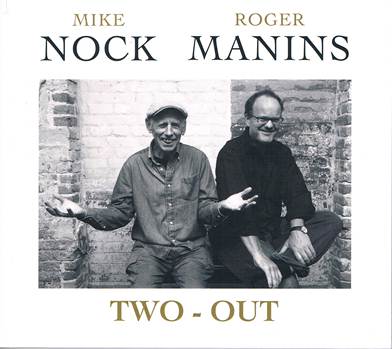 | Mike Nock and Roger Manins - Two-Out (FWM Records)
|
It’s no surprise that these two jazz titans, pianist Mike Nock and saxophonist Roger Manins, have recorded a duo album. They’re both New Zealand born – Manins lives in Auckland, Nock in Sydney – and are well-established musicians and teachers. They both have lived and played successfully internationally and worked together extensively
Each is known for their ground-breaking, cutting-edge work. What is surprising is this album’s content: eleven well-known standards delivered in ways that are accessibly melodic, yet interpretative, and at times intensely moving
The opener Falling In Love With Love sets the scene with a highly expressive rendition of the song before Manins’s solo works through the changes with a flow of eloquent ideas, underpinned by Nock’s substantial chords and ornamentation. The piano solo cleverly echoes Manin and then both embark on a contrapuntal chorus before the tuneful closer ending in Nock’s huge stabbing chord
A collection of unexpected numbers reaches an astonishing level with the Patsy Cline hit of the fifties Tennessee Waltz, where Manin’s interpretation moves into a blues-inflected waltz of soulful proportions and the piano’s supply of unpredictable chords evolves as a flowing solo dissertation of classic proportions. Never has such a trite country and western piece been given such a remarkable re-birth
The appeal of this album lies beyond just the nostalgia of these well-known songs, but in the original way they are played, preserving their original, often romantic, aspects in a style of superlative expression and sensitivity. Manin’s tenor evokes aspects of Lester Young and Joe Lovano, while Nock is reminiscent of Bill Evans
    
|
John McBeath
Previously published in The Australian June 2015 |
| Back to Index |
|  | Juliana Areias - Bossa Nova Baby (Independent)
|
Brazilian-born vocalist Juliana Areias, has been resident since 2009 in Perth, WA where this album was recorded. All twelve of these Bossa tracks were co-written by Areias and sung in Portuguese with lyrics translated into English in an accompanying booklet. The backing varies in size and instrumentation from the single, softly expressive solo guitar of Doug DeVries on Belas Artes (Fine Arts) up to seven musicians and a special guest choir of eleven voices on Meu Lugar (My Place) featuring a variety of Brazilian percussion instruments plus a surdo – an extra large bass drum – and two snare drums
The songs come in different Brazilian rhythms: bossa, samba, tango, and choro and Areias is more than capable in all of them. She has been compared to the iconic Bebel Gilberto, daughter of Joao Gilberto, in Brazil’s acclaimed EPOCA magazine
The mood is set in the opener Garoto de Copacabana (The Boy From Copacabana) with a Latin/bop sounding intro from a septet, as Areias slides into the lyrics in her rhythmically perfect and passionate vocal delivery. A piano solo from Graham Wood, followed by one on flugelhorn from Ricki Malet add contrast. Innocencia (Innocence) has solo piano behind quick vocal phrases inserted against an interesting, descendant harmonic structure, while Missao (Mission) moves into a quick samba rhythm with a bright voicing and vibrant backing
Here’s an agreeable vocal bossa album with enough variety and skilled musicianship to maintain interest, and the agile Portuguese lyrics sound exotic and romantic
   
|
John McBeath
Previously published in The Australian June 2015 |
| Back to Index |
| 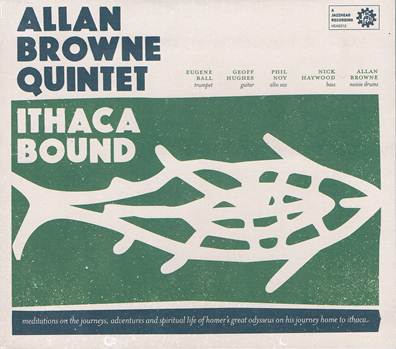 | Allan Browne Quintet - Ithaca Bound (Jazzhead)
|
This fifth CD from the Melbourne quintet led by drummer, composer, and poet Allan Browne sadly will be the last, since after launching the album at the Melbourne International Jazz Festival on June 1st, Browne died in hospital on June 13th aged seventy
He had undergone a lung transplant in 2002, subsequently releasing an album entitled Cyclosporin, the name of a drug which Browne claimed saved his life. Courageously he kept joyfully playing drums, often while connected to an oxygen cylinder. An irreplaceable stalwart of the Melbourne jazz scene, and a fascinating human being, Browne led a house band weekly at Bennetts Lane for fifteen years, and enjoyed a career in both traditional and contemporary music for fifty. His many fans will remember not only his marvellous drumming, but also his original poetry recitations.
It was his love of poetry that led to two previous original albums portraying poems by Arthur Rimbaud: A Season in Hell, and The Drunken Boat. The new album celebrates Browne’s favourite poem: Homer’s Odyssey featuring compositions from each band member in a vast and impassioned suite
On The Deck, the first of eight tracks, begins in an out-of-tempo leisurely mood with guitar, sax and trumpet notes as gradually drum rolls arrive and a rhythmic theme develops featuring Eugene Ball’s trumpet. Phil Noy’s alto sax and Geoff Hughes’s guitar join in as Nick Haywood’s bass emerges and Browne lays down a medium-slow tempo using multiple diverse effects. Noy’s masterful solo introduces another from Hughes’s hastening guitar as the whole ensemble then wanders freely to a conclusion
Noy’s composition Calypso features a post-bop theme over a subtle Caribbean rhythm and vivid solos from sax, trumpet and then guitar with ceaselessly inventive drums. Memory and Kharis begins briskly with the two horns underpinned by adroit guitar chords ahead of a lift-off trumpet solo interwoven with spectacularly effective drum stick-work.
The Lotus Eaters opens with mysterious trumpet and alto giving way to a guitar riff under some swift bass work from Nick Haywood. There are long-held cryptic harmonies from trumpet and sax while the guitar picks out a mystical motif. At the launch Browne announced that he thought this piece must have been written by Ball while ‘staring into a lava lamp.’
There is smart guitar and percussion duo work in The Suitors, as drums maintain imaginative mobility under high-register trumpet and continue during a bass solo’s added action
The finale, Peace at Last supplies a dramatic soundtrack of a steadily marching beat of bass and drums for Browne’s husky reading of the closing stanzas of Homer’s famous work from 800BC
It’s sad to realise that Allan Browne has unknowingly recorded his own epitaph, but this is a eulogy of which he would have heartily approved
    
|
John McBeath
Previously published in The Australian June 2015 |
| Back to Index |
| 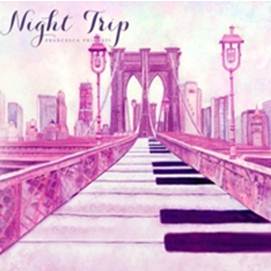 | Francesca Prihasti - Night Trip (Independent)
|
The background to this debut album from pianist Francesca Prihasti involves three countries: Indonesian born, Prihasti studied at the Sydney Conservatorium, and recorded her album in New York
The five tracks of her originals feature US musicians drummer Ulysses Owens jnr. and Marco Panascia on double bass. Sydney guitarist Nick Vardanega makes up the quartet for this collection of mainstream music with hardbop elements. The opener Nockturne (a salute to pianist and tutor Mike Nock) establishes the style: slow to medium tempos, flowing piano trio work, with solos and guitar/piano unison passages. Prihasti’s playing swings melodically and Vardanega adds sympathetic ideas in his own solos
Starting with a bluesy theme from Prihasti on Fender Rhodes in unison with guitar, The Bridge is well supplied with a rhythmic drive from bass and smart drum diacritics. Panascia’s bass provides strong grounding throughout and delivers a skillfully inspired solo assisted greatly by Owens’s percussive action
The title track maintains the mode with Prihasti’s running piano, aided by soft guitar chords and hustling drums ahead of Vardanega’s quick travelling solo and a robust, multi-varied drum sequence. Here and Now begins with a bass ostinato on the piano introducing a rapidly moving solo on double bass, followed in turn by the extempore guitar, elegant high treble piano, and finally muscular drums
This is a pleasant debut album, accomplished and tuneful, performed by a close-knit, inventive group, without pushing boundaries or aspiring to anything experimental or revolutionary
   
|
John McBeath
Previously published in The Australian May 2015 |
Pianist Francesca Prihasti stamps her own identity on this Brooklyn recording via five original compositions written in a style emanating from the legacies of Red Garland, Bill Evans and Herbie Hancock. Francesca has a slight touch on the piano on these slow to medium tempo tunes, using her left hand sparingly and focussing the listener’s attention across the broader ensemble. Two of these are fine NYC drafts, in drummer Ulysses Owens JR and Marco Panascia on bass. Originally from Jakarta and having studied in Australia, Prihasti also uses the Fender Rhodes on ‘The Bridge’ which has a leisurely loping groove and backbeat underpinning the appealing harmony. Top line bassist Marco Panascia references both Adderley’s ‘Work Song’ and Hancock’s ‘Chameleon’ in what is the funkiest of bass solos. Sydney guitarist Nic Vardanega more than holds his own with some smart ensemble and solo work. A highly accessible and honest debut reflective of Prihasti’s abiding influences.
   
|
Peter Wockner
|
| Back to Index |
|  | Myra Melford - Snowy Egret (Enja Records)
|
US pianist Myra Melford in 2014 released an acclaimed duo piano recording, Everything Here is Possible, with Australian pianist Alister Spence, winning an Australian Art Award. Here she appears leading her quintet for this New York recording of ten of her originals
While Melford is recognised as a virtuosic player with a variety of global influences, often cutting edge avant garde, she is also a deeply soulful pianist with a passionate understanding of Carribean music and the blues. There’s a wonderfully bluesy opening to the final track, The Strawberry, which evolves into a thickly chorded post-bop theme for Ron Miles driving cornet solo, followed by Liberty Ellman’s sprightly guitar, all powered by Tyshawn Sorey’s hyper-active drum work
Appropriately the tempo is lowered for Night of Sorrow as the rippling piano meanders in melancholy, adding octave-spaced high tremolos as Sorey takes up soft brushes and Stomu Takeishi’s bass guitar supplies a haunting non-disruptive underpinning. The guitar provides a thoughtful sequence, continuing while Melford takes up the melodica for a chorus
First Protest opens with quick solo piano flashes as speeding drums arrive and the piano builds frantically before dropping into a jagged theme with the cornet. Ellman’s guitar alternates between running notes and stabbing chords as the piece intensifies in a stop/start way to an abrupt finale
A lyrically precise cornet solo begins The Virgin of Guadalupe to introduce canonical accompaniment from piano and guitar leading on to a bass guitar passage of flowing beauty
This is an outstanding album of varied compositions and superior performances in both ensemble and solos with exceptional piano contributions
   
|
John McBeath
Previously published in The Australian May 2015 |
| Back to Index |
| 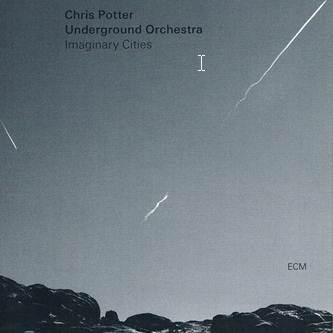 | Chris Potter Underground Orchestra - Imaginary Cities (ECM)
|
US saxophonist Chris Potter is firmly established as an internationally renowned player, voted second only to Sonny Rollins in a Downbeat poll. Potter has performed in Australia several times, most recently, and memorably, with Pat Metheney’s Unity Group in 2014. In this his eighteenth album as leader he has composed and arranged for an eleven-piece orchestra. Potter says he ‘fleshed out’ these eight compositions with a quartet and feels that playing them in a small group helped make a better orchestral result
The album opens quietly in Lament with a string quartet in chamber music mode for nearly two minutes before drums, bass, and piano arrive supplying rhythm while the tenor sax adds a melancholy theme of lyrical movement then provides thoughtful, ever-increasing intensity, in an evolving solo
The next four tracks are all entitled Imaginary Cities, each with a subtitle: Compassion; Dualities; Disintegration, and Rebuilding comprising a four part suite of an overall theme, and a vehicle for various impressive solos: guitar, vibraphone, marimba, bass guitar, piano, string quartet, acoustic bass, drums, and Potter’s tenor, soprano or bass clarinet
Three more numbers complete the album: a groovy Firefly; a jumpy eeriness in Shadow Self; and a vast cerebral excursion in Sky
Amongst many notable performers on this album full honours must go to Potter. His eloquent compositions, arrangements of superb mood and development, and his cliché-free playing with its daring and precision make this a contender for a jazz album of the year
    
|
John McBeath
Previously published in The Australian April 2015 |
| Back to Index |
| 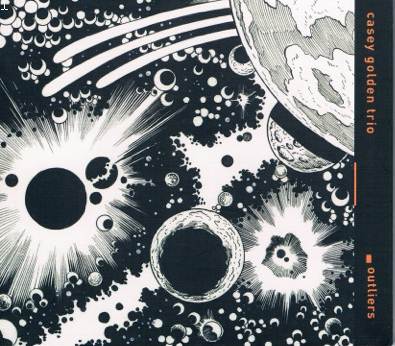 | Casey Golden Trio - Outliers (Scrampion Records)
|
The latest recording from Sydney pianist Casey Golden’s well-established trio continues to explore and expand their unique approach to jazz, infused with fugue-style classical ideas and melodic content. The collection’s title is appropriate: as defined by the OED outlier is ‘a person or thing situated away or detached from the main body or system.’ The title track is representative of the eight originals, opening with downward cascading arpeggios – highly reminiscent of a classical fugue but with added rhythm – slowing to a bridge before the theme returns for development, interspersed by Ed Rodrigues’s drums and cymbals and then a bass solo from Bill Williams
There is more interplay between drums and piano on Flatpack Empire with tempo changes, and expressive pauses. The bass has a more supportive role in Paralysed supplying a quick staccato underpinning of treble chords, before a thoughtful passage of piano improvisation and a jaunty, bouncing conclusion
Recluse continues the genre with a flowing melody against downward stepping harmonies and impetus supplied by Rodrigues’s snare drum and a stately bass line moving into a scholastic improvisation, what classicists would term ‘extemporisation.’ One short piece, Uncovered runs for just under a minute
These are highly original and commendable works, well played, but after several tracks they begin to exhibit a certain, not unpleasant, similarity of form and style. Think various Bach fugues cleverly and modernly arranged for a piano trio and set to rhythm
   
|
John McBeath
Previously published in The Australian April 2015 |
| Back to Index |
|  | Jack DeJohnette - Made in Chicago (ECM)
|
Is there a more gifted, all round musician, composer and long-established player with such a comprehensive list of jazz greats than drummer, pianist and composer Jack DeJohnette? He’s played everything from R&B to free jazz with many great names, notably Charles Lloyd and Keith Jarrett. Moving from Chicago to New York in 1964 he gigged with Coltrane, Monk, Bill Evans and many others. He played drums on Miles Davis’s seminal album Bitches Brew
This new release was recorded in August 2013 at the Chicago Jazz Festival, as DeJohnette turned 71. He’s used Chicagoans he has known for long periods: the two reeds players Henry Threadgill, and Roscoe Mitchell were his college classmates. Pianist Muhal Richard Abrams, aged 82 was the senior of the Chicago quintet, and bassist Larry Gray in his late fifties, the youngest
The concert of six lengthy, experimental compositions opens with Mitchell’s 17 minute piece Chant, a wildly improvised work growing out of a reiterative four note theme of increasing dissonance. It builds into free jazz ensemble and solos – notably Threadgill’s raw-toned alto, Abrams wide-ranging abstract piano, and DeJohnette’s powerhouse drum work accompanied by fast, raw excursions from Mitchell’s soprano sax
DeJohnette’s drumming is extraordinary throughout with his explosive solo of varied tonalities on Jack 5 especially impressive. Museum of Time is the most lyrical number where Abrams’s piano initially leads before the two horns work towards abstraction. Threadgill plays bass flute paired with Mitchell’s wooden bass recorder on This as Gray’s cello introduces a mystical atmosphere
This is complex, often abstract music, played by accomplished pioneers of the genre
    
|
John McBeath
Previously published in The Australian April 2015 |
| Back to Index |
East Coast Blues & Roots Music Festival (BluesFest) 2015
Last year marked the festival's anniversary – the 25th festival was the biggest and the loudest so far. Now you can't have two 25th festivals in a row, so many expected that the 26th festival would be a bit of a slower-paced one. But that didn't turn out to be the case. Despite the 11th-hour reshuffle in the line-up (some big international names decided not to front at the very last moment) and the sketchy weather, I reckon, the organising team did a great job preparing this year's event, which attracted more than 100K enthusiastic fans.
Friday 3/4/2015
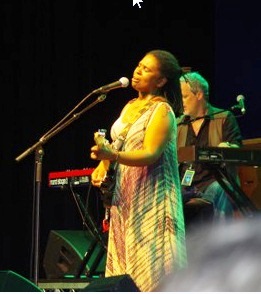 |
19:20 JAMBALAYA Ruthie Foster
Ruthie Foster – BluesFest 2011's feature artist, she was very warmly welcomed again by her very enthusiastic supporters. Grown up in gospel singer's family, trained pianist, self-taught guitar and banjo player (add to the mix farm girl, US Navy service woman, mum), she blends together several styles – gospel, blues and folk.
Her extraordinary voice, good lyrics and her captivating stage-image (simple and warm-hearted) make for a welcoming, enjoyable show. |
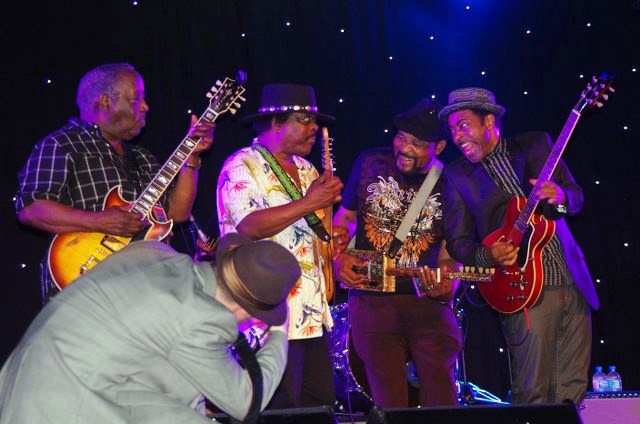 |
22:30 JUKE JOINT. Music Makers Relief Foundation
Music Makers Relief Foundation – if the MMRF is new to you, you've got to read the inspiring interview with its founders, Tim and Denise Duffy, in the April issue of Rhythms magazine. This year's performance was opened by Cool John Ferguson and Vasti Jackson. Left handed Cool John delivered guitar wizardry of a kind that I have not seen for years (if at all)! Cool John, in addition to performing own very interesting compositions, did not shy away from playing SRV's “Pride and Joy” and Hendrix's |
"Hey Joe".
A very strong tough voice coupled with off-the-chart strings – what more could you want?!
As to Vasti Jackson, there's no need for me to say anything; get online and enjoy one of his old numbers (thanks to youtube).
Saturday 4/4/2015
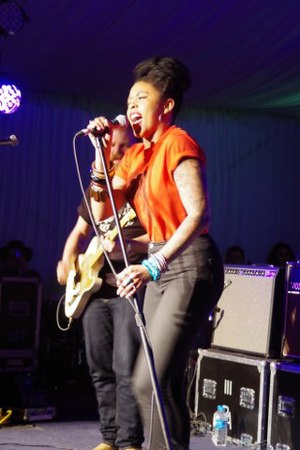 |  |
15:30 CROSSROADS Nikki Hill
Nikki Hill – my last year review of Nikki's BluesFest gigs finished with words 'this is the beginning of a new star. Watch her rising.' And she is rising indeed. This year, she had gigs on all three major stages, with heaps of professional photos taken, and multi-camera TV crews recording all her concerts…and her music keeps getting even better! While every saxophonist will tell you how hard it is to produce a proper growling sound, Nikki's voice does it with ease – lots of energy and dynamics.
|
And, not to miss, her very powerful, no-frills, straight to the point band.
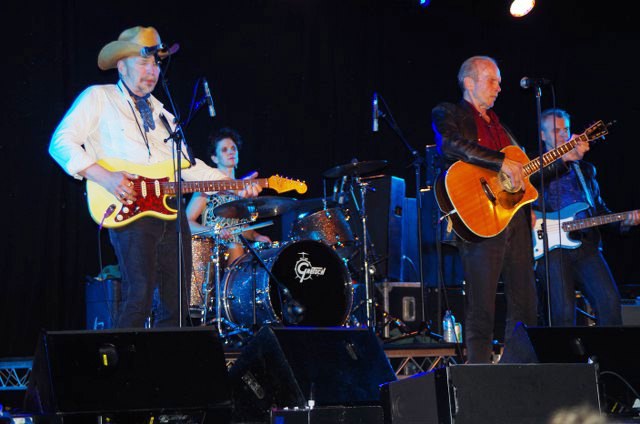 |
19:10 DELTA Dave Alvin and Phil Alvin and The Guilty Ones
Phil and Dave Alvin – two brothers who formed their first band, The Blasters, back in 1979. In 1986 David left the band and started a very successful solo career as a musician, poet, producer and movie actor. In 2000 his CD “Public Domain - Songs Form The Wild Land” won a Grammy award. Phil continued to be a front-man for The Blasters and released several solo albums as a singer and guitar and harmonica player (he also managed to get a Masters degree |
in Mathematics on the side). Since deciding to reunite in 2012 (after Phil's near death medical accident in Italy), they recorded the CD 'Common Ground' (Grammy nomination) – a selection of Big Bill Broonzy covers.
The BluesFest crowd really got it, especially the old ballad 'Key to the Highway'.
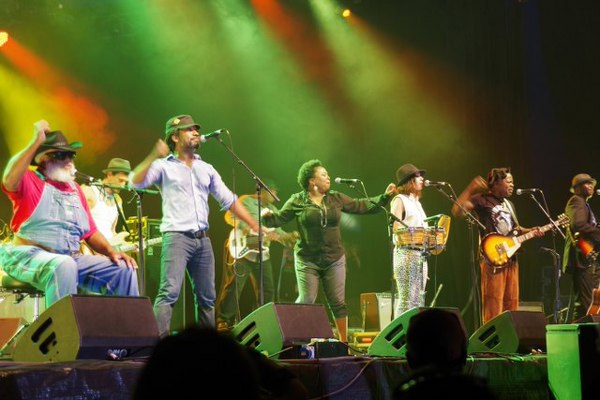 |
22:30 JAMBALAYA “Playing For Change”
Playing For Change – this gig was, as usual for PFC, very colourful both visually and musically. Nice to see Grand Pa Elliot again still shaking the tent's pillars with his low voice. PFC brings together music and musicians from different continents playing together for the great cause of changing world to the better. For me, the best part was the impromptu rendition of Honky-Tonk Blues played with only one acoustic guitar, two harps, two PFC singers and the great Keb' Mo'. |
No preparation, no music scores, just a raw blues created on the spot by great masters. Beautiful!
Sunday 5/4/2015
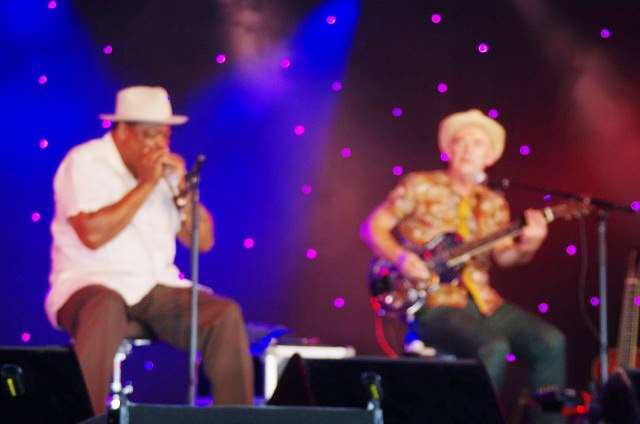 |
14:30 DELTA Phil Wiggings and Don Turner
Phil Wiggings and Don Turner – definitely the best gig. A “must see” of this year's BluesFest (forget all the megastars and TripleJ favourites). Real roots. A purely acoustic act with Australian Don Turner on resonator guitar and Washingtonian Phil Wiggings on Piedmont harmonica. They beautifully wove a deep, ethnographic and historical expedition into a colourful, virtuoso musical tapestry. Phil went about telling the long story of how, over the years, his African American family moved up from Alabama to Washington, |
singing and playing the songs of the times and the places they moved through. Very kind-hearted and charismatic, lots of jokes and amazing musical mastery. They started the gig with less than a hundred viewers (what would expect at 14:30?), but magnetically attracted a huge crowd after their first few songs!
 |
16:00 MOJO Beth Hart
Beth Hart – much rocky than bluesy this year. Included a very noticeable new ballad called “Tell her you belong to me” (here - make it loud!) from her last album “Better Than Home”. During the gig's closing song, Zeppelin's cult hit “Whole lotta love”, something very strange happened: all the baby-boomers in the crowd (including myself) seemed to get a bit teary. Maybe we'd just gotten something in our eye.
Or maybe it had something to do with Beth's "Lo-oo-o-ove" scream and the echoing, note-for-note, Page's explosive, |
generation-defining, guitar solo!
 |
18:30 CROSSROADS Angelique Kidjo
Angélique Kidjo – if the number of people recording performance on their mobiles is a measure of an artist's success and popularity, then this gig was the most popular one at this year's BluesFest. Very colourful outfits, lighting, African traditional movements, songs in different languages, beats – you felt as if you were at a festival somewhere in the middle of Africa, at a place where everyone knows each other and is glad to be sharing their good mood and vibes.
The majority of the songs presented this time were from the latest album, Eve, named after Angelique's mother as well as after the mythical “mother of all living”. |
 |
19:45 CROSSROADS Melbourne SKA Orchestra
Melbourne SKA orchestra – very-very entertaining, highest quality orchestral music and, again, total mayhem on the stage (at some point musicians where playing laying on the floor or jumping between the rows of chairs). The crowd was in a state of complete ecstasy. Euphoria! In one gig, band leader Nicki Bomba sent plastic collection containers out through the crowd to collect small change donations towards anti-malaria mosquito nets in Africa. It took just a few minutes for the crowd to return these containers, |
filled with several thousand dollars, back to the stage.
For Sydney-siders, visit here. I can't imagine how on earth it will be possible for them play in Opera House (the Opera House might well decide to go for a dip in the harbour during the gig). I'm definitely gonna go.
Monday 6/4/2015
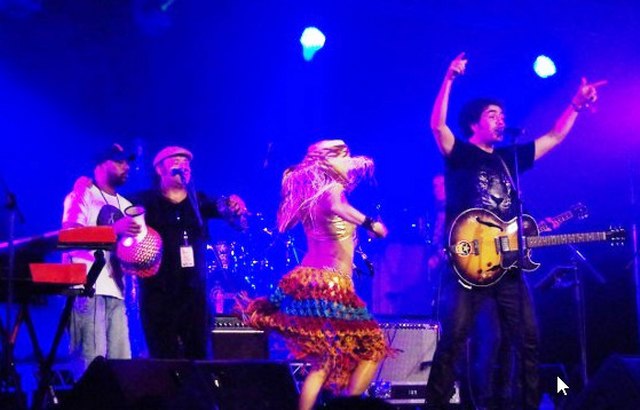 |
14:40 MOJO Watussi
Watussi – here is how the group describes itself: “lead by charismatic Columbian ex-pat, Oscar Jimenez, Watussi are a well-traveled troupe of Latino-tinged roots rockers”. A Sydney band, this year they added two amazing dancers: Sandra Lucas and Claudia Vidal. Hard to describe their style, movements and costumes. The Ancient American Indian (Peruvian?) mythology probably
comes to mind….It was a real treat for all senses – very fluid, original |
twists and turns of the human body against a backdrop of pulsing Latino music.
BUSKING STAGE
I cannot say much about the Busking Competition this year. For some reason, the Busking Stage was shut on Thursday and Friday. Unfortunately, the weather did not help either as the busking tent did not have cover for its listening crowd (this is definitely something that the organisers should look into).
And another thing – it would be nice to have a list of competitors and a schedule published, both, on the BluesFest website and on little leaflets.
Otherwise it is hard to know who’s performing at any given time and to plan how to spend your precious listening minutes. I didn’t have a chance to see all the buskers, but the most noticeable for me were:
A few other general observations:
- I'll repeat what I said in my last year report: “On the negative side, it looks like BluesFest has outgrown itself. It has become too big (area and crowd-wise)….” This year was not better. The enlargement of the JukeJoint stage didn't help.
- One more negative thing – the absence of BluesFest's Rhythm magazine this year (I think this was the first time this happened).
- Every year BluesFest widens its stylistic boundaries and, as usual, this has a positive and negative effects. On the positive side, it attracts a more diverse audience, more young people. But on the negative side it deviates more from Blues and Roots. I’m not suggesting that this is the wrong way to go, but still…
- Continuing my deep sociological observations about each year's favourite food stalls: the coffee shop (last year's champion) and the vegan food shop (champ from the year before that) both lost their appeal. This year, the Organic Donuts joint made a killing – they seemed to have 50 meter long queue there all the time (3-4 people in one row)…:-)
Some more names and photos – these artist definitely deserve your attention:
Marlon Williams and The Yarra Benders - "the impossible love child of Elvis, Roy Orbison and Townes Van Zandt".
Pokey LaFarge Band - "artfully dodgy ambassadors for old-time music, presenting and representing the glories of hot swing, early jazz and ragtime blues".
Keziah Jones – very(!) funky BluFunk (blues + Funk) from Lagos Nigeria.
The Rumjacks - Sydneysiders - "the five who have nothing to hide, who have no limit and there’s nothing to it but to make this music and make it loud, make it proud, add the extra energy and to hell with the consequences"
The Beautiful Girls - boys only band from Sydney.
|
by Vlad Gilbourd, April 2015
|
| Back to Index |
| 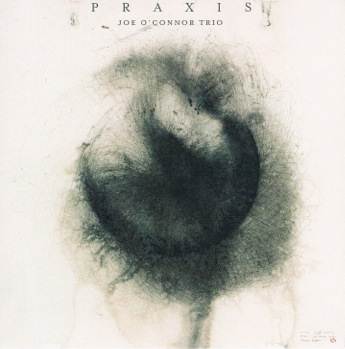 | Joe O’Connor Trio - Praxis (Independent)
|
This new piano trio debut album signals the arrival of a major new Australian talent. Melbourne pianist Joe O’Connor won the National Jazz Award at Wangaratta in 2013 and part of the prize was the offer of a recording deal with ABC Jazz and the resulting collection has now been released
His six originals here move through varying moods and styles, one moment flowing with evocative passages of lyricism, and then breaking into hyper-fast runs with James McLean’s drums occasionally extending, accentuating and punctuating. All of that happens in Chargrinning after an engaging theme of treble notes interspersed with short rests opens the piece and Marty Holoubek’s bass wanders into view
Maggot?begins with fast-moving bass and drums before the piano breaks in with a running theme that sounds cross-rhythmic, but then settles into speeding flights built on a series of descending chords; these passages could almost be a 21st century version of Art Tatum. An ethereal opening to Duane features sparse treble chords with bass notes from piano and acoustic bass, adding soft out of tempo brushes as the piece gradually gains momentum, and McLean switches to sticks as the piano work swells, pulses and ultimately fades to a conclusion
Piano, bass and drums all interweave skillfully and esoterically for the opening of Fractured Symmetry, with important spaces and staccato jabs and phrases
The question that arises from this most impressive debut album is whether or not O’Connor remains in Australia, or will he follow so many others to the US?
    
|
John McBeath
Previously published in The Australian March 2015 |
| Back to Index |
| 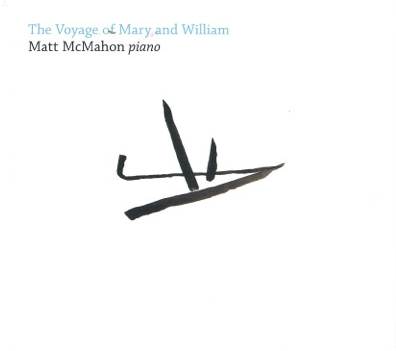 | Matt McMahon - The Voyage of Mary and William (PathsAndStreams Records)
|
Multi-award winning Sydney pianist Matt McMahon, although widely known as one of Australia’s foremost jazz pianists, has played in a bewildering variety of other genres over the years. He’s backed different vocalists from ballads to pop, explored Korean music and indigenous Australian pieces, recorded Arabic-style works with Joseph Tawadros, played flamenco with Bandaluzia, interpreted Peter Sculthorpe’s music with Phil Slater, composed and performed with electric viola da gamba in the Marais Project, featured Irish folk songs with his late brother Michael, participated in funk and soul bands, and much more
Sweeping aside questions about genre, in this, his first solo album McMahon observes that his wide-ranging musical experiences have left their mark on his conceptions in music dedicated to his Irish forebears, Mary and William, who came to Australia in 1847. Not that this music is about his ancestors’ experiences, but McMahon grew up surrounded by Irish music and notes those influence here, ‘underneath or behind the sounds.’
There is no theme or preordained idea in these twelve tracks, McMahon improvises various ideas, letting each sound follow the previous one in pieces that are movingly introspective, flowing easily from each section on to the next. Dense, yet pleasant harmonies are sometimes used in relaxed, descriptive sequences. The only fast-moving track Tempest Within, starts with rapid bass-end figures, increasing to quick treble roulades underpinned by staccato bass notes to end abruptly. The rest of the album is peaceful, relaxing, and at times sounding semi-classical, particularly in one dreamy example: Around the Cape
   
|
John McBeath
Previously published in The Australian March 2015 |
| Back to Index |
| 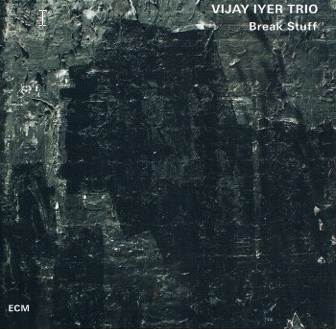 | Vijay Iyer Trio - Break Stuff (ECM/Fuse)
|
US pianist Vijay Iyer’s trio with bassist Stephan Crump and drummer Marcus Gilmore has been working together for eleven years and their musical symbiosis shows in this twelve track album featuring eight of Iyer’s originals. It’s the third release with various groups in just 11 months by the multi-award winning Iyer since moving to the ECM label. Explaining the title he says, ‘A break in music is still music: a span of time in which to act.’ And there’s plenty of action in the title track, from the piano’s quick rippling beginning pushed by Gilmore’s first beat of four emphasis to amplify Iyer’s chord jabs. After this hectic passage the tempo slows for Crump’s lyrical bass solo and the piano rolls serenely forward to then gather pace and return to the original fast thematic style – a break back
One of four non-originals is Work by Thelonius Monk, one of Iyer’s all-time heroes, and without a hint of emulation he achieves both a saluting recognition and a swinging trio interpretation. Billy Strayhorn’s final composition Blood Count, a deeply moving ballad, is beautifully interpreted by Iyer enlarging the minor harmonies and drifting expressively through its melancholy mood. Gilmore’s inspired drum solo, and his work throughout Coltrane’s Countdownare essential contributions to the piano’s speeding rendition and blast-off solo
This collection is a galvanizing illustration of contemporary jazz ideas by a piano trio of virtuosic ability and an almost telekinetic integration of each other’s performance and direction.
    
|
John McBeath
Previously published in The Australian March 2015 |
| Back to Index |
| 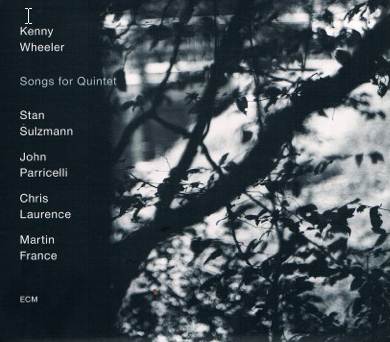 | Kenny Wheeler - Songs for Quintet (ECM/Fuse)
|
Trumpeter and flugelhornist Kenneth Vincent John Wheeler, better known as Kenny, was born in Toronto, Canada but moved to London in 1952, where he pursued a highly influential career until his death there in September 2014, aged 84. He was famously shy and often dismissive of his own work, referring to his compositions as ‘soppy romantic melodies with a bit of chaos.’ However many famous jazz greats played Wheeler’s compositions, including Johnny Dankworth’s all-star orchestra recording in 1968 of Wheeler’s suite Windmill Tilter, inspired by Don Quixote who appealed to the composer because ‘he seemed to be one of the great losers.’
Wheeler did not reach wide international recognition until the 1970s assisted greatly by his landmark 1975 ECM album with Keith Jarrett Gnu High. It was the first of 26 recordings he made for ECM, and overall Wheeler appeared on close to one hundred albums, appearing with such luminaries as Lee Konitz, Anthony Braxton, Dave Holland, Bill Frisell, Jan Garbarek, and Michael Brecker. During the seventies Wheeler also became involved with free improvisation playing with the Spontaneous Music Ensemble and Globe Unity Orchestra, and in 1977 formed the chamber jazz trio Azimuthwith pianist John Taylor and vocalist Norma Winstone
Sadly, Songs for Quintet recorded in December 2013 and released February 2015, is Wheeler’s last and he plays flugelhorn throughout with this group of long term recording associates: saxophonist Stan Sulzman first appeared with Wheeler on his 19-piece 1990 album Music for Large and Small Ensemble
Wheeler may no longer have been capable of his characteristic ultra-high register leaps but his pure tone of romantic melancholy remains, especially noticeable on the opener Seventy Six after guitarist John Paracelli’s quietly effective intro with Martin France’s delicate drumming. The tempo goes up for Jigsaw allowing ample solo space for flugelhorn and tenor sax as well as guitar and Chris Laurence’s double bass, all driven by France’s percussive punctuations
Sly Eyes opens with a marching-style drum before moving into a tango rhythm for Wheeler’s precise theme statement and Sulzman’s solo as horn and sax continue interchanging choruses. An all too brief 1076, at 2.40mins the shortest track, is an out of tempo, free-sounding piece well held together by France’s drumming continuum. There’s a bluesy origin underneath Old Time with a quiet sax and guitar chords opening gradually cranking up into a more energetic pulse, as Sulzman powers into a spirited solo and Wheeler arrives for a concluding duet and his own slowly quietening solo.
There was a lot more to Kenny Wheeler than his own self-effacing assessment as ‘someone who just takes pretty songs and joins them up’. We’re fortunate to have this final recording legacy showcasing his clear, relaxed and lyrical playing of understated grace that can stand as amongst his finest performances
   
|
John McBeath
Previously published in The Australian March 2015 |
| Back to Index |
|  | Tate Sheridan - Tate Sheridan (Independent)
|
Here’s the evidence that something other than politics can come out of Canberra and furthermore something of original high musical quality. Pianist Tate Sheridan has followed his 2014 debut album In Hiding, with saxophonist Calum Builder to introduce this newest release of his piano trio. Sheridan is a graduate of the ANU and as with the previous collection the self-titled album is funded by the Friends of the ANU School of Music. All eight tracks here are Sheridan originals and stylistically they vary from the fast-running opener, Please No Questions featuring a quick piano flow of changing ideas and a smart bass solo from James Luke, to the fragmented theme of Run Don’t Walk, and an ultra-slow, seriously profound piece, Onward Outward
There are occasional vague echoes of Oscar Peterson in Sheridan’s swinging solo on House Arrest but with the Canberran’s characteristic addition of unpredictable, yet interesting variations in direction. Lone Gunman is a seriously slow ballad with weighty passages of bowed bass, staccato chordal piano and a pounding beat. Another slower composition, Grace is a relaxed exploration of a pastoral theme with drummer Aidan Lowe using brushes to good effect and when the piano branches out there is a slightly soulful undercurrent, neatly investigated in the bass solo, followed by the piano building to a stately finale
Sheridan is a talented young composer and pianist destined for a role of national importance on the Australian jazz scene
   
|
John McBeath
Previously published in The Australian February 2015 |
| Back to Index |
| 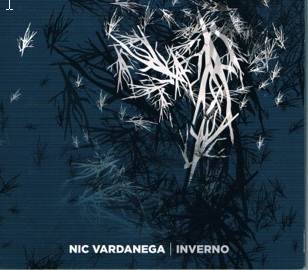 | Nic Vardanega Quartet - Inverno (Independent)
|
Sydney guitarist Nic Vardanega’s debut album has the right mood to portray its title, Inverno (winter). Vardanega’s eight originals are redolent of wintry vistas viewed from a warm room: the music well conveys the austerity of a winter landscape observed from a comfortable location. The opener Revelation is a good introduction as Vardanega’s guitar outlines a theme which manages to be somber but not despondent. The atmosphere is assisted greatly by Steve Barry’s piano supplying attractive chords to the guitar’s melody line and a descriptive, running solo as James Waples provides thoughtful drum work with David Groves’s underpinning on acoustic bass
Vardanega’s solos are inventive and they maintain a consistent narrative that preserves the motif in a quietly eloquent way. In fact quietness and restraint are often keynotes in these eight numbers. Asolo, – named after a small North Italian town – is played in a bossa rhythm, and after tasteful solos from guitar and piano, features a mobile bass solo re-introducing the theme to conclude. The aptly titled final track, Closure has passages of pleasing exchanges be-tween piano and guitar, while December evokes a European winter; coldness depicted without being cold-blooded, and it swings in a subdued manner. Fittingly five of these songs, including Asolo and December are in minor keys, as is Standstill an ultra-slow tempo piece, which uses small amounts of guitar reverb to good effect
This album launches Vardanega as an accomplished leader, guitarist and composer capable of taking a subject and illustrating it musically with skill and originality
   
|
John McBeath
Previously published in The Australian February 2015 |
| Back to Index |
| 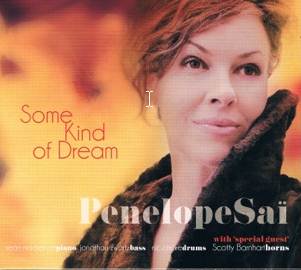 | Penelope Sai - Some Kind of Dream (Independent/Planet)
|
Vocalist Penelope Sai’s third album, following Evening Falls in 2010, and Siana in 2012, utilises the same trio from the latter, adding Scotty Barnham guesting on trumpet. Another similarity is Sai’s compositional contribution to the six originals of its twelve tracks. Now based in the Blue Mountains outside Sydney, Sai spent many years performing in Paris and sings with a very attractive voice in a Parisian/jazz vocal style: an after midnight, soft intimacy with a sometimes slightly over-emphasised theatricality
The opener is the song Chet Baker made his own, Let’s Get Lost taken at a slightly slower tempo than the original, and none the worse for that, with suitable solos from both trumpet and pianist Sean MacKenzie, who arranged the album. Of the originals, the title track works well, capturing a midnight reverie feeling in a sophisticated musical frame, while Neon Nights, slightly quicker, uses fast word groupings effectively, and Ave Guynemer swings delicately thanks in part to drummer Nic Cecire
Swing era standard Blue Champagne is given a suitably bluesy treatment, and I Guess I’ll Have to Change My Plans is interpreted with originality and features a sympathetic bass solo from Jonathan Zwartz, who provides faultless foundations on every song. There’s another of Zwartz’s solos on Spring Will Be a Little Late This Year, which displays Sai’s expressive ability in a song typical of the album’s mood of romantic and nostalgic ballads
This album doesn’t set out to be a groundbreaking vocal collection, but achieves an engagingly warm atmosphere with Sai’s original vocal stylings and some fine arrangements
   
|
John McBeath
Previously published in The Australian February 2015 |
| Back to Index |
|  | Marc Hannaford - Can You See With Two Sets of Eyes (Independent. Digital only)
|
If by chance you were wondering what an advanced, contemporary, improvised, virtuosic music performance might sound like, a decade or more into the future, this album provides a definite possibility. Multi-award winning ex-Melbourne pianist Marc Hannaford, currently studying for a PhD at Columbia University New York, has assembled two US musicians – tenor saxophonist Ellery Eskelin, and drummer Tom Rainey – with his long-term Australian associate, trumpeter Scott Tinkler, to record six extended improvised exchanges
Anything that might be said about a particular track to illustrate the overall approach on this album – funded by the Freedman Fellowship and The Music Council of Australia – is likely to be contradicted on another track. For example the sixteen minute opener Murmur uses Rainey’s drum kit throughout but not in the usual rhythmic style; a slow tempo is inferred, not stated, in a completely unfettered way, whereas Spechsinder begins with elements of rhythmic post-bop and features a lift-off trumpet and drums passage that pulses quickly, swinging madly before piano and tenor arrive with their own spacey contributions as tempo becomes irrelevant and piano and drums swerve and speed, then slow and speed again to an abrupt conclusion
Framed starts with a comprehensive tenor cadenza and added percussion punctuation leading into a fast running, piano sequence with big, stabbing atonal chords
This is a collection of powerful and exploratory playing, highly original and improvised freely and energetically. It’s music that could perhaps be imagined if Albert Ayler sat in on a session of free expression with John Cage and Cecil Taylor
    
|
John McBeath
Previously published in The Australian February 2015 |
| Back to Index |
|
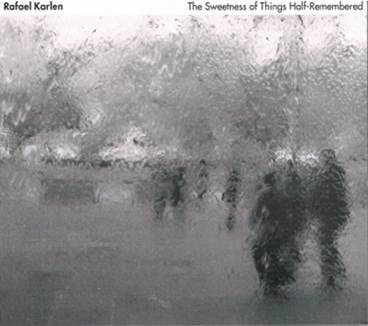 |
Rafael Karlen - The Sweetness of Things Half Remembered (Pinnacles Music)
|
This unusual album is a Brisbane production, recorded at the University of Queensland, featuring the music of saxophonist Rafael Karlen. It’s a blend of elements of jazz and contemporary classical music: what used to be called ‘crossover’. In addition to Karlen’s tenor sax the group includes his long-term pianist Steve Newcomb plus the Rosenberg String Quartet. Much of the material here was composed as part of Karlen’s Masters Degree at the University of York, England. The mood throughout is languid and contemplative with the classical aspects dominant. Strictly it’s not a ‘jazz’ album, more a Western art music collection
The opener If Not Now, When? begins with a delicate cello ostinato, soon joined by the other strings in a gentle, rolling theme, smoothing an entrance for Karlen’s tenor sax as the piano adds embellishments. It’s difficult to ascertain how much of these pieces is composed and which passages are improvised, but a good deal of the tenor sax solo in the opener could well be improvised, albeit along classical rather than jazz lines
Bounces Nicely certainly does that: after a pizzicato intro the tenor springs in with a solo that’s an impressive mix of classical phrases with muted jazz references. The title track portrays its theme very sensitively with the tenor floating over piano and strings in a nostalgic mix of romance and memory
The playing in this collection is of a very high standard and the arrangements achieve Karlen’s stated aims of contrast, coherence and interest. This is perfect music for a quietly lethargic and introspective Sunday afternoon
   
|
John McBeath
Previously published in The Australian January 2015 |
| Back to Index |
| 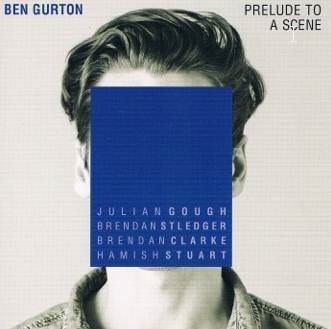 | Ben Gurton Quintet - Prelude to a Scene (MIR Creation)
|
Featuring some of Sydney’s foremost jazz players, this debut release for a new label, is the first Australian production in high resolution DXD format. The technique used minimal amounts of compression or equalizing, and reverb at 352kz sampling rate and 24-bit word size. The recording quality obtained by renowned engineer Ross A’Hern is certainly outstanding, and puts the listener at the centre of the ensemble by having all the musicians performing together around a main stereo pair of microphones
Leader Ben Gurton, composer and trombonist, has worked behind the scenes with such artists as The Cinematic Orchestra and Maria Schneider, but this is his first jazz release. The notes say the music is inspired by cool jazz, film music, and European instrumentals, but the emphasis – as the title implies ¬– tends towards a film soundtrack style of evocative narrative. This is particularly evident in A Journeywith Gurton’s trombone sounding relaxed and pastoral over Brendan St Leger’s piano chords and ripples
Languidly smart interplay between piano and Brendan Clarke’s bass is a feature of Forwards if Not Backwards, and the leader contributes a wake-up trombone solo in an otherwise doleful Note to Self. There is more of a jump feel to The Good Grind pushed along by Hamish Stuart’s deep-end drums and a tenor solo by Julian Gough who delivers a satisfying and thoughtful passage in Seeing More
Overall this high quality recording’s mood is dreamy, quiet and pensive in an undemanding cinematic way with most of the lead work carried by Gurton’s trombone
   
|
John McBeath
Previously published in The Australian January 2015 |
| Back to Index |
| 
| Josh Kyle and Sam Keevers - Songs of Friends (Independent)
|
Now that nearly all of the standards have been recorded by just about everybody, finding new material is a constant problem for jazz vocalists. Young Melbourne-based vocalist Josh Kyle has overcome that difficulty by recording seven songs, all written by various friends
It’s appropriate that the opener Simple Pleasures was composed by Kyle’s sole accompanist on the album, pianist Sam Keevers, a consummate player and one very experienced at accompanying vocalists. The song begins in a languid tempo with several quick phrases in Kyle’s high alto ending in long, held notes moving into a repeated sequence in harmony with the piano, introducing Keevers’s solo. There is a pleasantly satisfying sequence of softly descending chords midway here. A second piece by Keevers, Ballad of The Cranes is also a slower ballad utilising the vocalist’s ability to hold lengthy unwavering notes
More of a post-bop feel is evident in Sean Coffin’s piece, All The Reasons, one of three in the collection by the Sydney saxophonist. It’s taken at a quicker tempo and each of the vocal passages ends in a repeated scat phrase. Keevers’s solo punches out the essence of this fast-running number
Brisbane vocalist Kristin Berardi has contributed One Moment Please, a lovely slow ballad of an involving melody line and substantial harmonies, movingly interpreted by both vocalist and pianist
This collection is a true duo performance where the piano is not just a background but has a role as equally important as the vocalist, and the two work together with a rare musical understanding of each other’s contribution
   
|
John McBeath
Previously published in The Australian January 2015 |
| Back to Index |
|
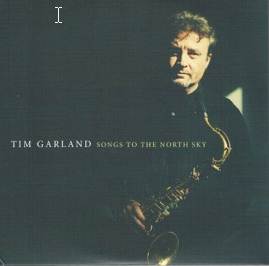 |
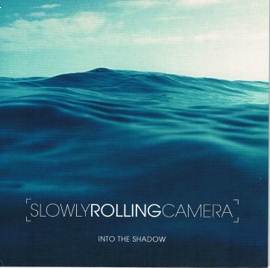 |

|
Tim Garland - Songs to the North Sky (Edition Records)
|
Slowly Rolling Camera - Into the Shadow (Edition Records)
|
Verneri Pohjola - Bullhorn (Edition Records/Planet)
|
   
|
   
|
   
|
|
Edition Records is a specialist UK label, established in 2008 by pianist/composer Dave Stapleton, and based in Hungerford, Berkshire. With a growing roster of artists in Jazz, Classical and Electronic music the label has been compared by The Guardian newspaper with the famous ECM Records, having ‘. . . a similar sixth sense for emerging innovators.’ Edition’s website displays over fifty albums and is currently releasing these new recordingsOf interest to jazz fans is UK saxophonist Tim Garland’s double CD Songs To The North Sky, the first disc of which is by his expandable trio Lighthouse. Pianist Gwilym Simcock, a standout from the 2012 collection is absent here, but three different players individually supply inventive keyboards: Jason Rebello, John Turville, and Geoffrey Keezer. Long-term associate, drummer Asaf Sirkis with his custom percussion kit of North African and Middle Eastern extraction contributes importantly on both discs. Guitarist Ant Law appears on four tracks, soloing well on Yes To This followed by Turville’s incisive piano leading into Garland’s thematic finale
Disc two, utilising the Royal Northern Sinfonia Strings, begins in a more pastoral vein and has Garland improvising strongly in a romantic mode. The second disc also has some virtuosic bass work from the New York based John Patitucci, often as a continuum between some of the fifteen tracks. This is a descriptive mix of symphonic arrangements with Garland’s narrative lead and his interpretative swinging, jazz-flavoured solos on soprano or tenor sax
The evocatively named group Slowly Rolling Camera features vocalist Dionne Bennett, along with the label’s founder Stapleton on fender Rhodes and synths, plus drummer Elliot Bennett and electronics by Deri Roberts. The four original tracks are electronic impressionist soundscapes using orchestral sweeps and additional instruments provided by another twelve musicians. The dense arrangements, topped by Bennett’s often soul-infused vocals – at times reminiscent of Tina Turner – owe something to the UK group Cinematic Orchestra, with a similar pop culture derivation
Another of Edition’s new releases is Bullhorn a recording of a quartet from Finland playing compositions by the leader, trumpeter Verneri Pohjola. The style is contemporary, lyrical Euro-jazz and several guest artists add to the quartet of trumpet, piano, bass and drums. One of these is Jussi Kannaste on tenor sax who appears on Girls of Costa Rica to bulk out ensemble work and provide a dynamic solo. Pohjola’s trumpet is fluidly melodic and constantly inventive throughout the album and Aki Rissanen on piano is an excellent accompanist supplying well-placed substantial chords and interweaving phrases
These new albums from Edition help to demonstrate the company’s stated ideal of sharing world-class creativity with music lovers globally, one person at a time
|
John McBeath
Previously published in The Australian January 2015 |
| Back to Index |
|
Uncompromising Expression – Blue Note
By Richard Havers
Thames & Hudson, 400pp, $95
This official history commemorates the 75th anniversary of the famous US jazz record label Blue Note and qualifies as a finely produced coffee table volume. It will need a sturdy table though; it weighs over 2kgs.
Richard Havers tackles the encyclopaedic task with enthusiasm and authority, although the writing jumps around chronologically. Blue Note’s recordings range from boogie-woogie piano and the swing of the 1930s through bebop, funk and fusion, to the label’s eclectic current releases. The epoch is portrayed in images including historical photographs, reviews, program notes, press releases, album covers, and Havers’s narrative.
Blue Note’s founder Alfred Lion came from a cultivated Jewish background in Berlin first hearing jazz as a teenager in 1924 by an African-American band. During Hitler’s rise in the 1930s black musicians, Jewish musicians, and entarte musik –‘degenerate music’ otherwise known as jazz, were banned. Lion fled Germany arriving in New York in 1936.
Havers describes New York’s famous thriving venues and the musicians like Duke Ellington, Tommy Dorsey, Louis Armstrong, Benny Goodman, and a host of others all regularly broadcasting on radio.
Pianists Meade ‘Lux’ Lewis and Albert Ammons were appearing at a new venue that had no colour bar. Named Café Society, it opened with the slogan: ‘The wrong place for the right people.’ By January 1939 Lion had saved enough to afford his first recording session and offered to record Lewis and Ammons for his new label, and Blue Note was born. The pair specialised in the immensely popular boogie-woogie piano, a twelve bar blues with a consistent, rhythmic bass pattern. Lion booked a studio and the two pianists completed nineteen takes, including Ammons’s iconic Boogie Woogie Stomp. Two double-sided 12 inch 78’s were released in March.
Needing finance Lion enlisted two writers from the Café Society crowd, Max Margulis and Emanuel Eisenberg naming them as ‘sponsors’ of Blue Note recordings one and two (BN 1 and BN 2). Sculptor Martin Craig, designed the first Blue Note label from Lion’s brief: ‘Make me something modern.’
Five weeks later Lion recorded BN 3, BN 4, and BN 5 – traditional blues and swing – by the Port of Harlem Jazzmen. On clarinet was Sydney Bechet who recorded a solo version of Summertime, released on BN 6, which became a pivotal moment. It was a beautiful rendition destined to be the label’s first hit, selling 30 copies per day in one record shop alone. Pianist Earl ‘Fatha’ Hines cut two high quality BN solos, further enhancing the label’s growing reputation.
An old friend – photographer Francis Wolff – fled Berlin for New York and began assisting Lion. There were only five more sessions before Lion was called up by the US army in 1942. Blue Note went into hibernation. Discharged in 1943 Lion opened a new Manhattan office where both he and Wolff worked full time.
Throughout 1943 and early 1944 various groups were recorded: pianist James P. Johnson, clarinetist Edmond Hall’s Quintet and traditional pianist Art Hodes with the Chicagoans. In July of 1944 the label moved towards modernity with saxophonist Ike Quebec who brought new ideas to the swing format. For the next two years there was more Art Hodes and Sidney Bechet.
By 1947 bebop was on the rise and male vocalist Babs Gonzales with a group featuring Tadd Dameron on piano, recorded Oop-Pop-A-Da for Blue Note, and it became a bop standard. Lion met pianist Thelonious Monk in 1947 who, aged 30, made his debut recordings for Blue Note and as Havers says: ‘. . . jazz would never be the same again.’ In the first of Monk’s sessions was 28 year old drummer Art Blakey who would later become synonymous with Blue Note.
Monk’s first release did not sell well, his second disc, Round About Midnight did better, and between 1947 and 1952 Monk recorded over a third of his compositions for Blue Note. Lion recorded certain artists whether they sold or not, stating that his company was not primarily about making money, but about quality.
Blue Note’s greatest period from the mid-fifties to the mid-sixties was notable for its artistic album covers – now on LPs – using photography by Wolff and designs by Reid Miles. Superb recording quality was provided by Rudy Van Gelder. During this era the recorded artists make a legendary list. Art Blakey, Bud Powell, Sonny Rollins, Wynton Kelly, Miles Davis, Horace Silver, Clifford Brown, Herbie Hancock, Jimmy Smith, Freddie Hubbard, Wayne Shorter, Ornette Coleman, Chick Corea, Eric Dolphy and Max Roach are just some of the standouts. Six pages are devoted to saxophonist John Coltrane’s only Blue Note album, Blue Train from 1957, regarded as the most outstanding of his early work
.
Alfred Lion suffered a heart attack in 1966 and sold his label to Liberty Records; then United Artists bought out Liberty in 1968. Wolff continued working in the business until he died in 1971 but by then Blue Note was in decline and in 1979 it seemed the last recording was released. However the label made a comeback in 1985 but with varied results. The company functions today with new artists and is re-issuing 100 Blue Note titles commemorating its 75th anniversary.
This is a comprehensive reference book of historical importance, recording and detailing, in often stunning illustrations and explanatory text, the organisers, music and artists who were part of one of the world’s most influential jazz labels.
|
John McBeath
Previously published in The Australian January 2015 |
| Back to Index |
|
| Archives 2015 |
| Archives 2014 |
| Archives 2013 |
| Archives 2012 |
| Archives 2011 |
| Archives 2002-2010 |
|















































































